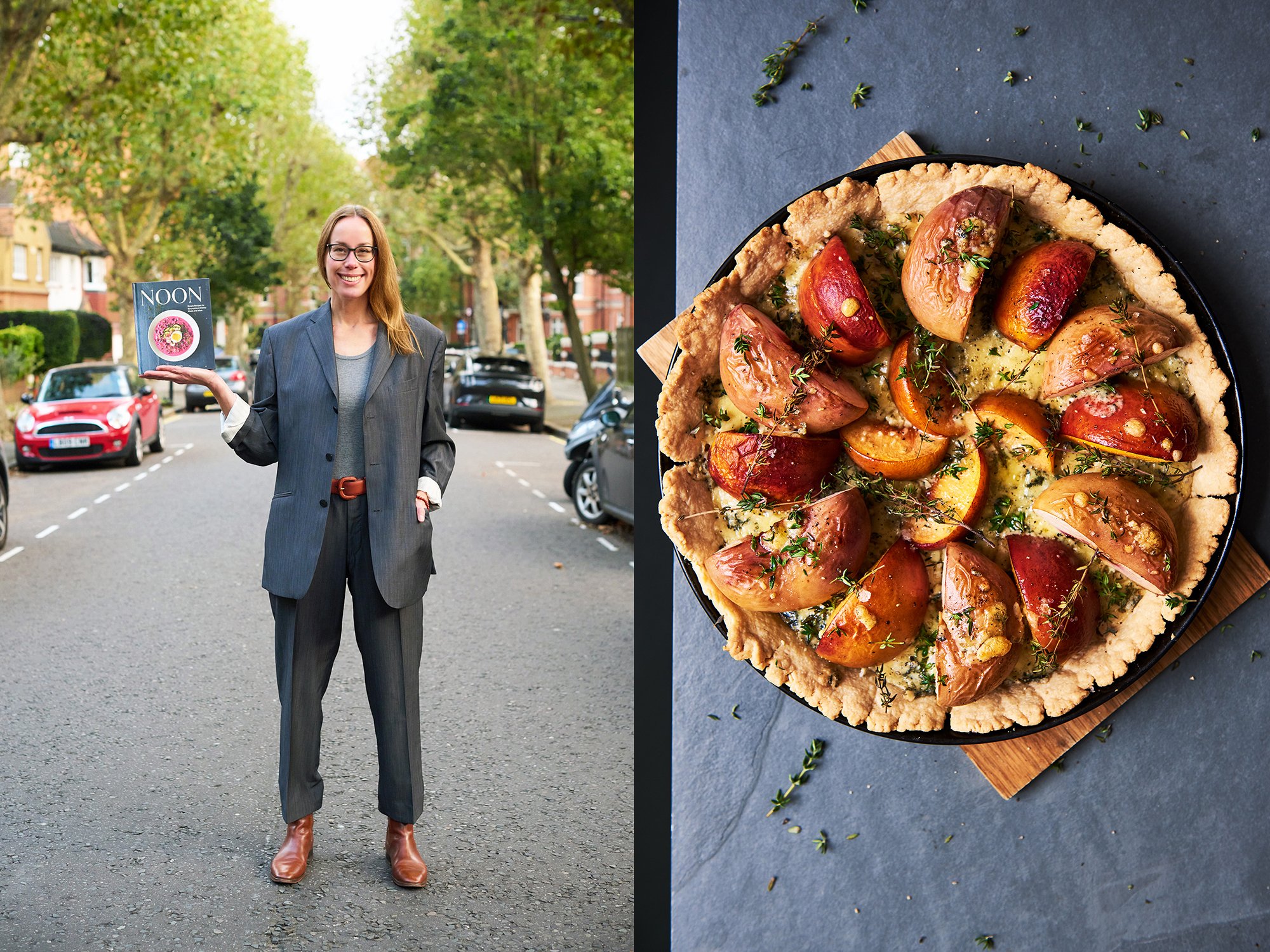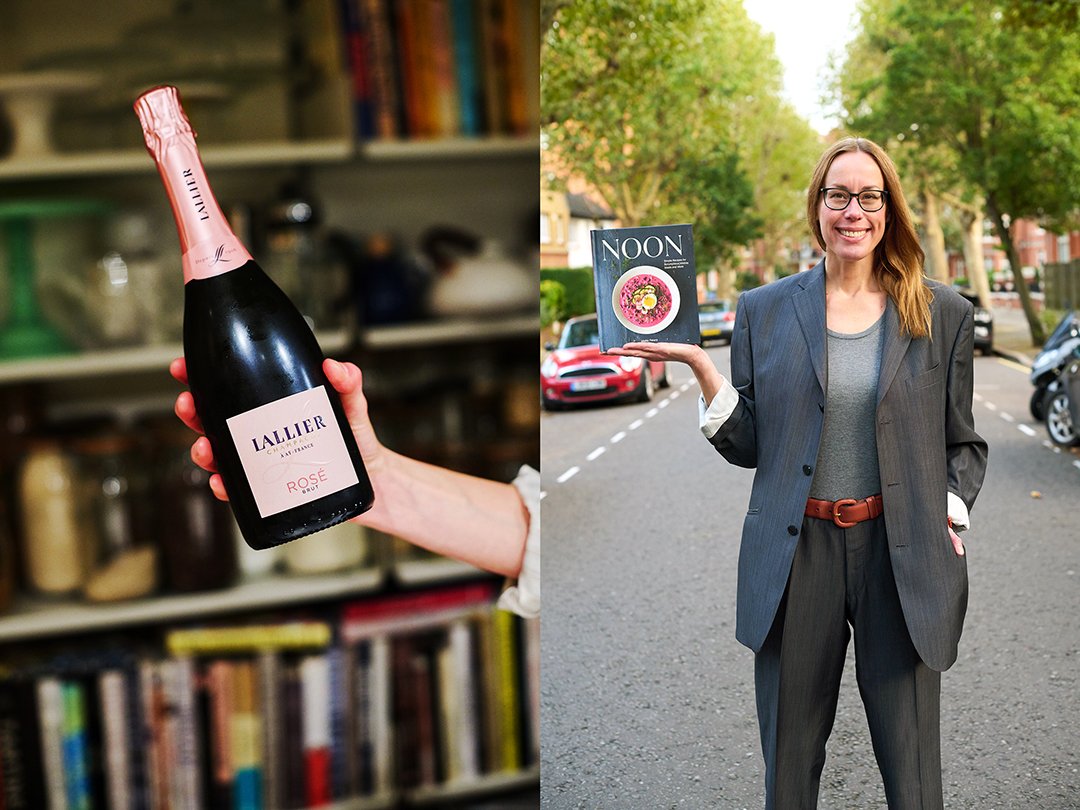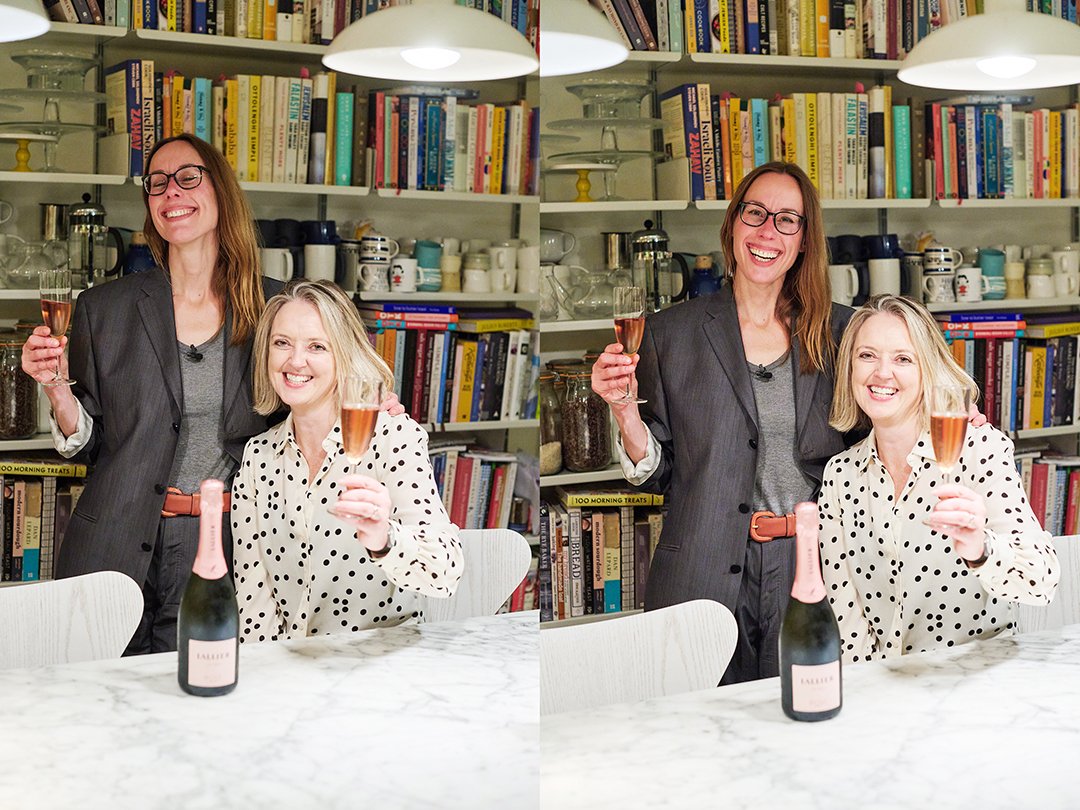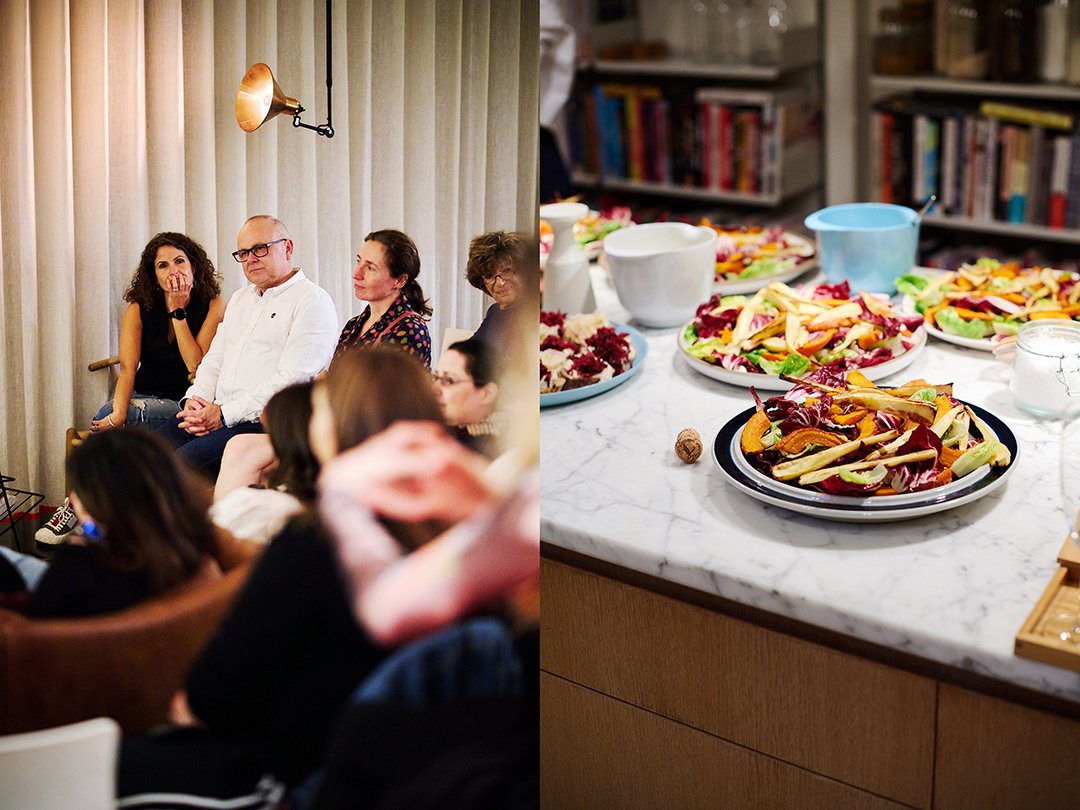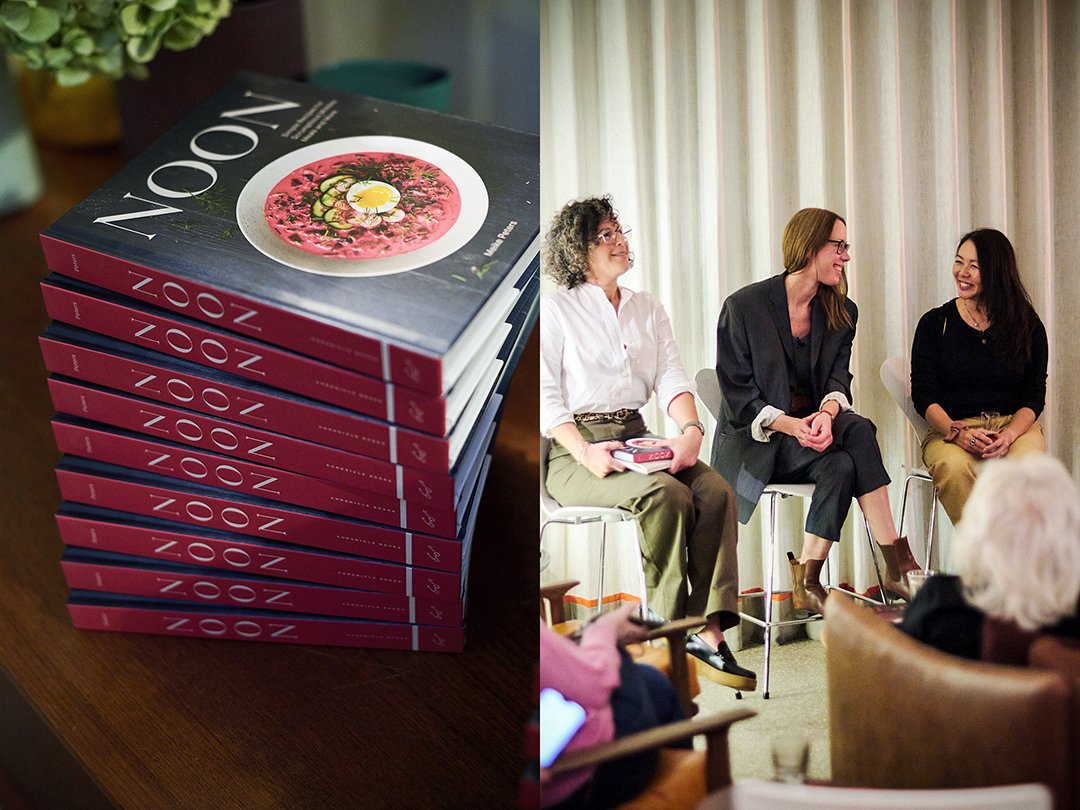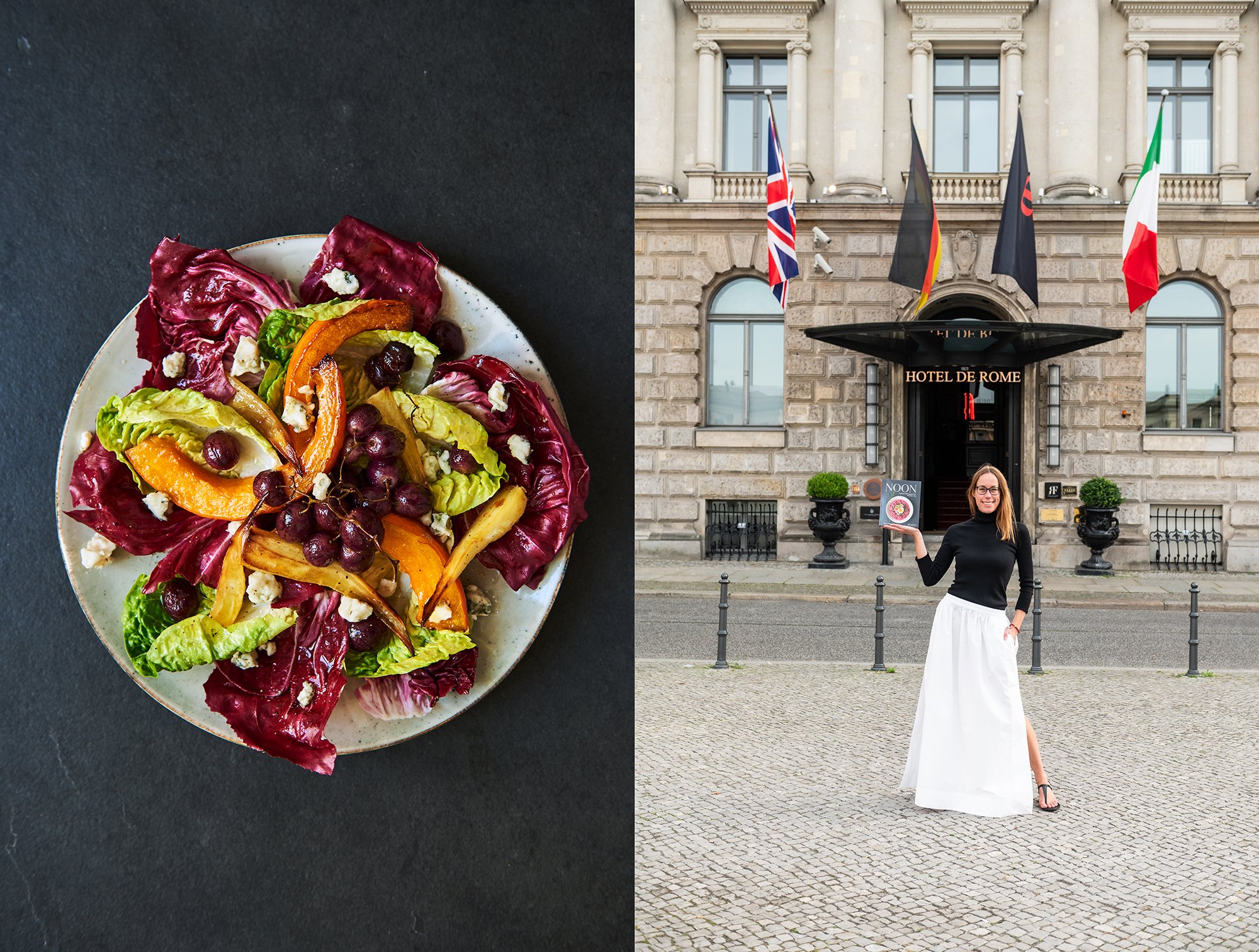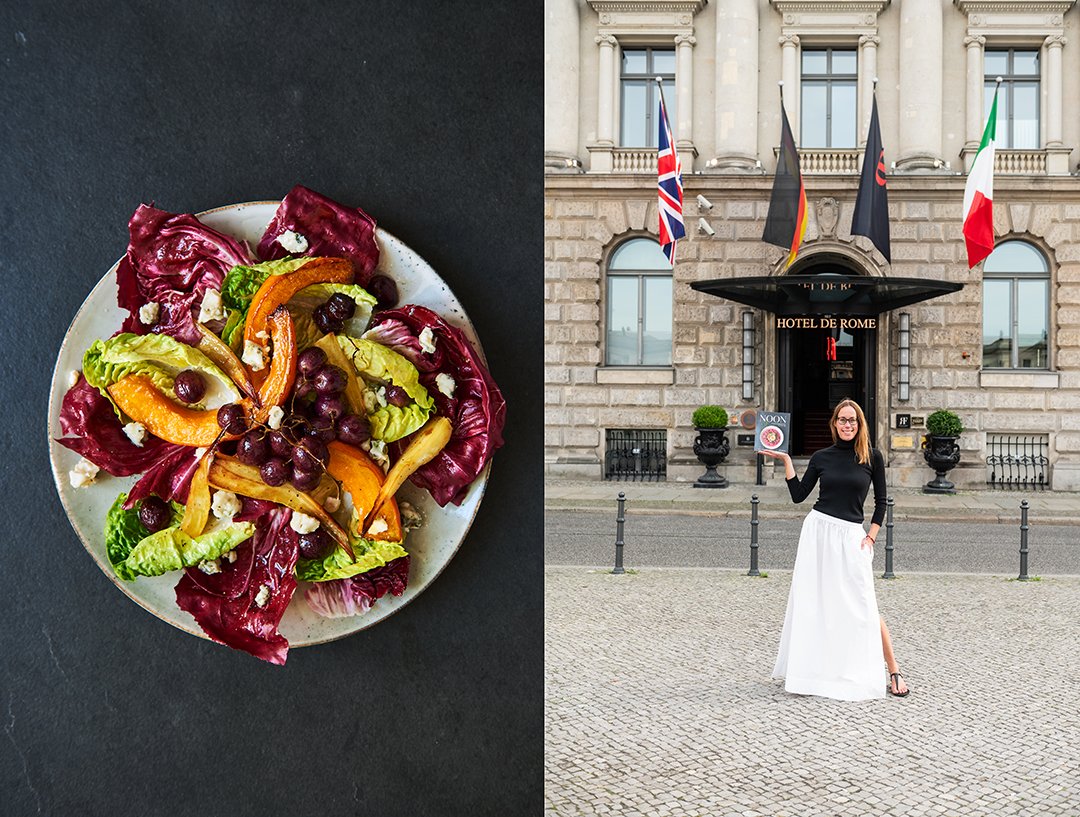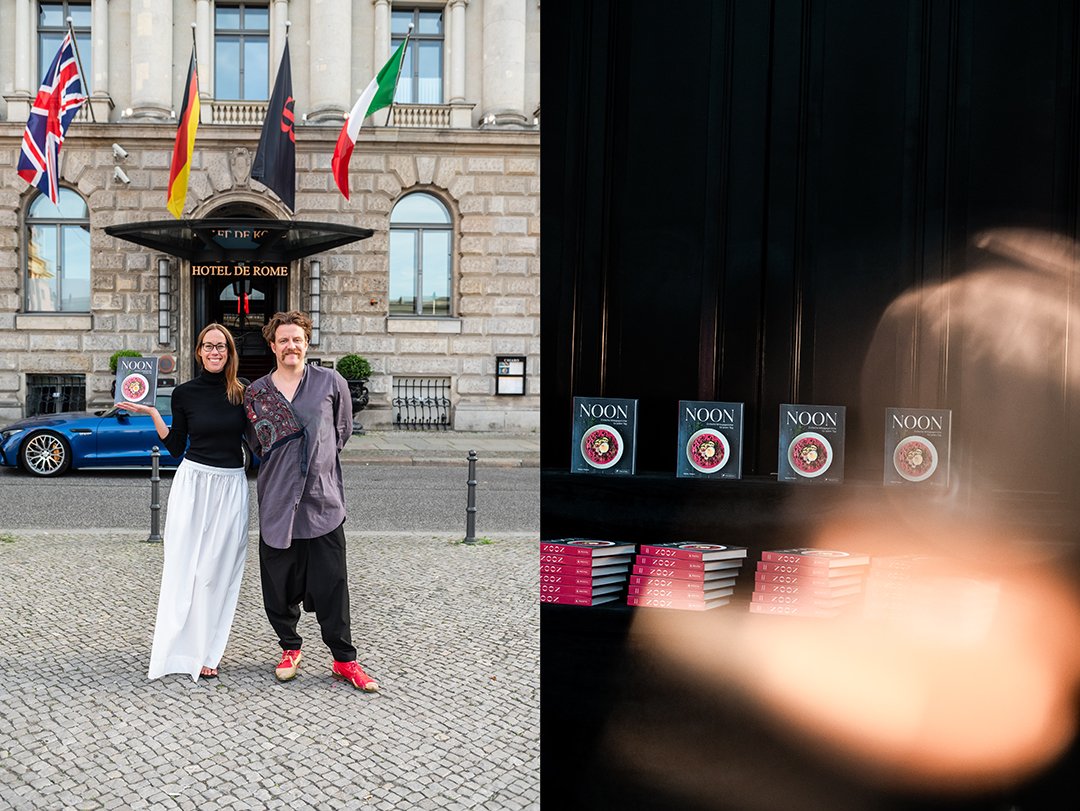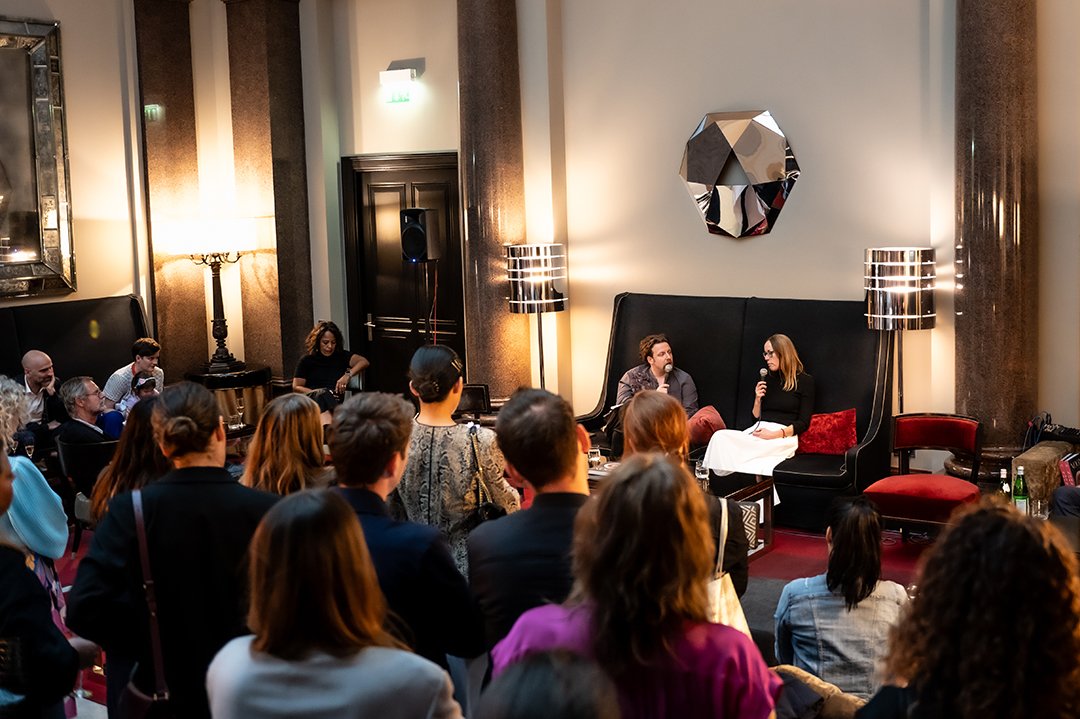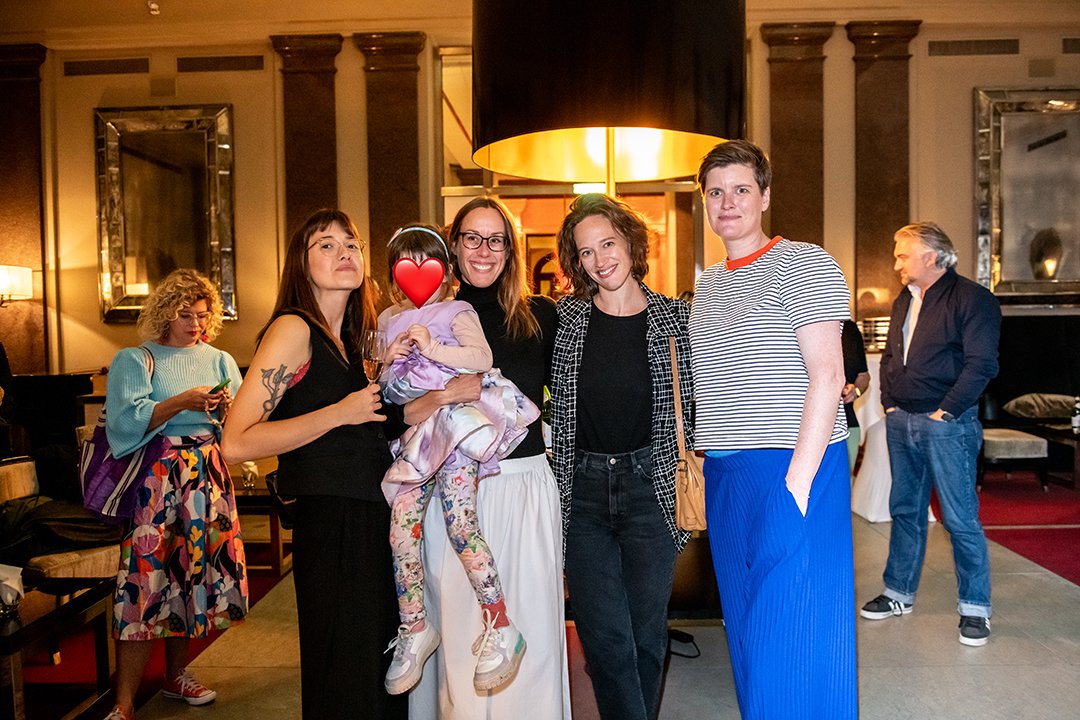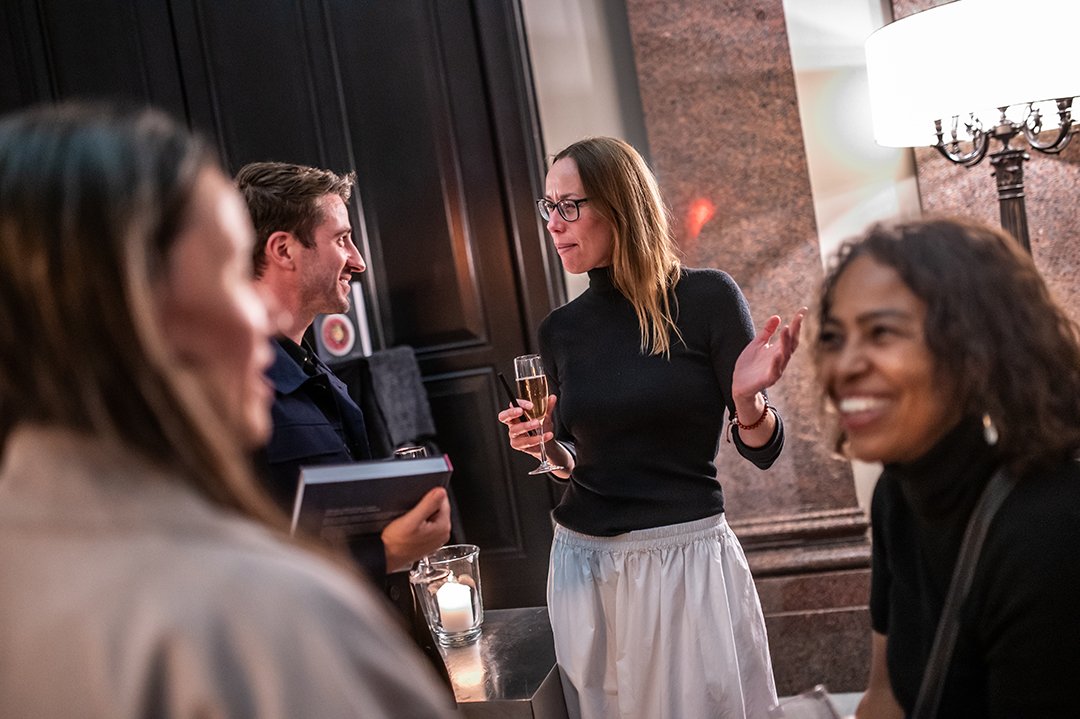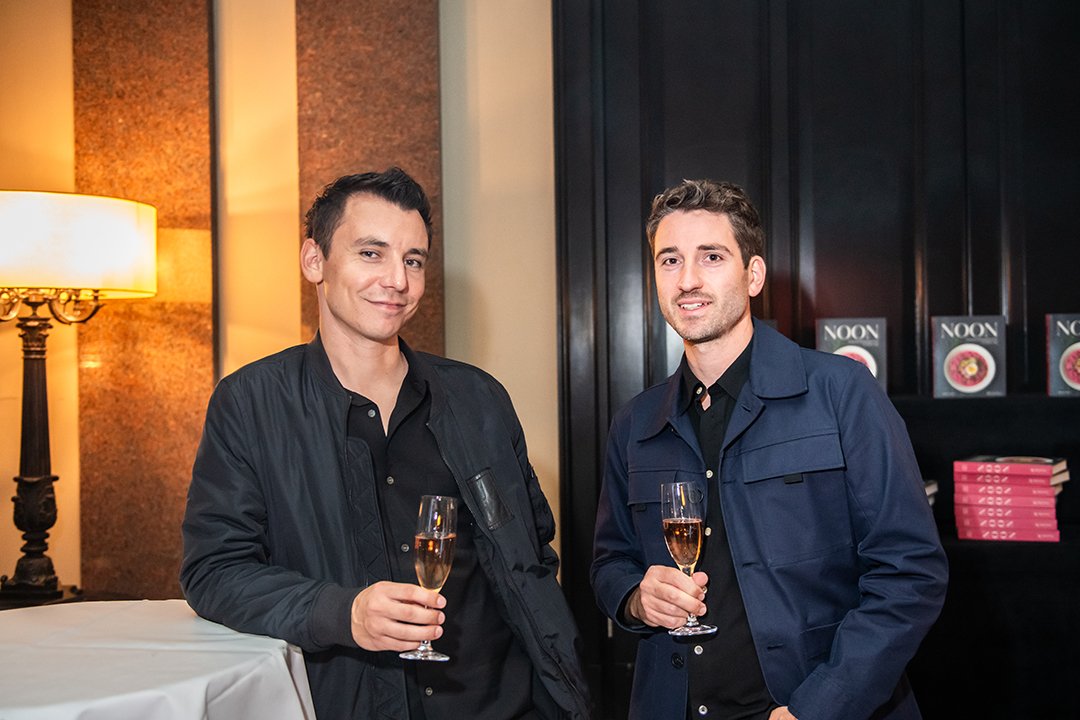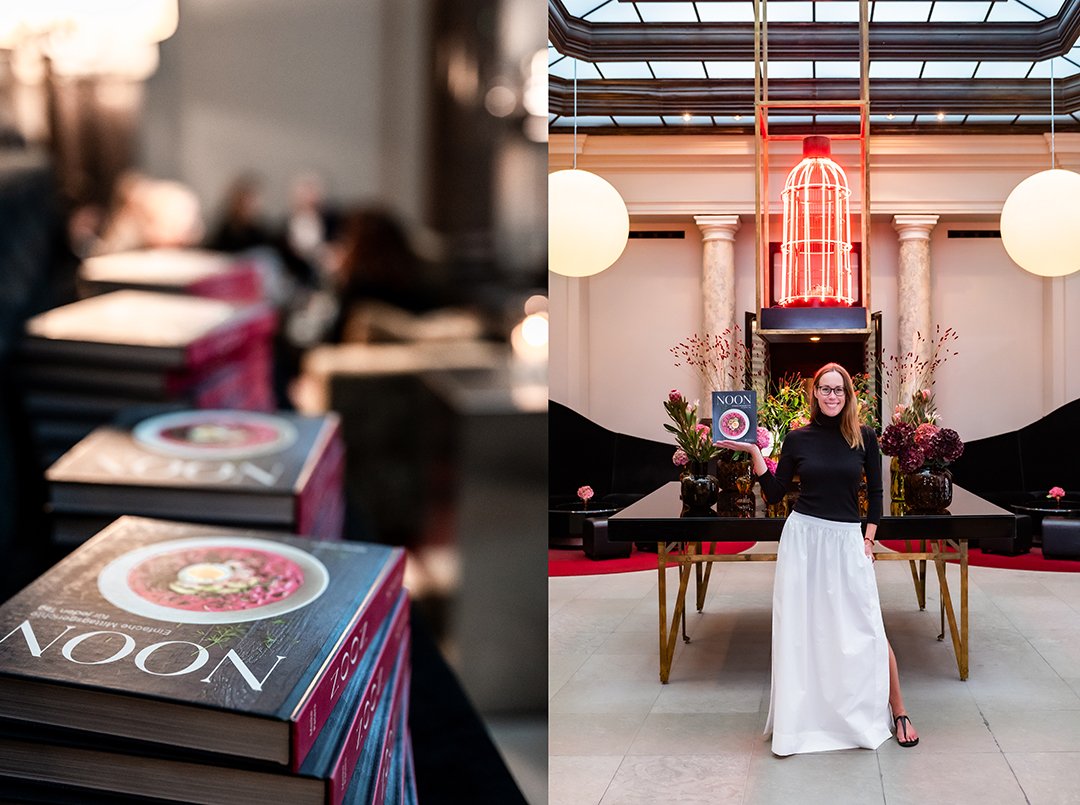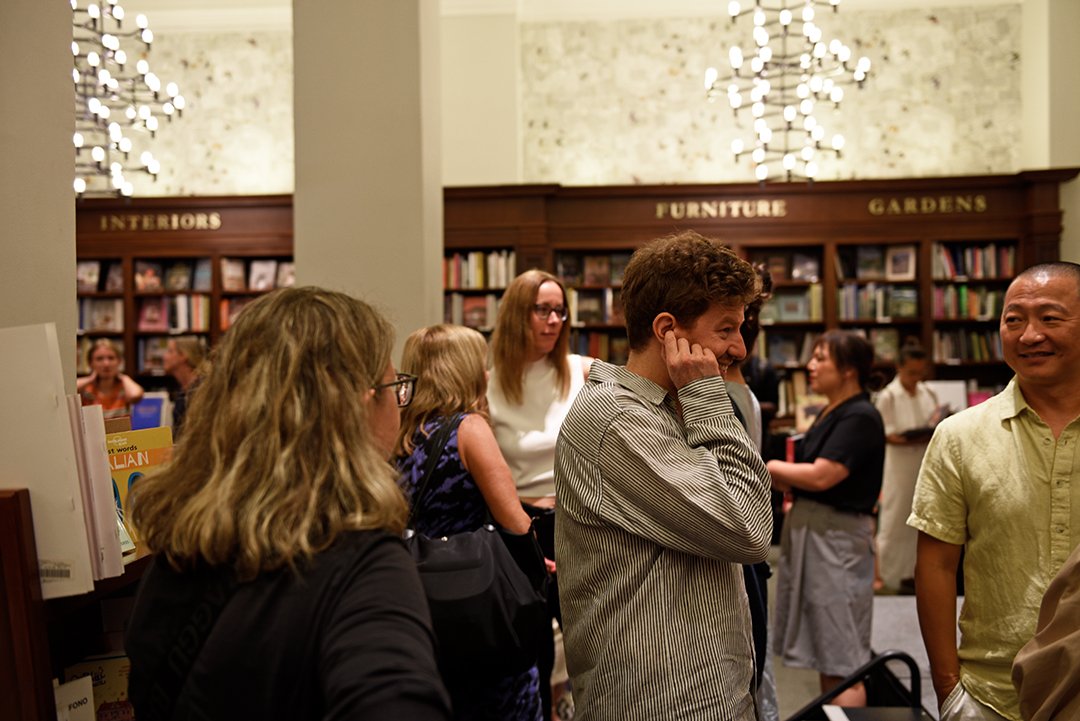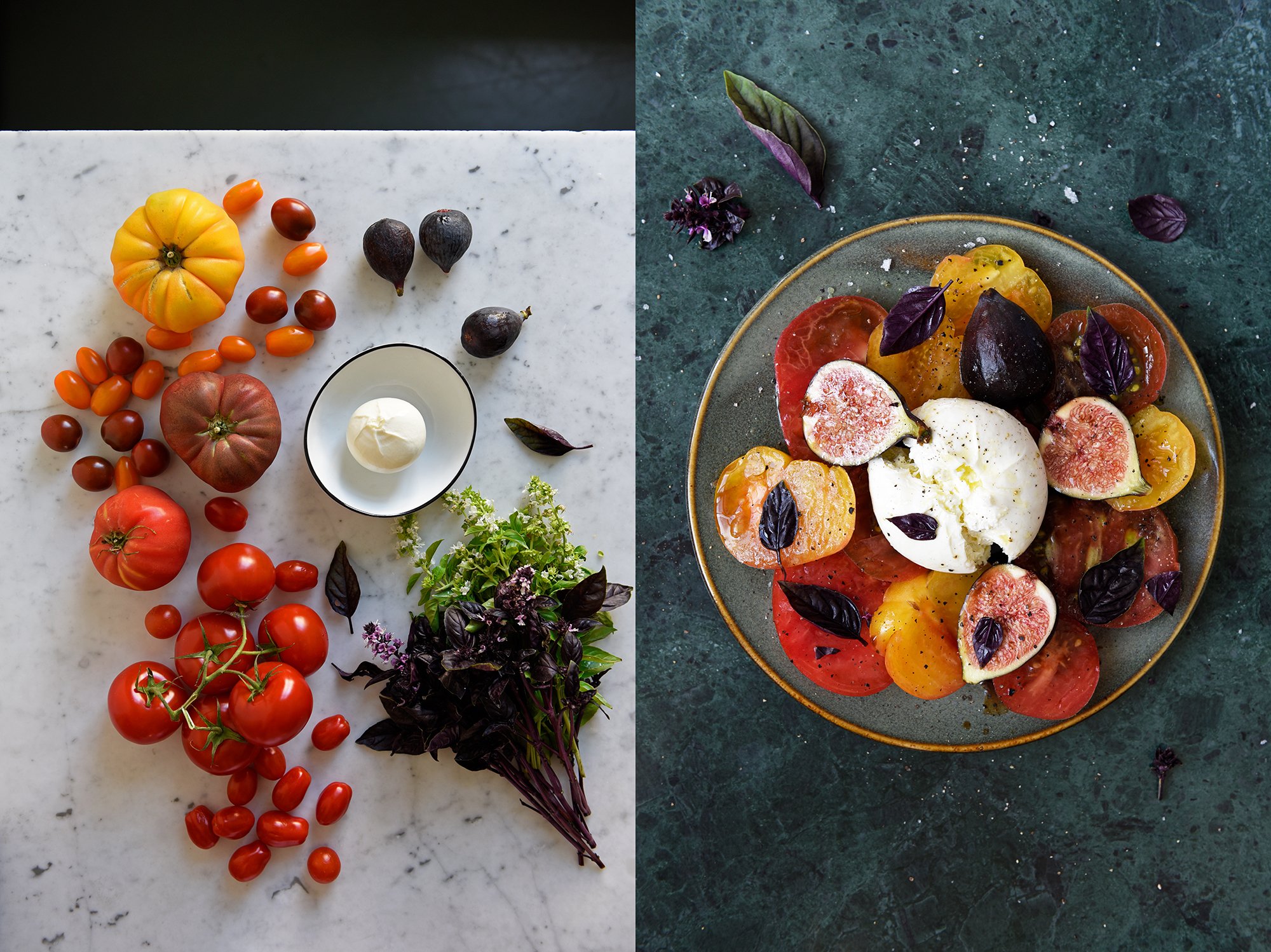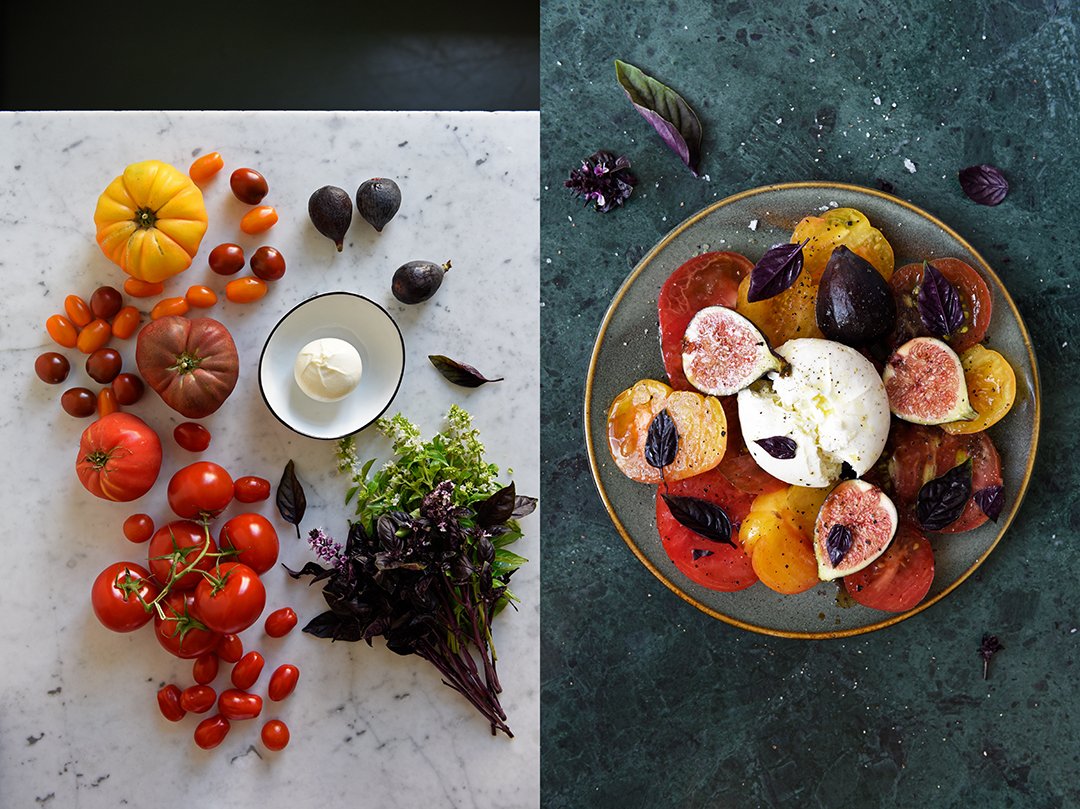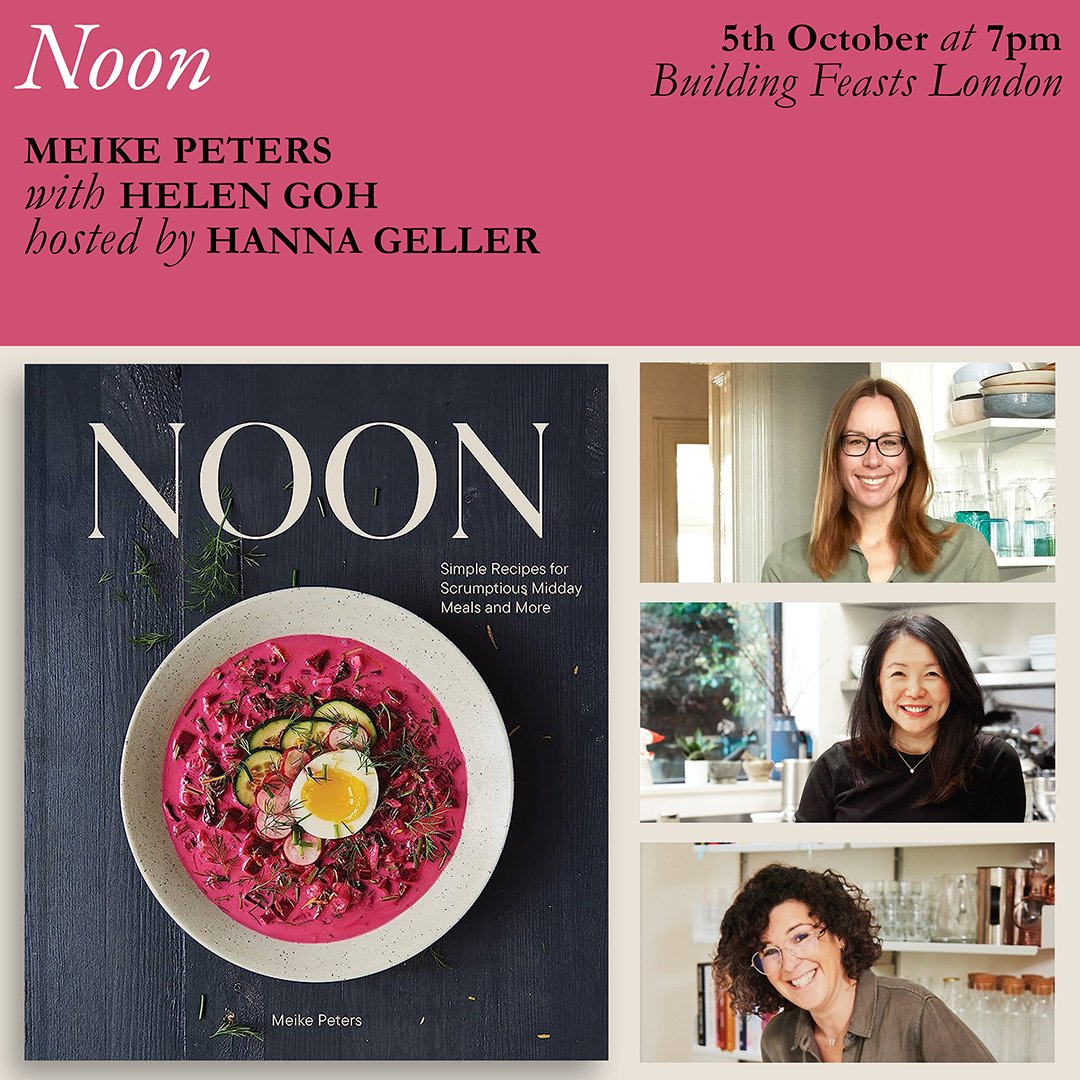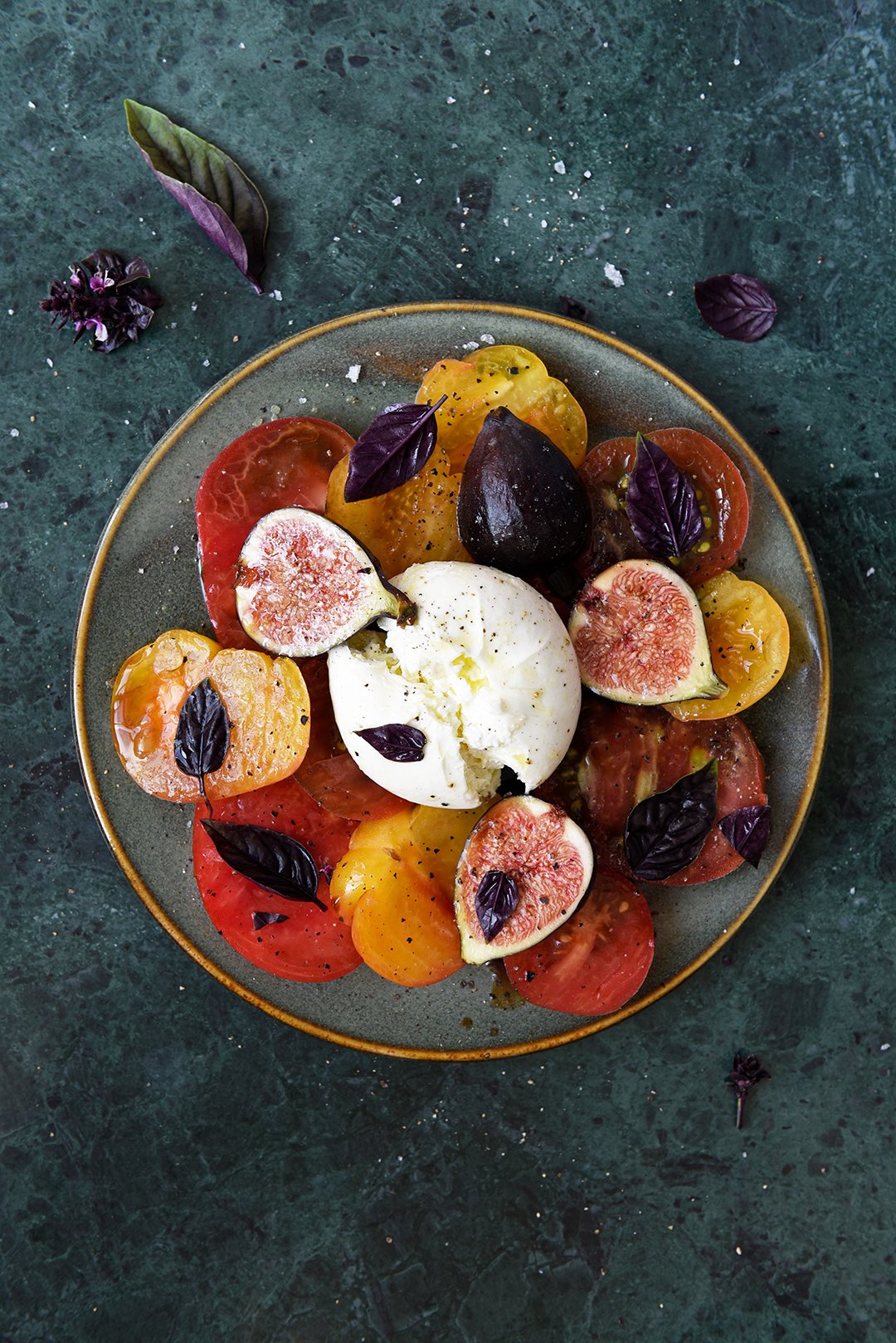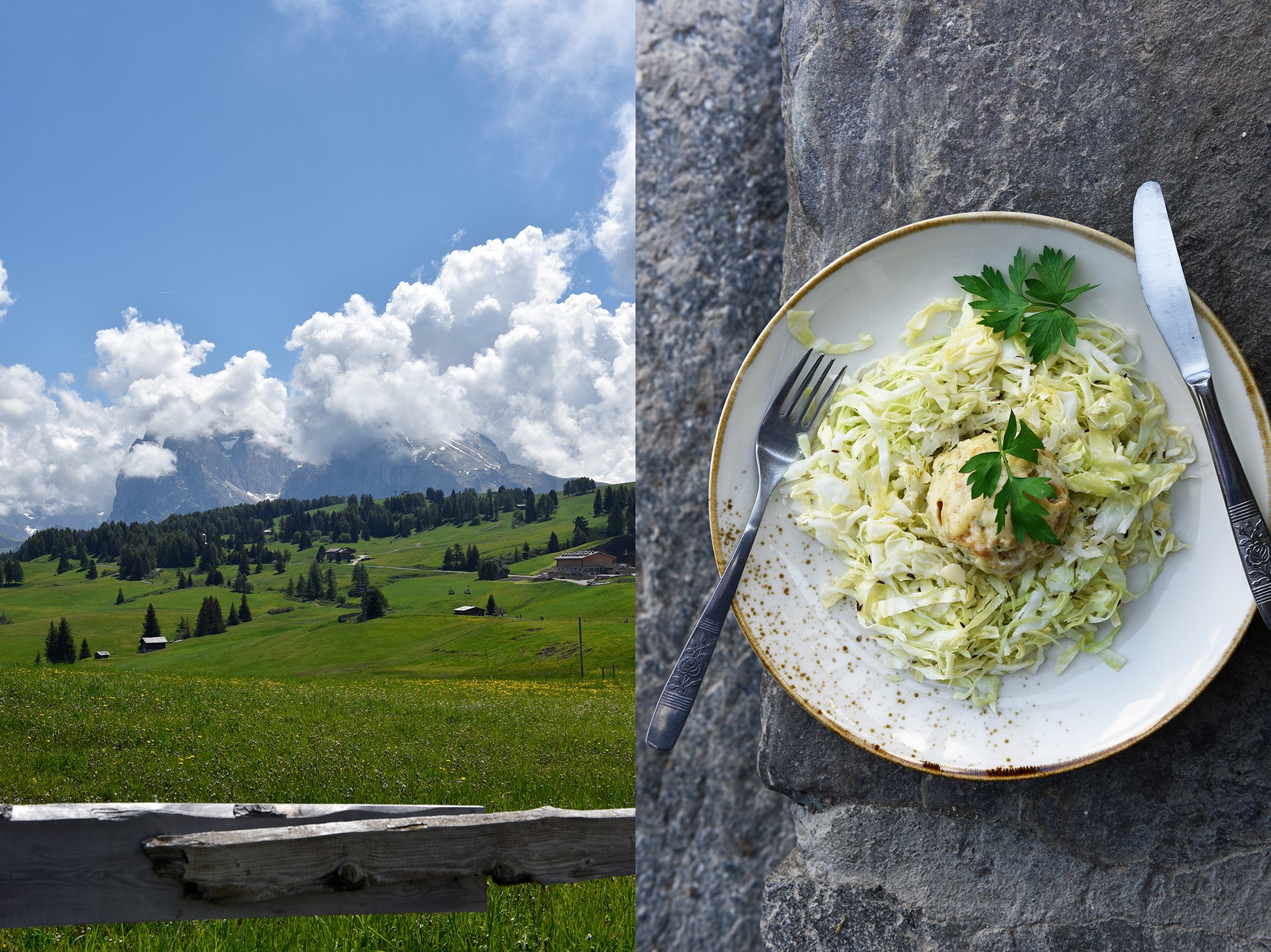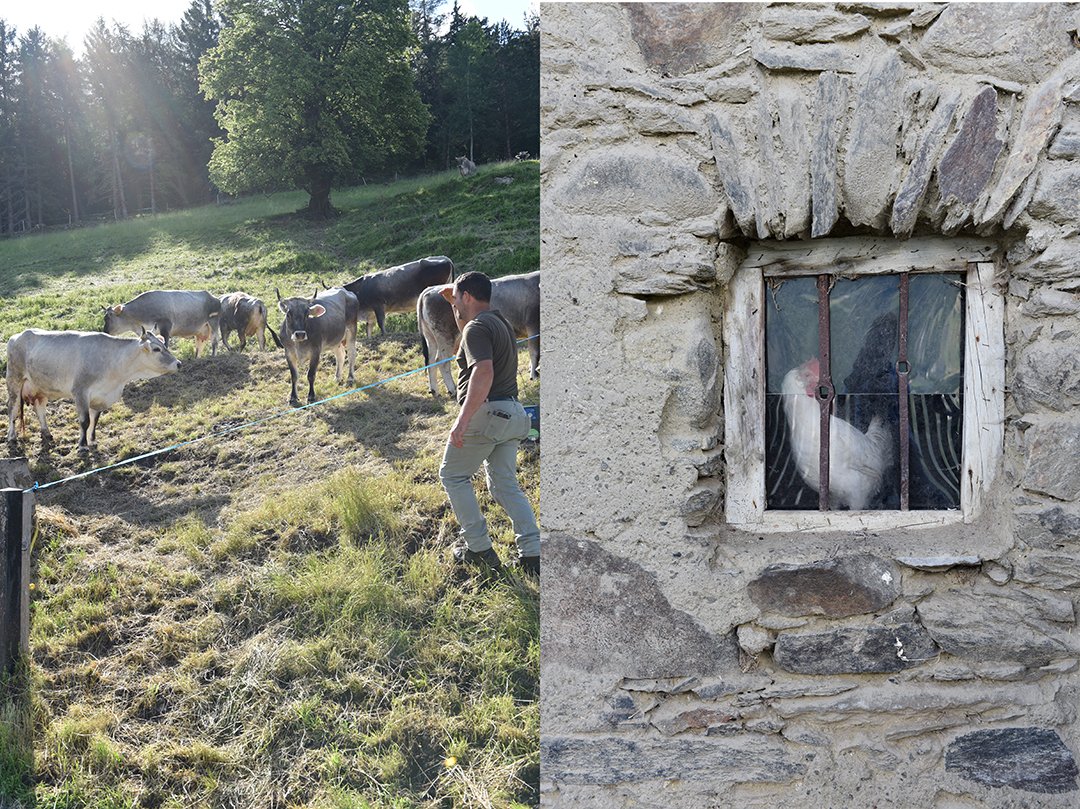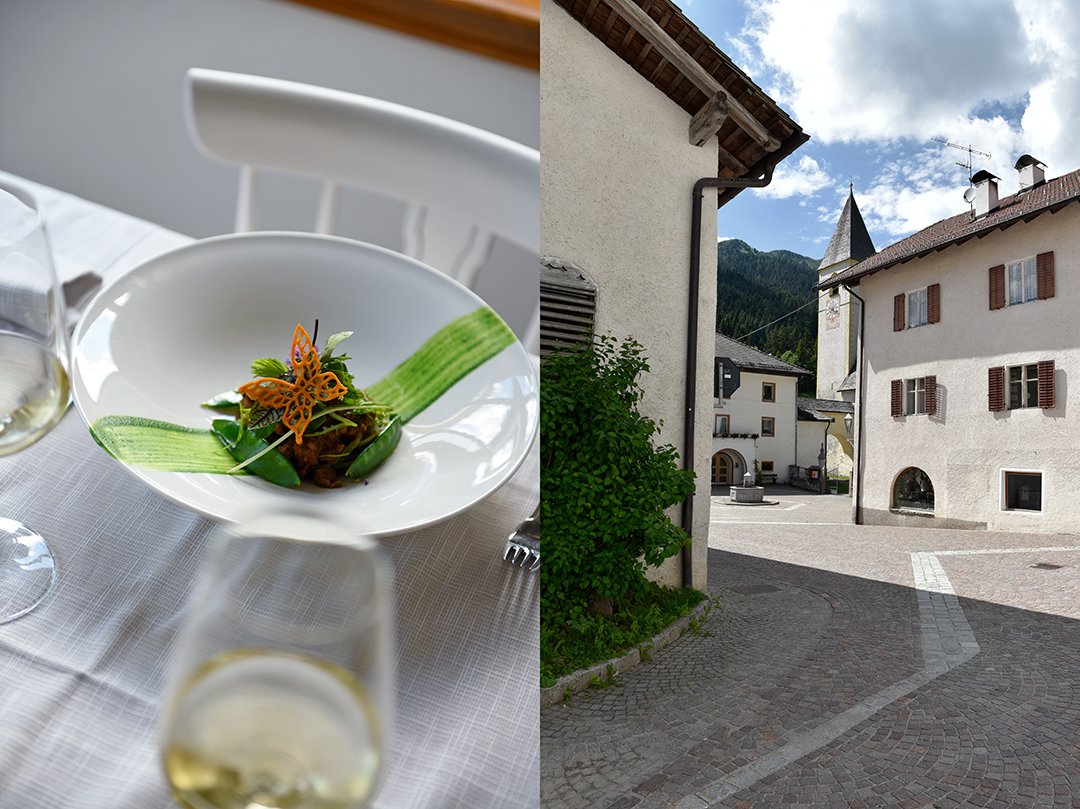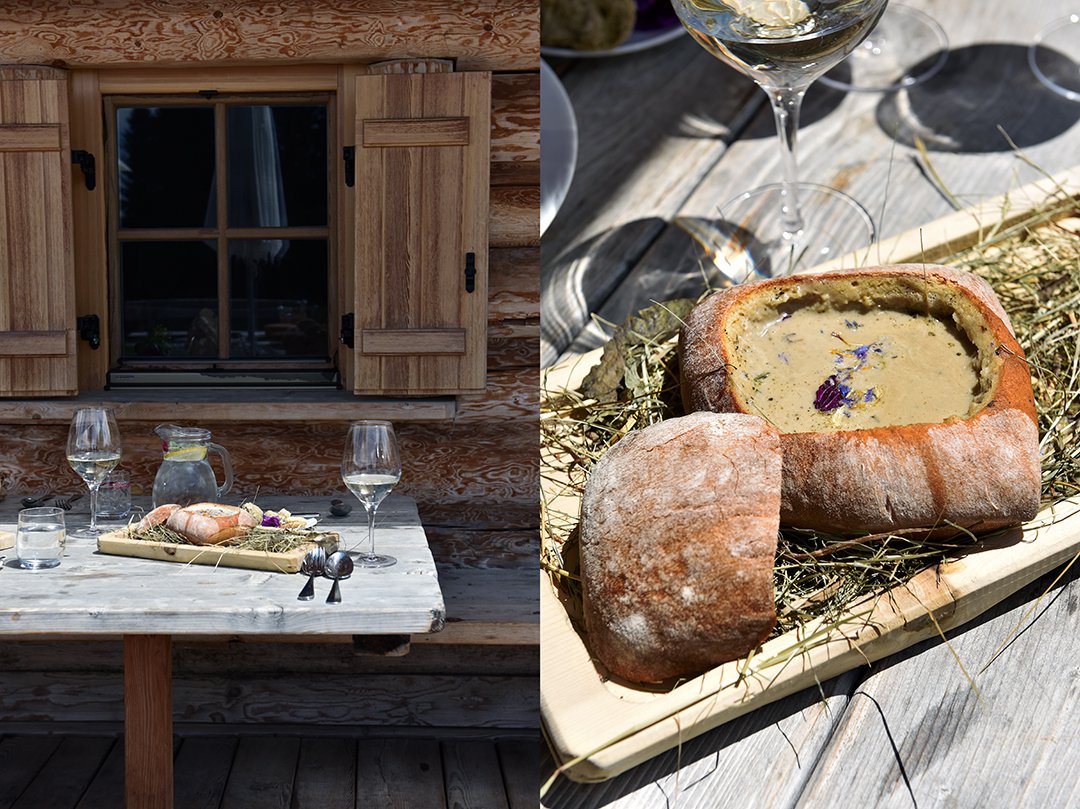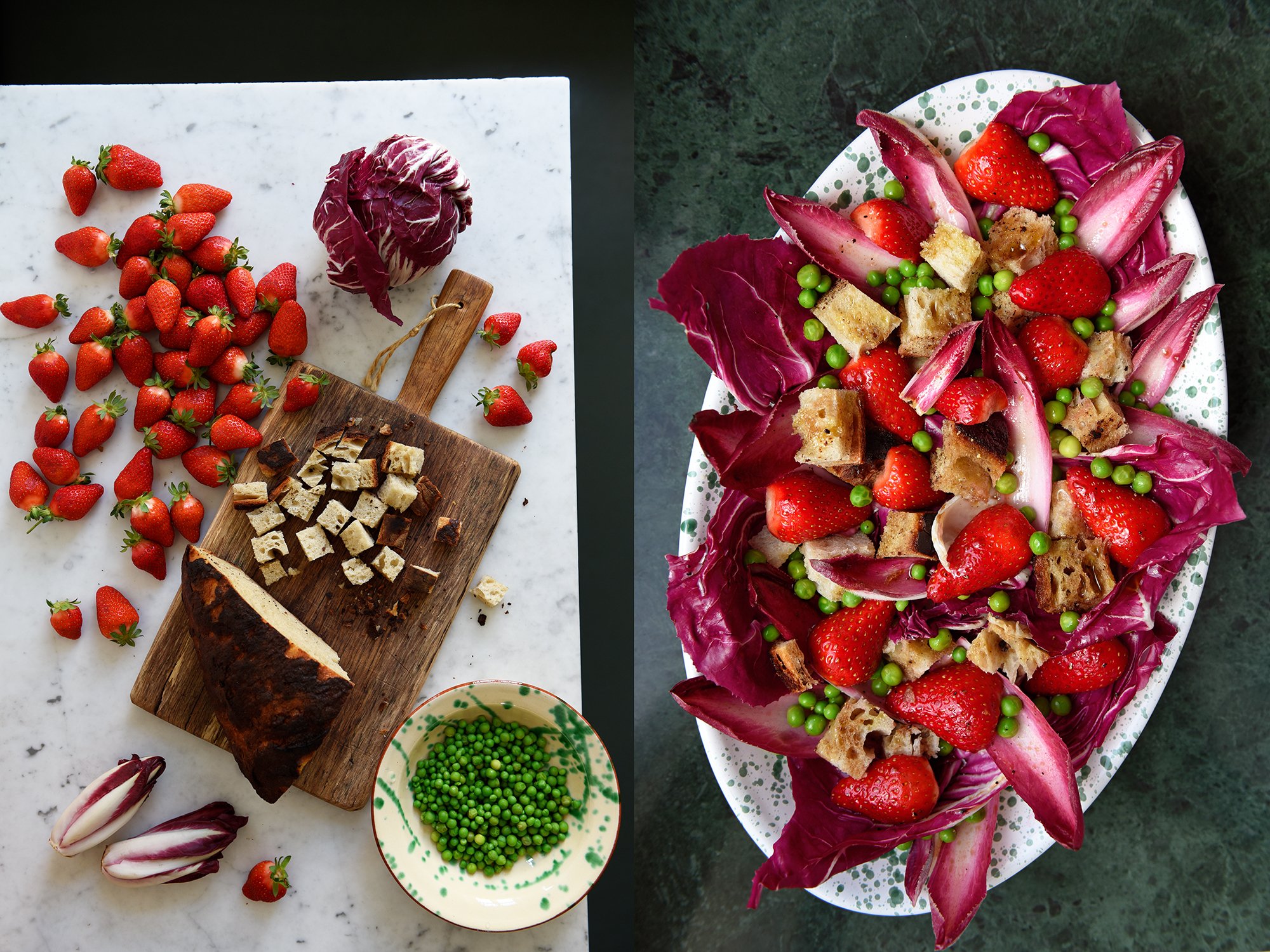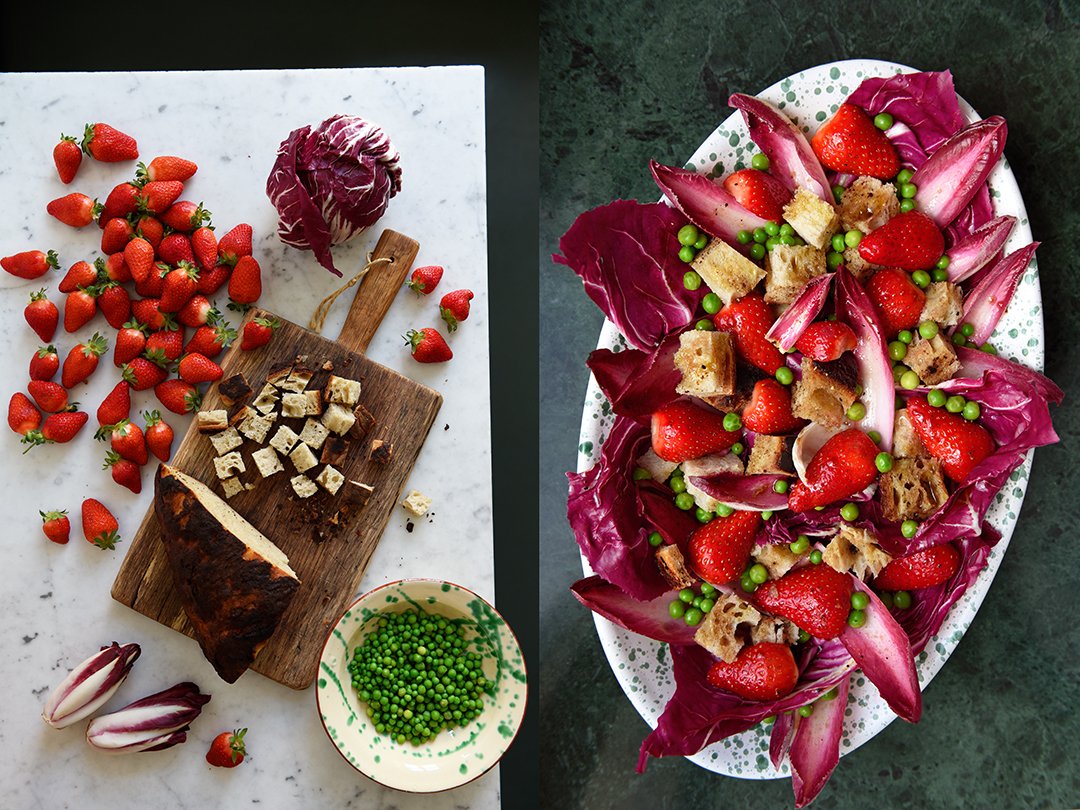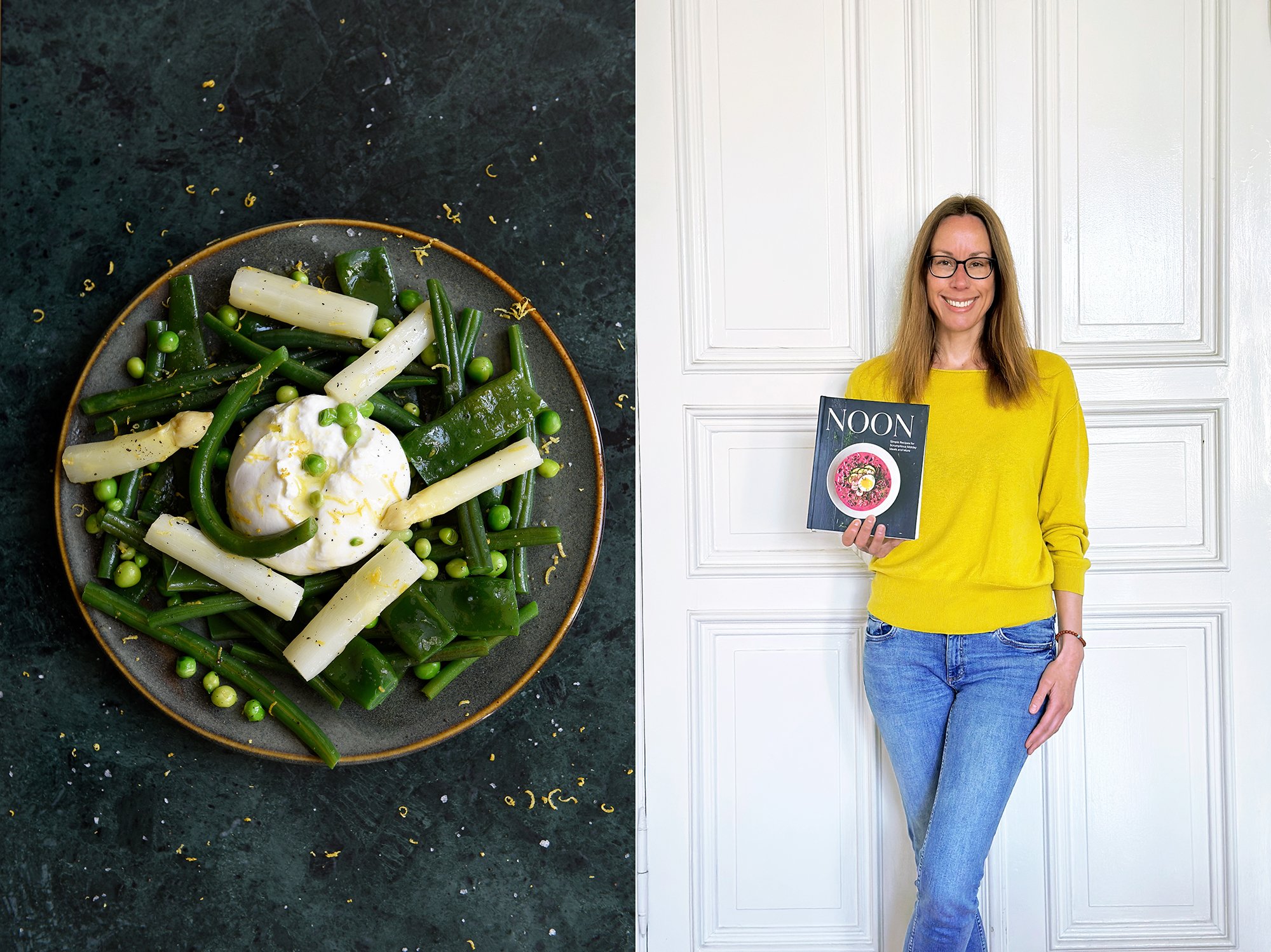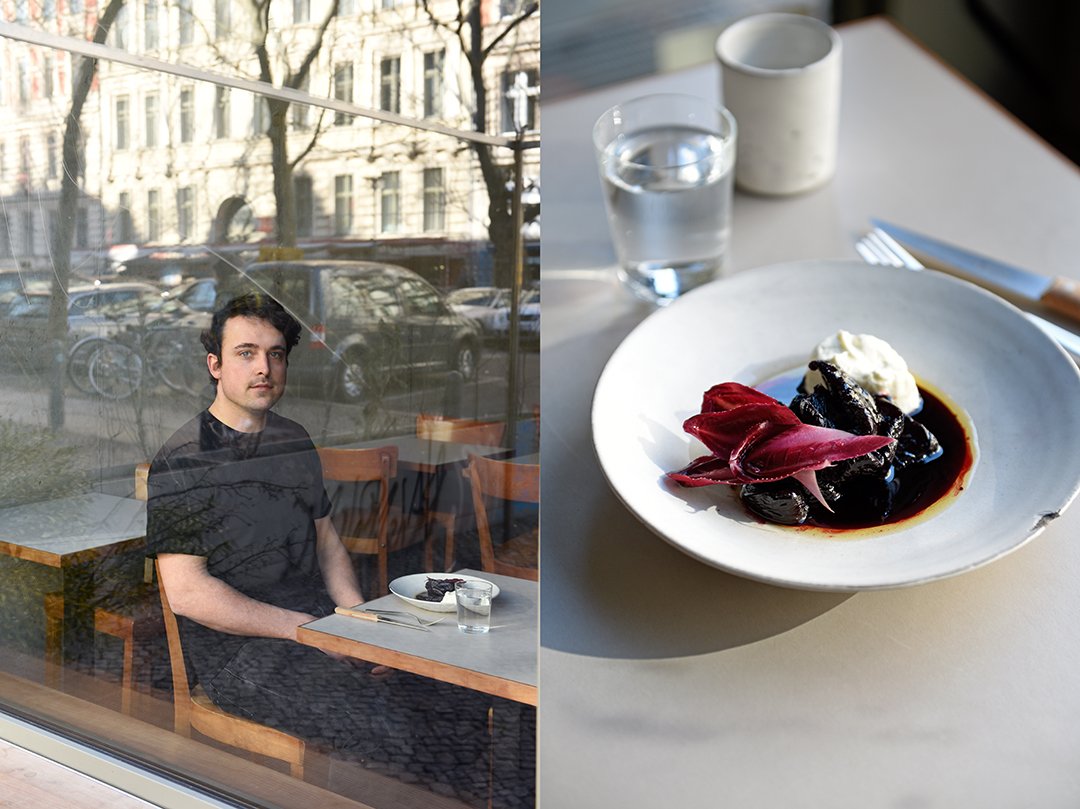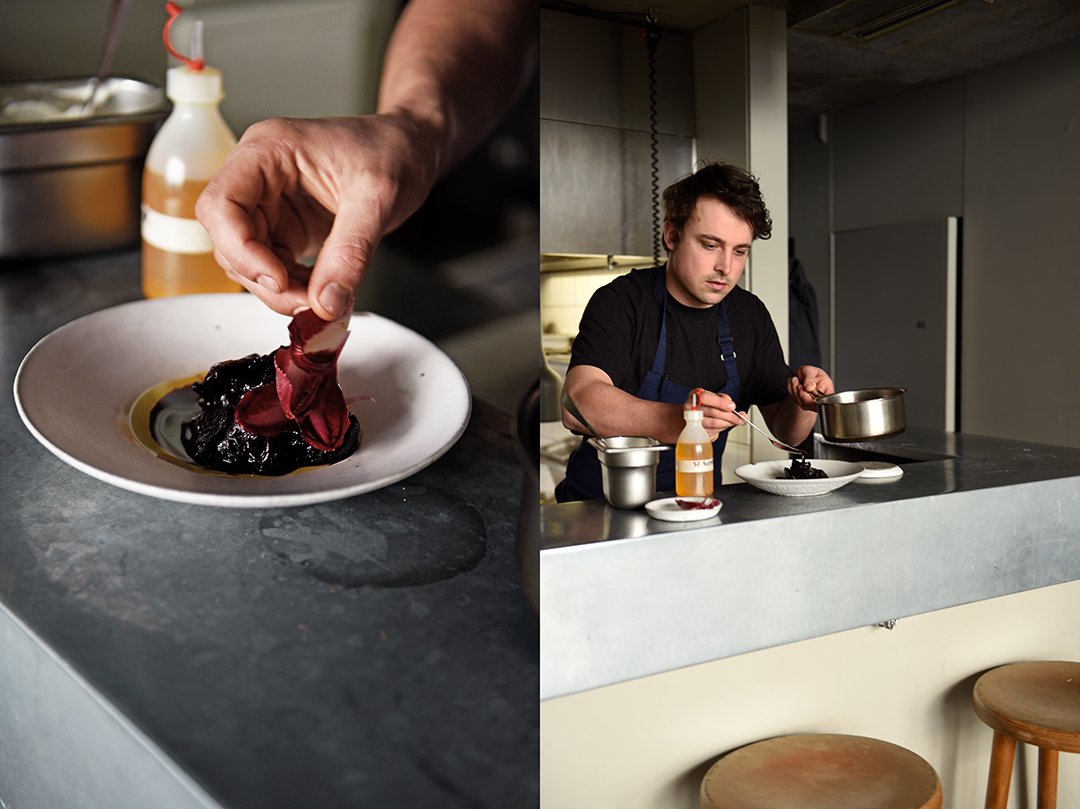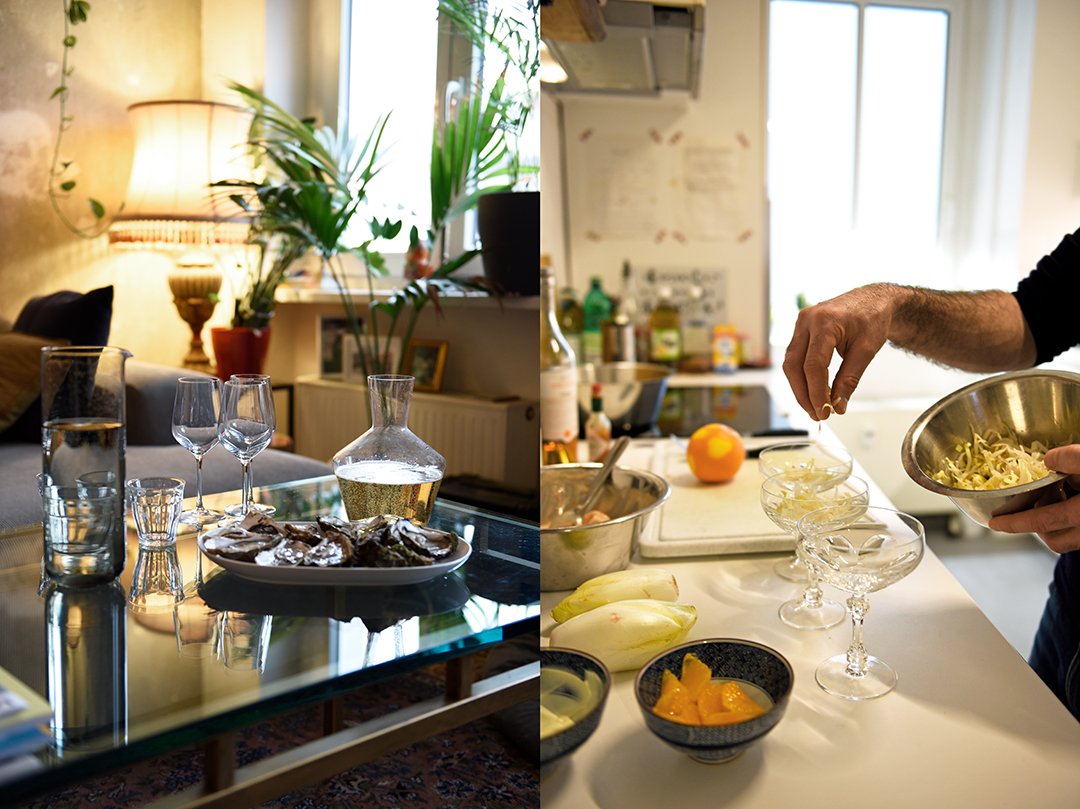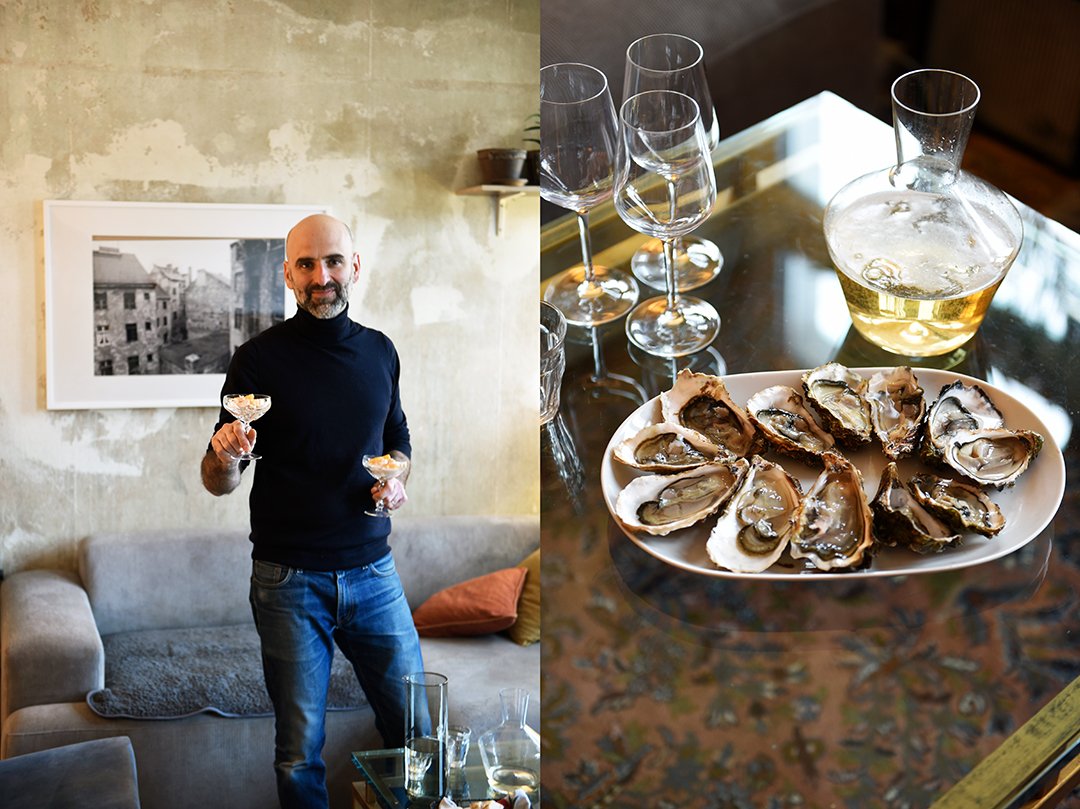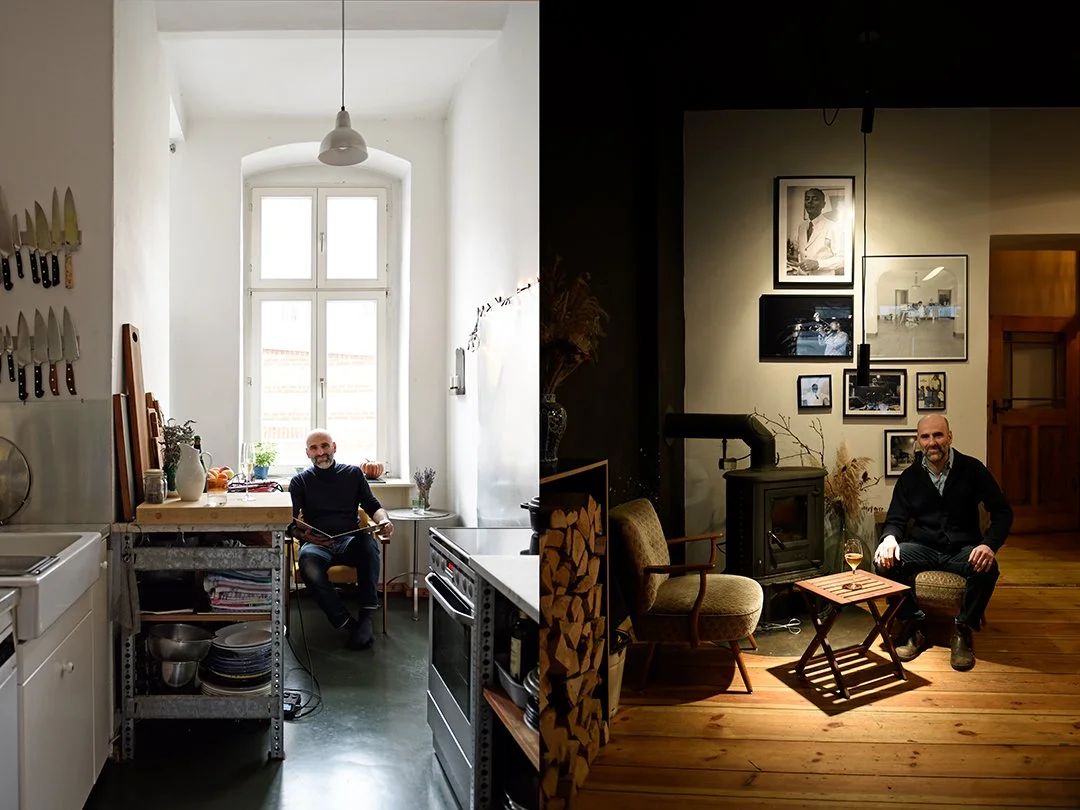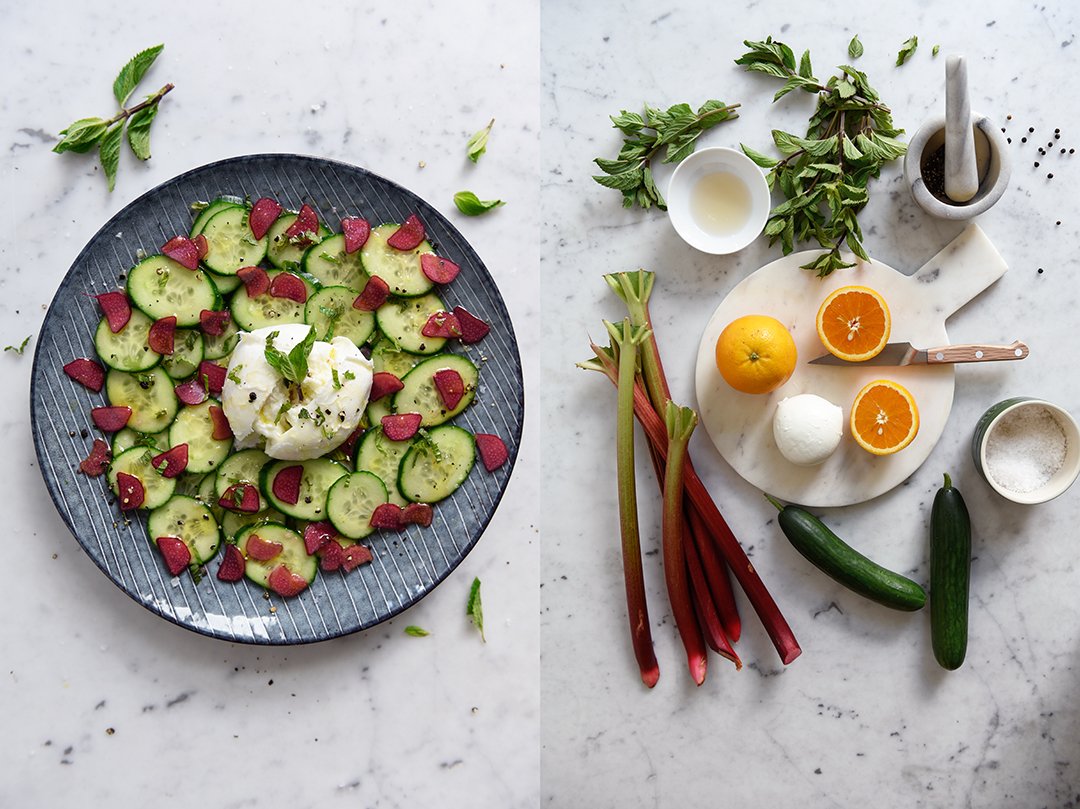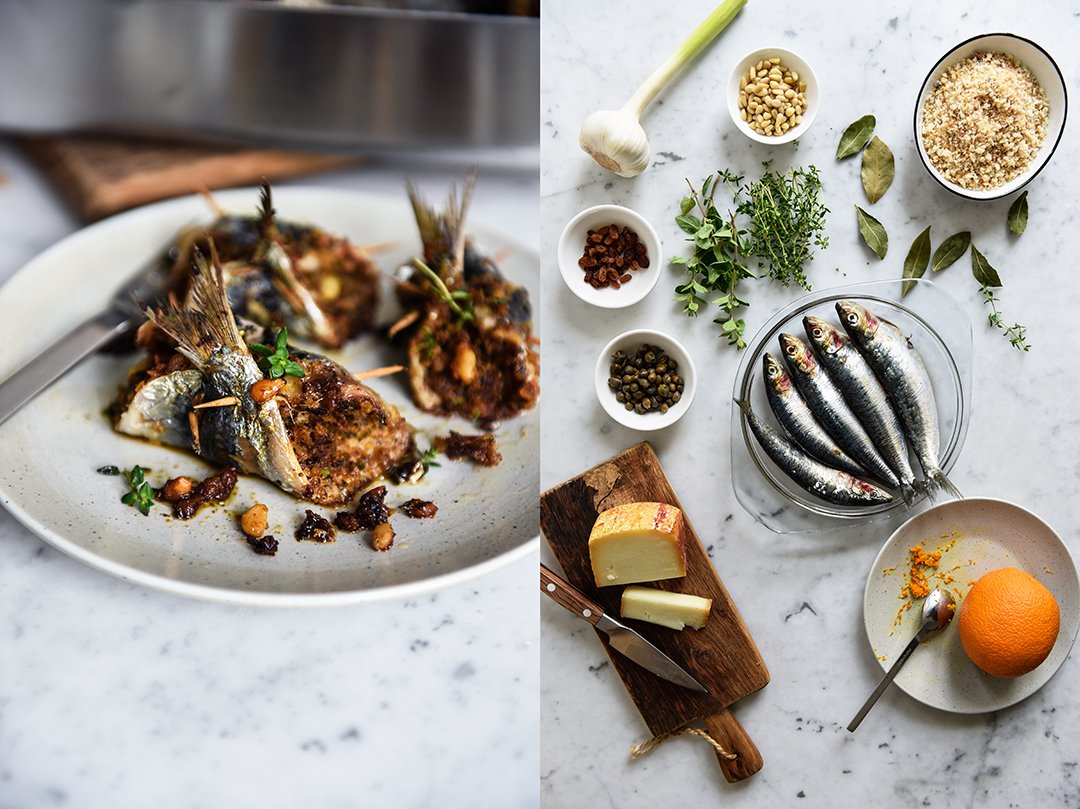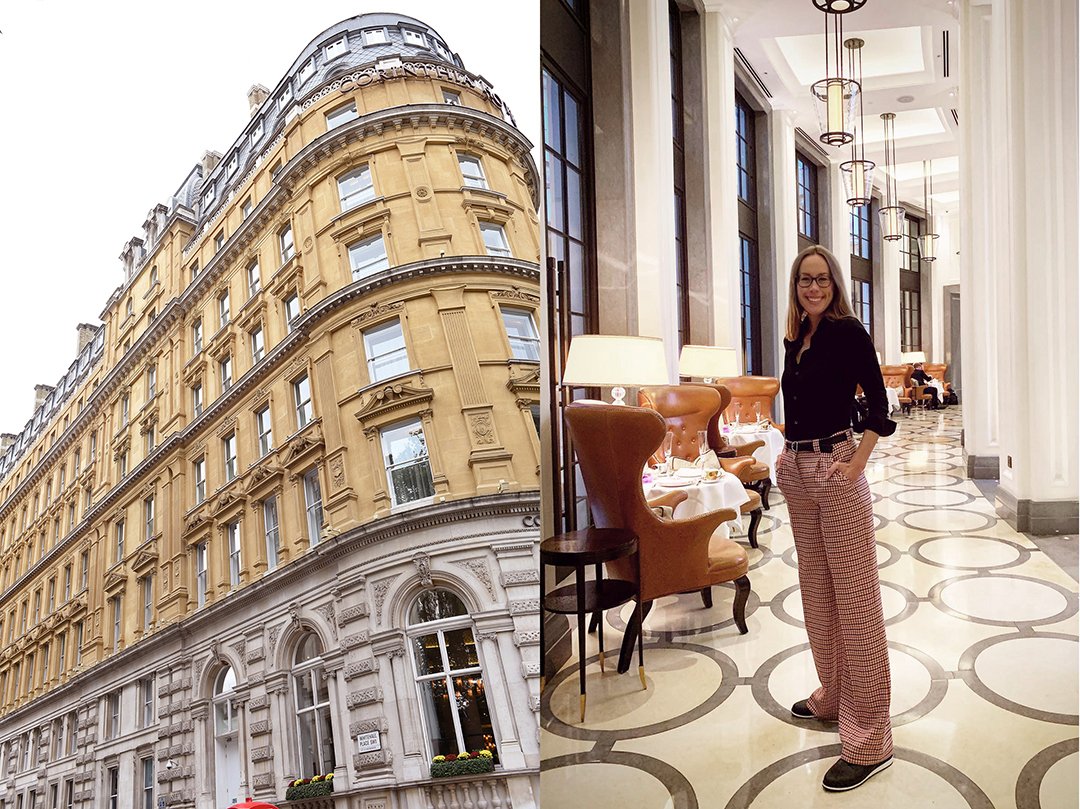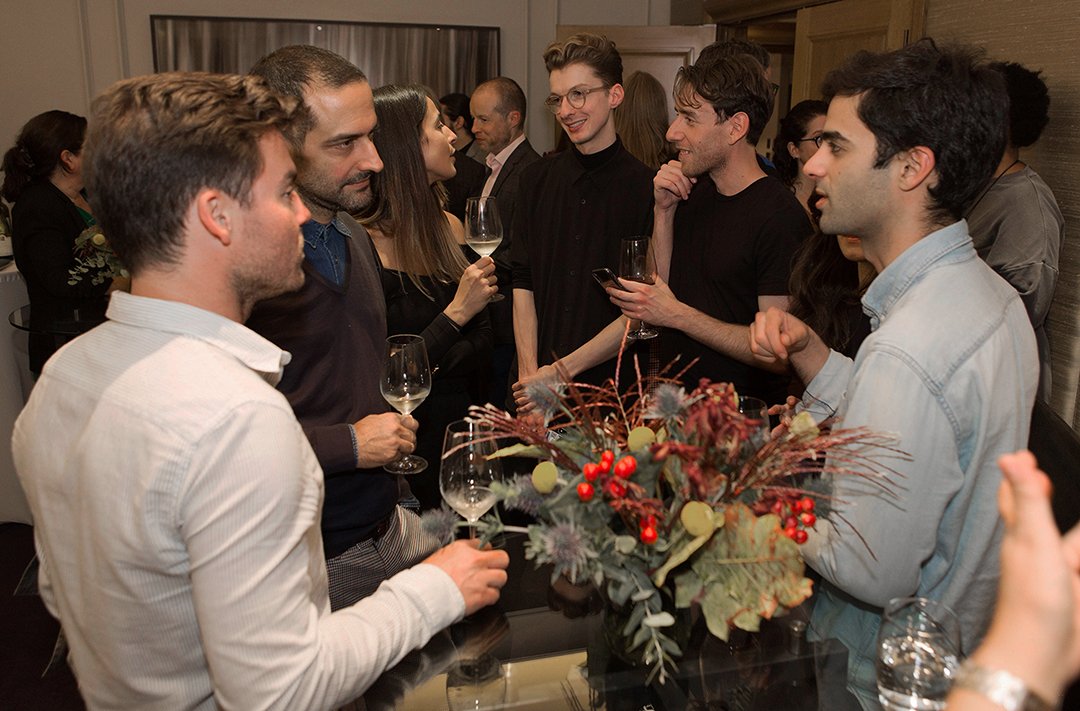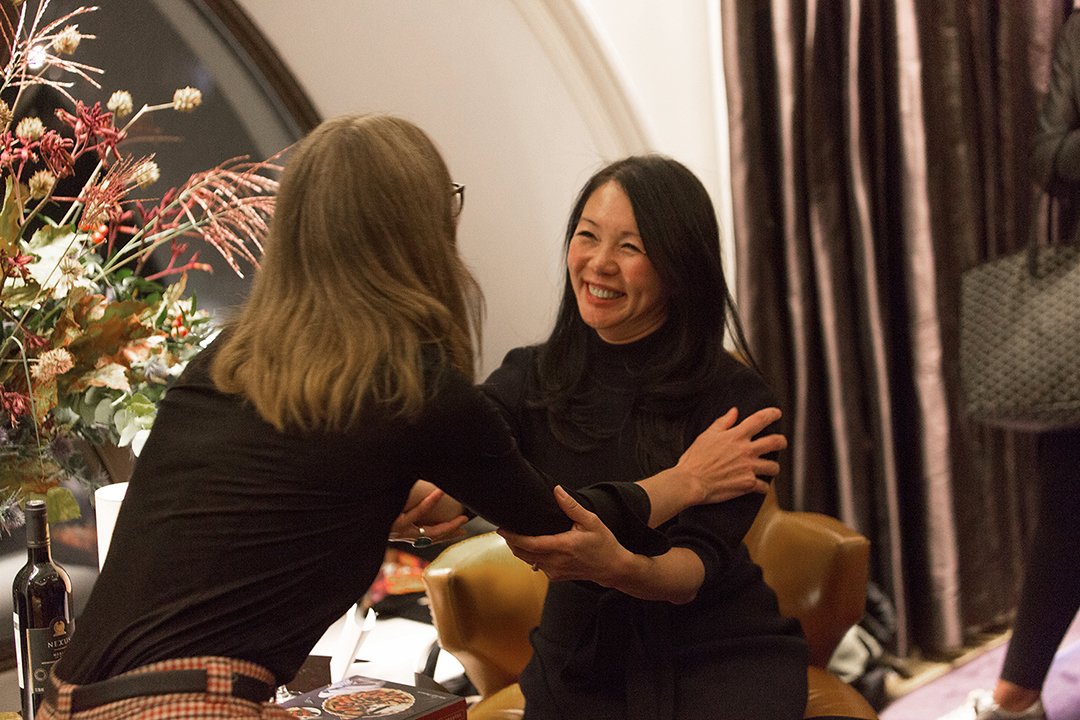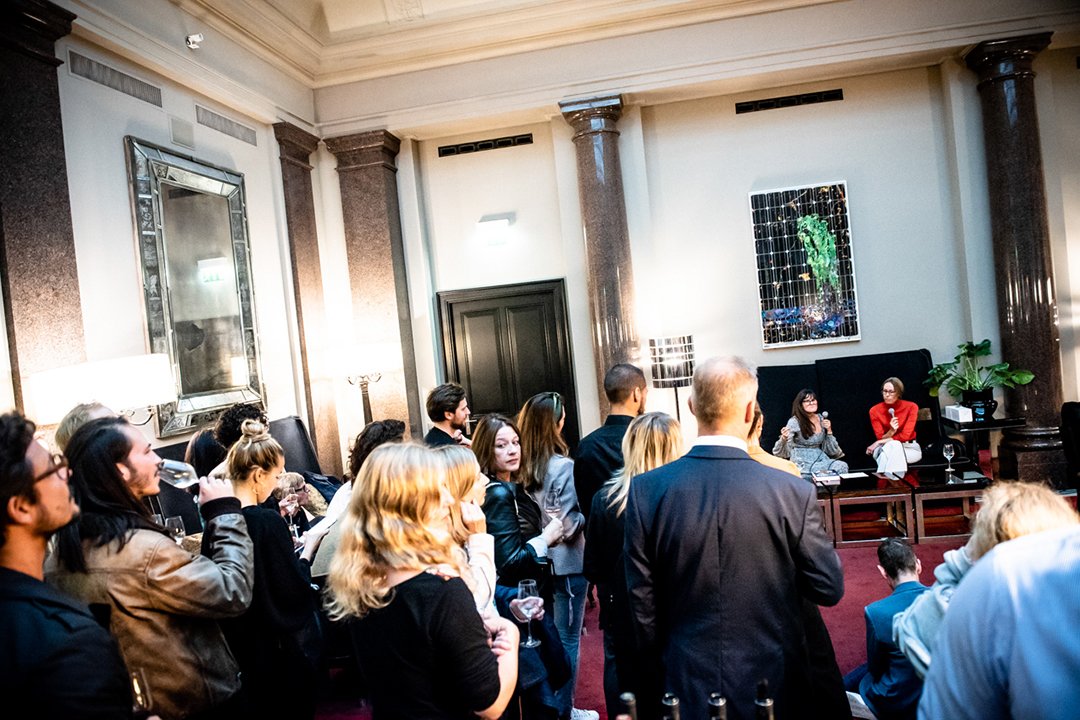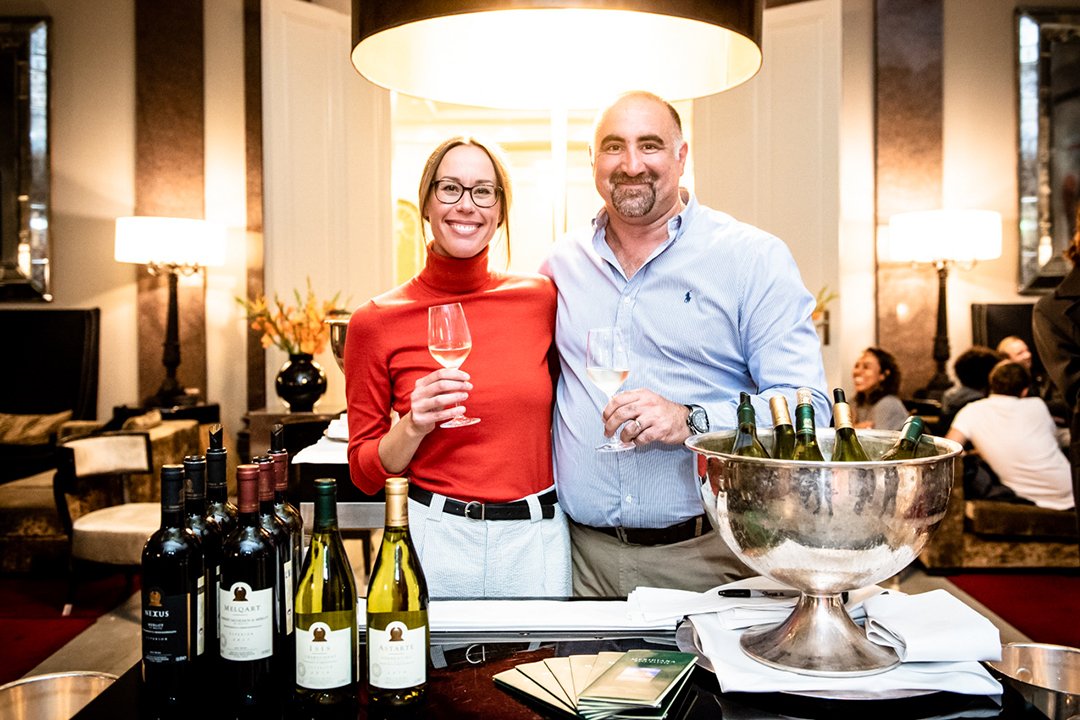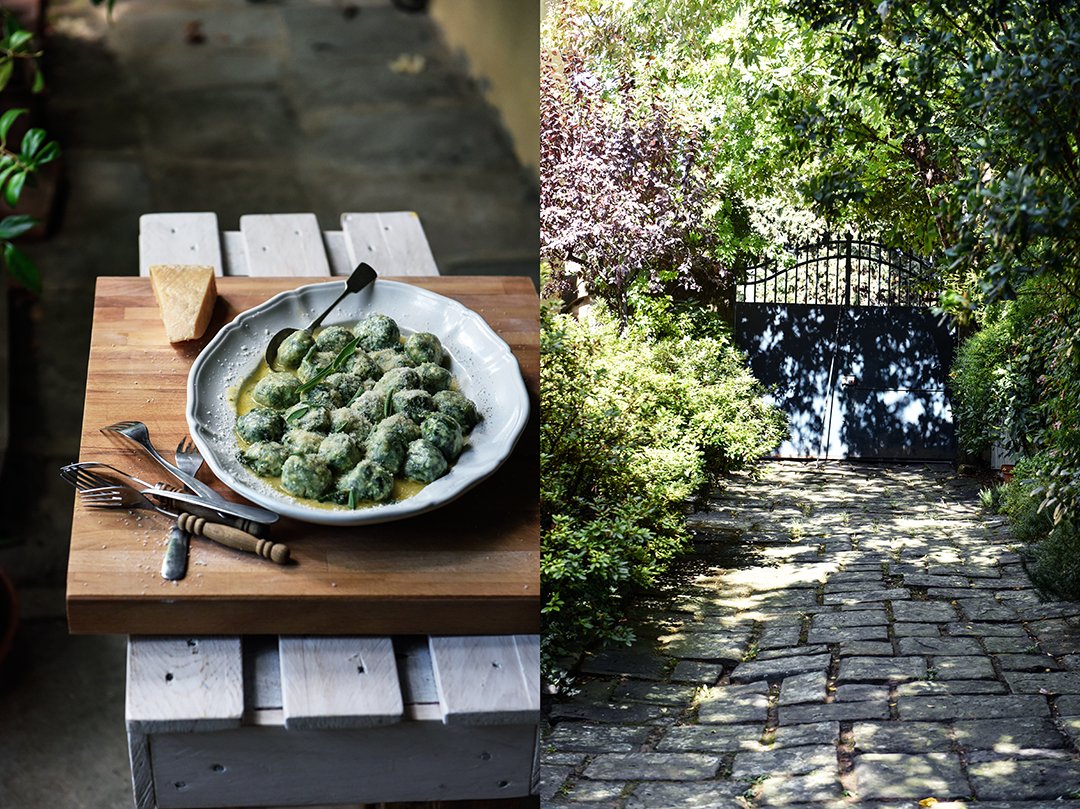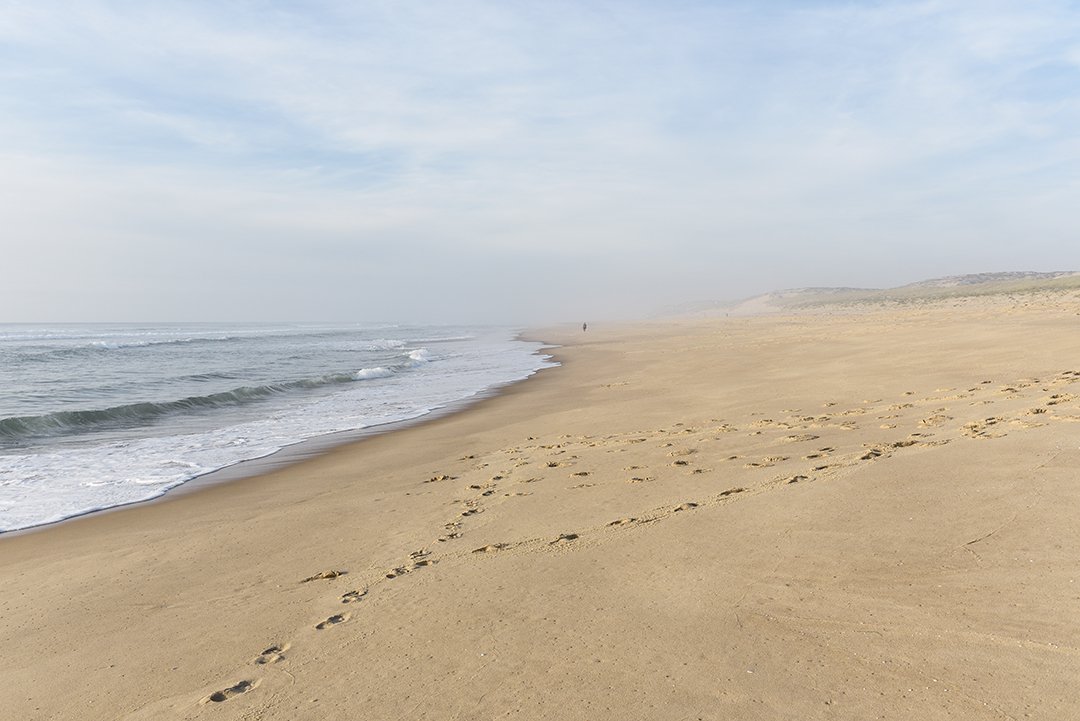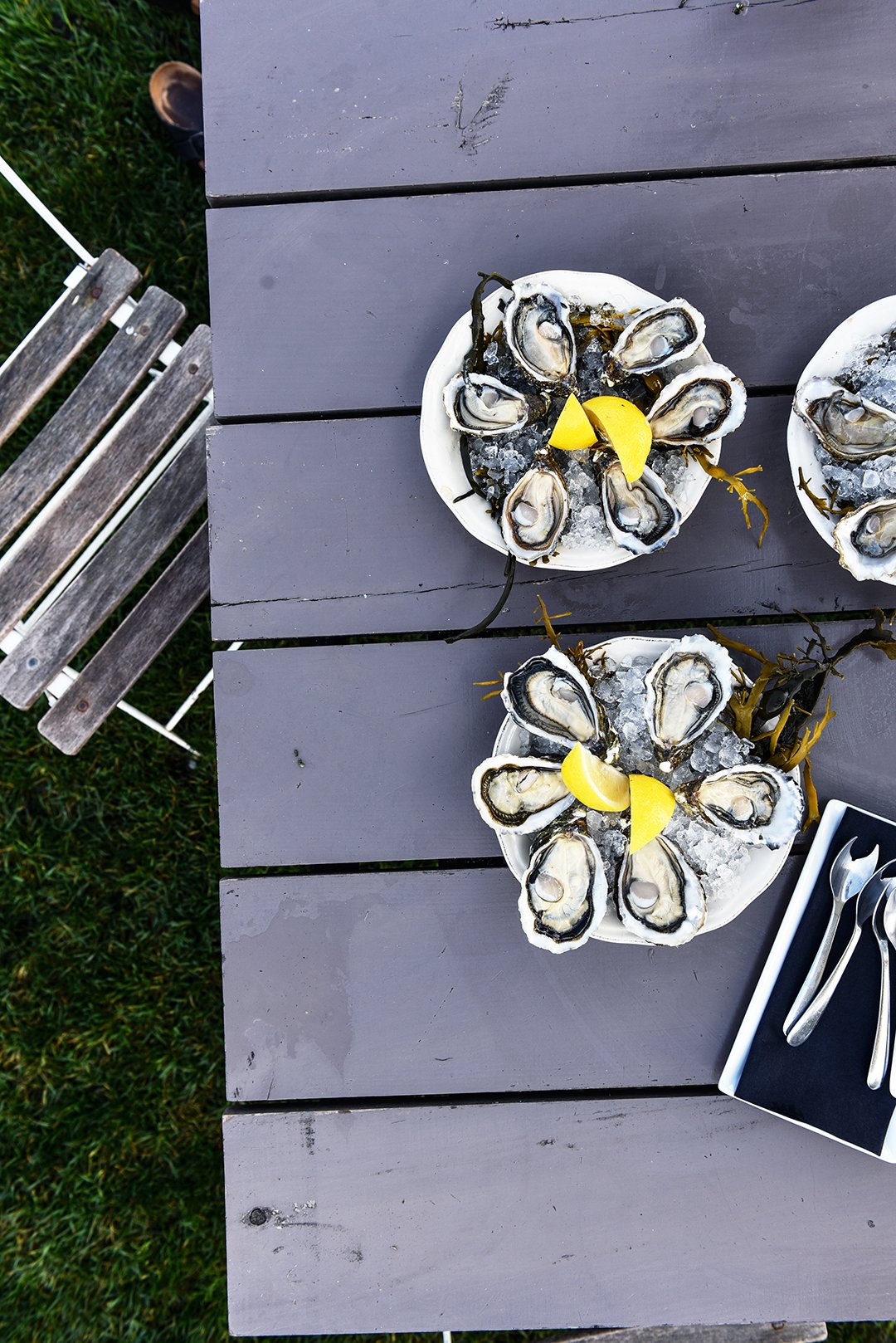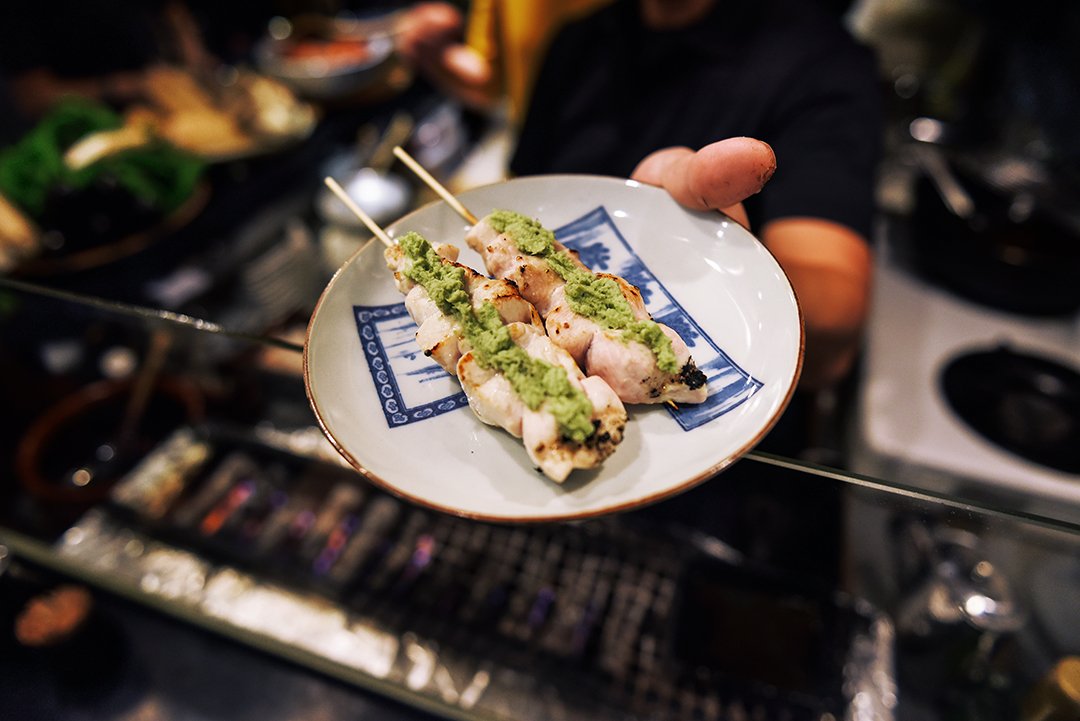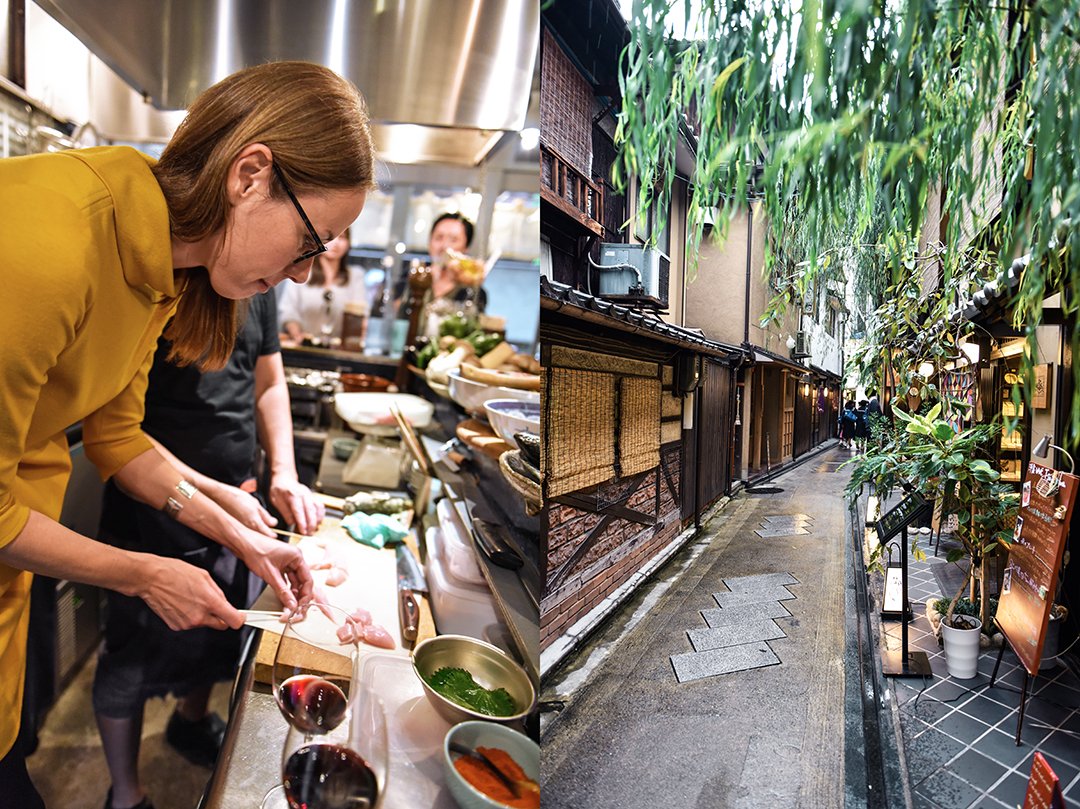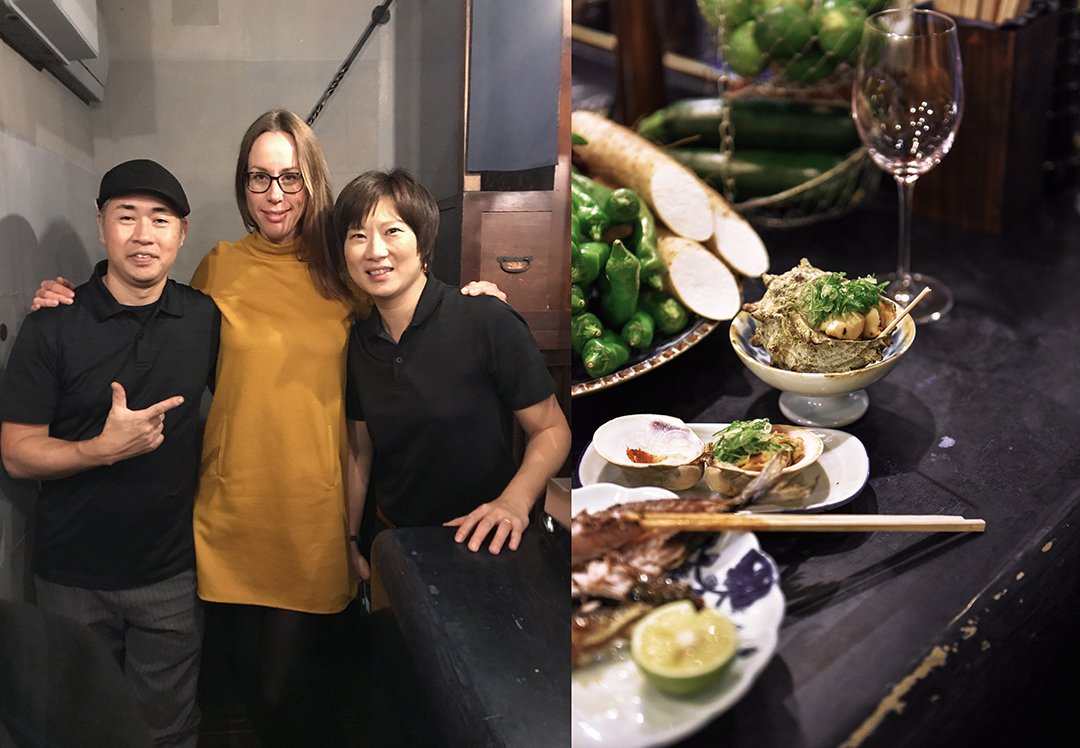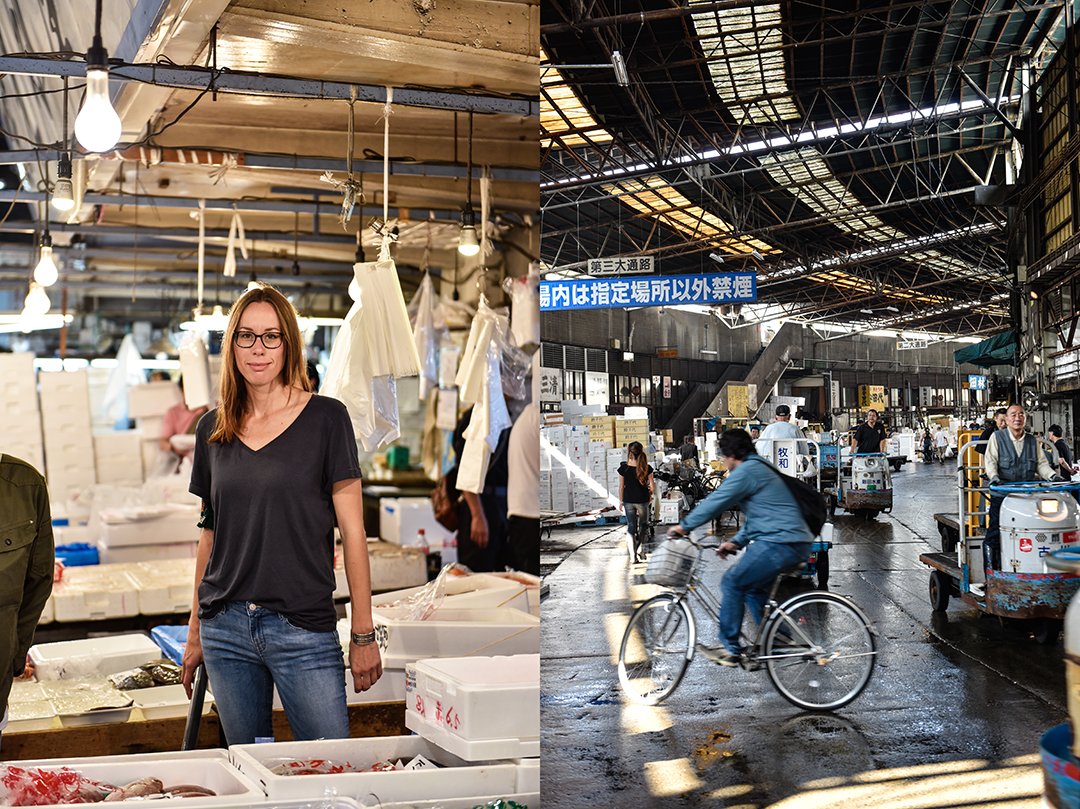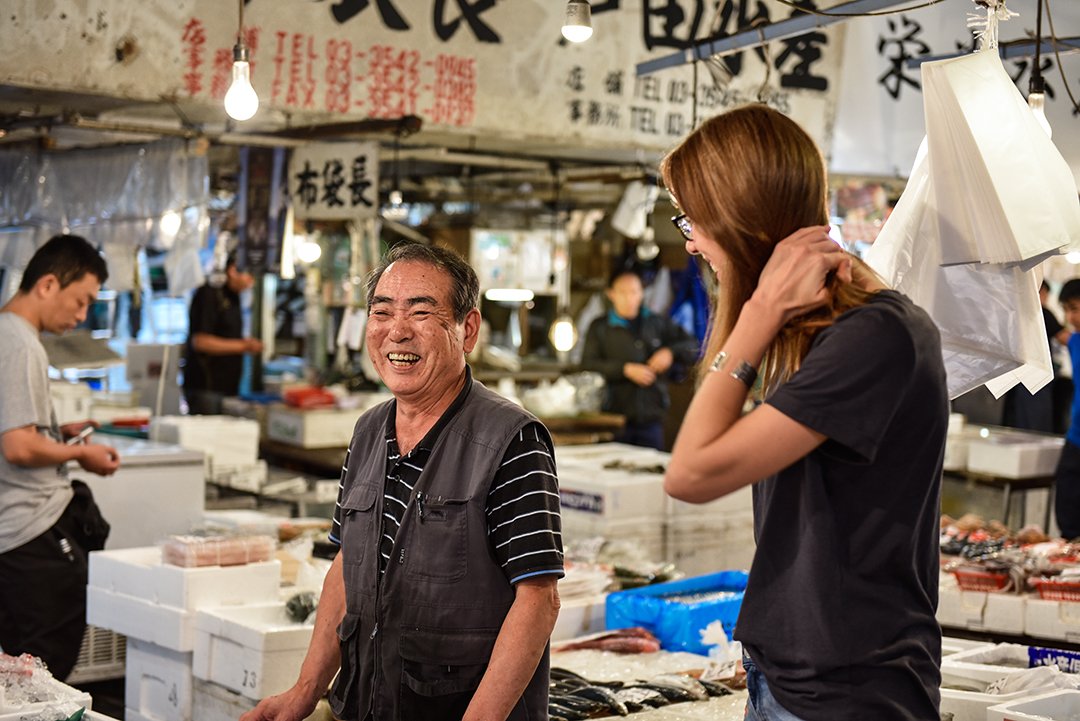LONDON
Food creates that safe, innocent space where we can meet without being a threat to each other; where we can be ourselves, embrace the fact that we are all unique through our unique stories, but when we exchange our stories - and the food connected to them - our paths converge and our lives intertwine.
To be able to share our stories, we must let go of our defenses, of our fear to be judged, condemned, or misunderstood by the ones who listen. We must accept our own vulnerability. The ground will feel wobbly, uncertain at times, but once we share our true story - and fully identify with that story - we transform; we get closer to our self and become stronger. When understanding is mutual, heartfelt on both sides, when we allow compassion, we have a real chance for change.
London was the last stop of my NOON book tour and the audience, our guests, made it easy for me to let go of my own defenses. It was an intimate evening at Hanna Geller’s (Building Feasts) beautiful, calm home. Helen Goh and I were in conversation and Hanna gently guided us through our lives, our books, our cooking and baking, and she made us feel safe to talk just as much about our confidence as about our insecurities. Sitting together with our guests in a circle, sharing food and champagne, and sharing our stories and thoughts about our lives and careers, but also sharing our vulnerability, brought all of us closer together.
Hanna opened more than just the doors to her home for the NOON book launch, without her help, trust, support, and friendship the evening wouldn’t have been possible. She prepared the food while I was running around London stock signing copies of my book, she bought champagne glasses when I noticed that I had forgotten to hire them. And the night before the event, I had the most peaceful dinner with her and three of her four boys. Sitting at her kitchen counter, a bowl of steaming soup in front of me, a dripping cheese sandwich in my hand, everyone chatting and laughing, made me feel so good, so calm, and ready for the London book launch.
And then, last Thursday night, we filled our glasses with Lallier Champagne’s glorious Grand Rosé Brut. Just like in Berlin, everyone fell in love with its fine fruity taste and delicate bubbles. Thanks to Aileen of Lallier UK, we even got a brief but very entertaining introduction to the champagne’s history and flavor profile. I can always enjoy a glass of champagne, any time, but it fit particularly well to the snacks from NOON that we - or rather Hanna - prepared and served to our guests: Peach Tart with Stilton (this is also the recipe that I’m sharing with you today, see below), Roasted Squash, Parsnip, and Grape Salad with Blue Cheese (click here for the recipe), and the Sauerkraut and Hummus on Sourdough Bread that already won the hearts of many NOON readers all over the world (here’s the recipe).
While I was in London, I got the chance to meet some book sellers at their independent bookstores to sign copies of NOON. There’s something magical about these places, the smell of books, the eyes of the customers concentrated and focussed while leafing through the pages of a book that, in that moment, becomes a world on its own. There’s a certain peace in these stores that soothes the mind and gives it some rest. That’s the magical power of a book.
Here’s a list of the London bookstores where you can find signed copies of NOON:
Books for Cooks (no signed copies but co-owner Eric Treuillé tests and serves dishes from the cookbooks at his Notting Hill bookstore / restaurant)
When you only have a few days in a city - for pleasure or business, it doesn’t really matter - when you’re on your feet constantly, it’s heavenly to come back to a hotel that feels as comfy as home but still so special that it excites and makes you smile every time you enter the loungy lobby.
The Hoxton Holborn managed to help keep my mood and energy level high and happy. Right in the center, the hotel sitting snug between Soho and Farringdon, I often didn’t even use the tube and just walked. My room was so quiet and cozy that I could have stayed for weeks (there’s something about British interiors, especially in bedrooms and bathrooms, that makes me forget about my usually quite minimalist approach to design and consider changing my entire Berlin flat from white walls to extravagantly patterned wallpapers).
Unfortunately, my schedule was tight and I didn’t get to indulge as wildly into lunches and dinners as I would have loved to, but here are some of the spots that I enjoyed while running around the city:
Quo Vadis, Smoked Eel Sandwich with a glass of crisp white wine, sitting outside on the bench (recommended by inspiring Gurdeep Loyal, author of Mother Tongue)
St. John’s Marylebone, Eccles Cake with Lancashire Cheese
Borough Market, Dorset oysters at Shellseekers (they also had the biggest oyster I’ve ever seen, 10 years old, but in the end I went for the smaller 3-year-old ones; they tasted fantastic, a little sweeter than my beloved French Fines de Claire)
Bishops Finger pub, traditional Fish & Chips
Ottolenghi Spitalfields (a tradition, for lunch)
The official NOON book tour came to an end and I want to thank YOU for following my journey that led to this book, and for your support of my work, of my recipes, and of this book that means so much to me. It’s at the same time scary and beautiful to see a book leave my kitchen and enter yours. So enjoy NOON, now it’s yours!
And I want to thank everyone who made the NOON book tour possible, in New York, in Berlin, and now in London:
Our curious guests, Hanna Geller and her son William, Helen Goh, the 3 ladies of Lallier UK: Aileen Rolfe, Rebekah Crabb, and Harriet Chandler, Champagne Lallier and Johannes Rohmer, Ingrid Meyer-Lohrmann and IML Kommunikation, everyone at The Hoxton Holborn, Eva Kaiser PR, Gianni Diliberto, Chronicle Books, and everyone at the Abrams&Chronicle Books UK headquarters.
So much love! Meike xxx
The photos taken at the NOON book launch in London are by Gianni Diliberto. The other pictures are by me.
Peach Tart with Stilton and Thyme
NOON: Simple Recipes for Scrumptious Midday Meals & More, Chronicle Books:
Bake your peach tart in the evening and take it with you to work the next day. At noon, go outside and sit down in a park, and when you munch on the first mouthful, close your eyes. Buttery pastry, chunky peaches, Stilton, and thyme, all in one bite, taste like a summer holiday memory turned into food. The sweet, fruity juices and salty cheese can almost compete with a blissful day at the beach.
NOTE: you can also replace the peaches with pears.
Serves 3 to 4
FOR THE PASTRY
2 cups (260 g) all-purpose flour
1 teaspoon fine sea salt
½ cup plus 1 tablespoon (130 g) unsalted butter, cold
1 large egg
FOR THE TOPPING
3 large white doughnut peaches, cut in half lengthwise
2 large yellow peaches, cut into quarters
2½ tablespoons olive oil
3 ounces (85 g) Stilton or Roquefort, crumbled
15 fresh small thyme sprigs, plus 1 tablespoon thyme leaves
Flaky sea salt
Coarsely ground pepper
For the pastry, combine the flour and salt in the bowl of a stand mixer fitted with the paddle attachment. Add the butter and use a knife to cut it into the flour until there are just small pieces left. Quickly rub the butter into the flour with your fingers until combined. Add the egg and mix on low just until the dough comes together. Form the dough into a thick disc, wrap it in plastic wrap, and freeze for 10 minutes.
Preheat the oven to 400°F (200°C).
On a work surface, place the dough between 2 sheets of plastic wrap and use a rolling pin to roll out into a disc, large enough to line the bottom and sides of a 10 to 12-inch (25.5 to 30 cm) quiche dish; a smaller quiche dish makes a thicker pastry base, which is nice for the peaches. Fit the dough into the quiche dish, pushing it into the dish, especially along the edges. Use a fork to prick the dough all over. Bake for about 15 minutes or until golden. If the dough bubbles up, push it down with a fork.
For the topping, arrange the peaches in circles on top of the prebaked pastry; for the middle of the tart, cut 2 yellow peach quarters in half again and arrange in a small circle. Drizzle with the olive oil, then sprinkle with the Stilton, thyme sprigs, and a little flaky sea salt. Bake for about 23 minutes or until the pastry is golden and crispy and the cheese is melted. Take the tart out of the oven, then immediately sprinkle with the thyme leaves and a little pepper. Let the tart cool for at least 15 minutes. Enjoy warm or cold.
BERLIN
Berlin was a party! We celebrated the German NOON at the stunning Hotel de Rome, with (lots of) champagne, with friends who came all the way from Lisbon, France, and Vienna, and with many good conversations. And we even sang at the end.
Celebrating a new book in my home city, Berlin, makes me feel both calm and very excited at the same time. I’m surrounded by my people, by my beloved city; and launching a book for the third time at Hotel de Rome, makes it feel even more like home.
So many kept offering me help, there was so much love and support that, although the launch was rather wild, it didn’t feel overwhelming for a second. Our event was set for two hours - we extended it slightly - but not even ten hours would have been enough to fit in all the conversations that I would have loved to have. About 80 guests (I lost track), the champagne kept pouring, the snacks from NOON were relished with sounds of pleasure (so much praise for the Hummus and Sauerkraut on Sourdough Bread from the book! Click here for the recipe), we didn’t even need any background music as the chatting and laughing filled the hotel’s Opera Court, a grand room in the former bank’s building (you can read more about the hotel’s history here).
Restaurateur Billy Wagner of Nobelhart & Schmutzig, no. 45 of the World’s 50 Best Restaurants, thankfully agreed to do the talk with me at our event. About two years ago, we had done a Meet in Your Kitchen feature and a podcast episode together. A few months ago, I bumped into him at an exhibition. After I had left, I was already on my bike on my way home, I thought “Billy, he’s the one for the Berlin NOON talk!.” So I quickly cycled back, asked him, still out of breath, if he’d be up for it and, luckily, he was.
When he asked me his questions in his calm Billy-way - some even unexpected, which I like - I stayed relaxed and inspired throughout the entire conversation. I think our exchange about food, noon, cookbooks, rituals, and recipes was as much fun for me as it was for our guests. Billy kept the string tight, without letting it tear - that’s a great gift to guide through a conversation.
To organize an event this big, you need partners, a team who you can trust and who trusts you too. The Hotel de Rome is not only one of Berlin’s most beautiful five-star hotels - and has the city’s most stunning roof terrace - it also has the best staff. Türkan Arikan, Director of Communications, has been a great supporter of my work since 2015 when we first met. It almost felt like love at first sight and even three books later, it hasn’t lost any of its magic.
I met Ingrid Meyer-Lohrmann, a natural networker with the biggest heart and passion for connecting people, around the same time as Türkan. Ingrid was the one who introduced me to Hotel de Rome eight years ago, and now, she brought Lallier Champagne into my life, whose delicious pink bubbles definitely lifted the crowd’s mood. Matthias Runge, the hotel’s Executive Chef, has been a fan of my recipes for years, we often chat about flavor combinations, so seeing him prepare the dishes for our event, made me feel very safe.
Today, I’m sharing one of the recipes from NOON that we also chose for the launch and that helps to slowly slip into the groove for autumn: Roasted Squash, Parsnip, and Grape Salad with Blue Cheese (recipe below).
The Berlin launch felt like a party - and I loved that. I’m quite happy that I don’t have to host a big event every week, however, when I think about it, the same rules that count for events also count for private gatherings. To be a good host, you need to feel good. You can only spread good vibes, when you feel them inside yourself. And to feel good, you need to surround yourself with the right people, you need to choose recipes that fit the occasion and to your schedule, and then it’s so much easier to stay relaxed and confident all night.
In the end, never forget, it’s your party. So accept imperfection and believe the ones around you when they offer you help. I’ve never accepted my imperfections more than I do now, I’ve never asked for help in such an honest way like I do now, I’ve never been so accepting with my own flaws. And I’ve never been so happy.
The next stops of my NOON book tour will be London on October 5th:
You can join me in conversation with Helen Goh, hosted by Hanna Geller at Building Feasts in a beautiful (secret) location (we will send you the address when you buy the ticket), with Lallier Champagne and snacks from NOON!
GET YOUR TICKET HERE and we’ll see you in London!
I want to thank everyone who made the Berlin launch of NOON possible - and so glamorous and glorious! Our guests, I loved seeing and hearing your laughters, seeing you dive deep into conversations, enjoying yourself and this night. There were just good vibes, thank you for that!
Thank you, you amazing people around me:
Türkan Arikan, General Manager Ulrich Schwer, Matthias Runge, and the entire team at Hotel de Rome, Billy Wagner, Ingrid Meyer-Lohrmann and everyone at IML Kommunikation, Champagne Lallier and Johannes Rohmer, Pia Werner and the best team at Prestel Verlag, Marcel Schwickerath, Tobias, Sira, Marta Greber for coming all the way from Lisbon (I’ll never forget that!), the four women / girl who inspired me to write NOON (Anne, her 4-year-old daughter, Gabi, and Laurel), all our guests - and Pat Appleton for singing for us before the lights went off!
Lots of love, Meike xxx
The photos taken at Hotel de Rome are by Marcel Schwickerath. The salad picture is by me.
Roasted Squash, Parsnip, and Grape Salad with Blue Cheese
from NOON: Einfache Mittagsgerichte für jeden Tag, Prestel Verlag (German)
NOON: Simple Recipes for Scrumptious Midday Meals & More, Chronicle Books (English)
Serves 2
FOR THE SALAD
12 ounces (340 g) seeded squash, preferably peeled butternut or Hokkaido with skin, cut into 1-inch (2.5 cm) wedges
6 ounces (170 g) seedless red grapes, on the vine
3 ounces (85 g) peeled parsnip, cut into wedges
¼ cup (60 ml) olive oil
Flaky sea salt
6 large radicchio leaves, torn into large pieces
8 small romaine lettuce leaves
1½ ounces (40 g) Roquefort or Stilton, crumbled (optional)
FOR THE DRESSING
3 tablespoons olive oil
2 tablespoons white balsamic vinegar
Fine sea salt
Finely ground pepper
Preheat the oven to 400°F (200°C).
For the salad, spread the squash, grapes, and parsnip on a large baking sheet, but keep them separate. Drizzle with the olive oil and gently toss to coat, again keeping the squash, grapes, and parsnip separate. Season with a little flaky sea salt and roast for 15 minutes, then gently flip the squash and parsnip over and continue roasting for 10 to 15 minutes or until the squash and parsnip are tender and the grapes start to soften. Remove from the oven and let everything cool on the baking sheet for 5 minutes.
For the dressing, whisk together the olive oil and vinegar in a small bowl and season to taste with fine sea salt and pepper.
Divide the radicchio and lettuce leaves between two large plates and layer the squash, parsnip, and grapes (on the vine or snipped) on top. Sprinkle with the Roquefort, drizzle with the dressing, and serve immediately.
To prepare the salad for transportation, let the squash, parsnip, and grapes (off the vine) cool completely, then pack in a container and spread the radicchio, lettuce leaves, and Roquefort on top. Keep the dressing separate in a jar and assemble just before lunch.
To 35 years of friendship, through thick and thin, thank you, Tobias:
NEW YORK
New York, you beautiful, crazy, challenging, magical city, you were good to me - and to NOON!
Being in New York, never feels normal! The city is vibrating, your body and mind are vibrating, and everything and everyone around you is moving, constantly. It feels like being on the edge of a cliff, where you can see more beauty, more life, where you can feel more alive, than in any safer spot. A week is packed with enough adventures and inspiration to fill a whole year. When you leave New York, you’re filled up with life, but at the same time, you feel like you need to sleep for days to return to your normal rhythm.
I’ve now returned to Berlin, the ground underneath my feed still a bit wobbly, my mind still a little overwhelmed, but what a trip! The launch of NOON in New York City, celebrated with a conversation with Hetty Lui McKinnon at Rizzoli Bookstore on Broadway, was the first stop of my book tour. I was nervous before I went on stage, it had been four years since I last spoke about my book (365 in 2019). I wasn’t sure if I had gotten rusty, if I’d feel shy about this book that is very personal and means so much to me. NOON was born at a difficult time in my life, a time of loss and change. And although this is not what this book is about, would I be able to talk about it? As this is what made me re-discover this time of the day.
There was no reason to worry, Hetty - and everyone else who came to Rizzoli to listen and celebrate with us - made me feel safe and comfortable. And the response I received was proof that we can share our struggles, how they challenge us and make us grow, how they can even inspire us. And by doing so, by sharing this very personal yet at the same time universal experience that we all face at some points in our lives, we can spread a feeling of encouragement, a feeling of trust in regaining safety and comfort. The path of getting there is never easy, but the people around us, our friends, but also strangers, and also our cooking and food, can make it so much easier.
Through noon - and through NOON - I found new rituals and recipes, and discovered a form of empowerment that goes beyond just enjoying - and sharing - recipes. Noon and NOON taught me to take better care of myself, to allow myself to focus on my own needs, at least once a day. Midday, when I sit down for lunch. Sharing this experience echos and resonates with the sentiment of so many people who I’ve met and talked to. Sharing recipes that can help make it easier to find a new rhythm, a rhythm which allows a healthier form of self care, is a truly beautiful and powerful side of this book, which I only really discovered now since the book is out.
Changing your routine can have such a powerful impact. And maybe, in the end, it doesn’t matter if this change happened by choice or was forced upon us, in the end, it’s just about our decision, what we choose to do with that change. It’s quite a stunning realization that our transformation and the direction it will take are still, despite all outer odds and struggles, in our own hands.
While I was in New York, I also got to sign copies of the book, which are now available at these bookstores in Manhattan and Brooklyn:
Kinokuniya, 6th Avenue
Barnes & Noble, Union Square
The next stops of my NOON book tour will be Berlin (by invitation only, as it would become too big an event otherwise) and London on October 5th:
You can join me in conversation with Helen Goh about women in food, hosted by Hanna Geller at Building Feasts in a beautiful (secret) location (you will get the address when you buy the ticket - feels like clubbing in the 90s…), with Lallier Champagne and snacks from NOON! GET YOUR TICKET HERE and I’ll see you in London!
Today, I’m sharing a recipe with you from NOON, which couldn’t fit any better to New York. It’s a sandwich, nourishing and simple, yet at the same time just as much fun as New York is: Take a thick slice of (sourdough) bread, generously spread hummus on top, and finish it off with a pile of squeezed (uncooked) sauerkraut. To save time, you can use store-bought hummus, but I find it tastes so much better with my homemade spiced hummus from the book (recipe below).
Before I’ll let you indulge in your sandwich, I’m sharing some of the places with you that I enjoyed this time in New York, while running around, signing books, meeting people, and being mesmerized by this magical city:
Fabrique Bakery (cardamom bun)
Getrude’s Brooklyn (burger & fries)
SEY Coffee Brooklyn
Radio Bakery (basically everything)
Jack’s Wife Freda (Noam’s Malva Pudding)
Da Andrea (homemade pasta, get a table outside!)
Finn’s Bagels
Roberta’s Brooklyn (pizza)
ilili (for our post-book launch dinner with friends)
I want to thank Hetty, for being an amazing, supportive friend and interview partner. If you don’t have her latest book yet, TENDERHEART, go grab a copy! And Holly La Due, my editor since book no.1, and friend since we first met, thank you for shaping NOON together with me, and for always making me feel home in New York. Thank you for your support, Lauren Salkeld, John, Michael, Kavita, Eric, Sara, Odette, Lukas, Laura, Judy, Rona, and everyone else who came to celebrate with us!
The pictures of the book launch at Rizzoli bookstore were taken by my friend Daniela who came all the way from Costa Rica just to celebrate NOON - and us. We’ve been friends for 30 years, we studied architecture together, and we met the last time 10 years ago, in Berlin. During our university years, we used to enjoy long nights with lots of good food and wine; not knowing where life would take us; not knowing that one day, thanks to a cookbook, we’d sit together at a restaurant in Chelsea, chatting for hours, embracing New York, our lives, and our friendship.
So, I’m picking up on the dedication I wrote in NOON: To friendship!
Sauerkraut and Hummus on Sourdough Bread
from NOON: Simple Recipes for Scrumptious Midday Meals & More, Chronicle Books
You can use leftover hummus for other recipes, such as Roasted Eggplant and Hummus on Dark Bread with an Herb-Fried Egg (which you can also find in NOON).
Makes 1 large sandwich
FOR THE HUMMUS
1¼ cups (250 g) drained and rinsed canned chickpeas
2⁄3 cup (150 g) light tahini
1⁄3 cup (75 ml) water
¼ cup (60 ml) freshly squeezed lemon juice
1 large clove garlic, crushed
2 whole cloves, finely crushed with a mortar and pestle
¾ teaspoon ground cinnamon
½ teaspoon fine sea salt
¼ teaspoon ground cumin
FOR THE SANDWICH
1 large slice thickly cut spelt or rye bread, ideally sourdough
2 to 3 tablespoons drained jarred or canned sauerkraut
For the hummus, purée the chickpeas, tahini, water, lemon juice, garlic, cloves, cinnamon, salt, and cumin in a food processor or blender until smooth. Season to taste with additional salt and transfer to a small bowl.
For the sandwich, generously spread 2 to 3 tablespoons of the hummus on the bread, pile the sauerkraut on top, and enjoy!
Tomato and Fig Caprese & the NOON Book Tour
No other season inspires me as much as late summer. The mesmerizing abundance of vegetables and fruit in August and September never ceases to wake up my appetite and makes me want to experiment with it in my kitchen. Seeing the colorful fresh produce spread out at the stalls at the weekly farmers market in my neighborhood feels like a holiday for the eyes and the taste buds. Tomatoes in various shapes, colors, and sizes, yellow and green zucchini, bent and plump, apricots, peaches, and figs, and little berries that burst in your mouth when you pop their skins with your teeth. Red and black currants, gooseberries, and raspberries, pair them with a bunch of fresh herbs and a quick vinaigrette and you have an exciting salad ready for lunch in less than five minutes.
The classic caprese, loved and adored every summer all over the world, is kind of the mother of all simple salads. You just need juicy tomatoes, creamy burrata (or stracciatella), torn basil leaves, olive oil, balsamic vinegar, sea salt, and pepper. Replacing the usual mozzarella with burrata or stracciatella, using olive oil that’s so good that you want to lick it off your fingers, and my sea salt from Gozo, are game changers in a simple caprese. One of the most important kitchen rules is so true: the less ingredients you use, the more you have to focus on the quality of each single one of them.
A good caprese is built on ripe tomatoes, picked at their peak, and that’s the tricky part. Even in August, even the prettiest tomatoes from your trusted farmer at the market can sometimes disappoint. And if they taste bland, they won’t make your dish shine either. To avoid this, I’ve come up with various experimental caprese recipes over the years, moving away from tradition and using all sorts of fruits and roots throughout the seasons; summer’s bounty of peaches, berries, and plums, or beet, persimmon, and orange in winter.
Until now, I always refused to pair tomato with another fruit, the combinations never really satisfied me. So at first, I was hesitant when I spotted purple figs lying on my kitchen counter and considered adding them to a classic caprese. But: the result was fantastic! The figs add concentrated sweetness without distracting from the tomato’s own qualities. They just make them taste a bit sweeter, somehow, they make them taste like very ripe summer tomatoes.
It’s a kitchen hack, kind of, that I wish I had figured out before I wrote my new book, NOON. Now the book is printed so I guess I have to use this hack for the next one. But before I jump into new adventures again, I’m ready to fully enjoy seeing NOON enter the world. On September 5th (September 19th for the German book), NOON will be on the shelves of bookstores all over the world (and on sale online) - and I will go on a little NOON book tour: New York, Berlin, and London!
Before I’ll let you enjoy your tomato and fig caprese (recipe below), I’m sharing the tour dates with you and the wonderful people who I’ll be in conversations with - and a quote from an (early) starred review for NOON:
“Move over, breakfast: lunch is about to become the most important meal of the day.”
―Library Journal
If you don’t want to wait until September, you can pre-order NOON here, or support local and pre-order from your neighborhood bookstore.
NOON BOOK TOUR
NEW YORK
• September 7th, 2023, 6pm: at Rizzoli Bookstore, with Hetty Lui McKinnon, RSVP here (not required, but seating is limited and will be first come, first served)
BERLIN
• September 19th, 2023: in conversation with Billy Wagner of Nobelhart & Schmutzig (by invitation only)
LONDON
• October 5th, 2023, 7pm: at Building Feasts, with Helen Goh, hosted by Hanna Geller, ticketed event (to book a ticket, click here or email Hanna at info@buildingfeasts.com)
Thank you, Lallier Champagne, for sponsoring the NOON Book Tour!
Tomato and Fig Caprese
Serves 1
3 medium, very ripe tomatoes (preferably in various colors), sliced
2 figs, cut in half lengthwise
4 ounces / 110g burratta (or stracciatella or mozzarella di bufala)
olive oil
balsamic vinegar
flaky sea salt
ground pepper
a small handful of red or green basil leaves
Spread the tomatoes on a large plate and arrange the figs and burrata on top. Drizzle with a little olive oil and vinegar, season with a little salt and pepper, and sprinkle with basil. Enjoy immediataley!
Knoedel, Mountains and a Road Trip in South Tyrol
I went to South Tyrol for a little road trip, to sip on crisp mountain air and get lost in lush landscapes. The region’s faces change as quick as the weather, from serene soft hills to secluded villages and rugged mountain ranges. To me, no mountains are as majestic, as imposing as Northern Italy’s Dolomites. Their raw beauty makes you speechless. The French architect Le Corbusier called them “the most beautiful architectural artwork in the world.”
My expectations were high when I hopped off the plane and into my rental car. I know this region since my childhood days, this is where I used to spend my skiing holidays since I was nine years old, thanks to my stepfather who introduced my family to the picturesque village of Corvara. The food of the Dolomites, its monumental rock formations, the rustic architecture in the tiny mountain villages, all this left a deep love for this region and many marvelous memories inside me.
Although Corvara wasn’t marked on my travel map this time, I discovered new places, met so many inspiring people, and created new memories. My road trip started in Bolzano, South Tyrol’s capital, and I stayed at the newly renovated and utterly gorgeous Parkhotel Mondschein. The charming terracotta-colored Art Nouveau facade doesn’t show that the building’s oldest part dates back to 1320. The hotel is right in the medieval city center, set in a peaceful park with an almost Mediterranean vibe. The green oasis, dotted with palm trees, pretty umbrellas, and comfy sun loungers, was my first stop - for a welcome aperitivo - and my last one - for a luxurious breakfast. I could have stayed forever, chilling on the lounger, staring into the dramatic sky, and sipping on my elderflower cocktail.
So I was almost late for dinner, but Norbert Kier and his Enoteca Italia & Amore soon made me forget about my comfy lounger. It was just a short walk from my hotel, but it gave me the chance to enjoy the beauty of Bolzano’s historic center; chunky cobblestones and ice cream-colored buildings, and thunderstorm clouds that seemed ready to burst anytime - they didn’t, thankfully.
I set outside on the restaurant’s terrace, starting off with Battuta di Fassona (a beef tartare from the Fassona Piedmontese breed, which comes from Slow Food-certified Fassona cow farms), sandwiched with stracciatella di bufala, mustard, and pistachios. As I couldn’t decide which starter I should go for, Norbert also served me a Carpaccio di Fassona topped with summer truffle. Paccheri Pasta with Fish Ragù was placed in front of me next, simply divine, and so was the Quail with Swiss Chard and Lemon. I finished my lavish first dinner with Panna Cotta with Aniseed and Candied Cherries, which was so good and - as Norbert told me - it was made without gelatin, just with very rich, fatty heavy cream.
The restaurateur used to visit all Michelin 3-star restaurants around the globe every year. Norbert was always hungry for the new, for the next big thing, for the exciting. Now, he says, he’s not going anywhere anymore, now, he stays in Bolzano where he and his chef, Giuseppe Avitabile from the Amalfi Coast, want to show their guests what you can do with the region’s outstanding local produce. I’m hooked, I’ll come back.
My road trip began the next morning and reminded me that South Tyrol is so much more than breathtaking landscapes and an extraordinary cuisine. South Tyrol teaches you to listen to the silence, to breathe in, and just enjoy what nature reveals in front of you. And if you also listen to the people, to the Südtiroler (South Tyroleans), you can learn a lot about family and community, about bonds grown and tightened over generations; about traditions being lived, questioned, and sometimes readjusted.
In South Tyrol, you don’t just create for yourself, you create to preserve, or rather, you create to pass something on to the next generation. And maybe here lies the origin of the South Tyroleans’ focus on quality: they want to pass something on that has a value for the next generation. Maybe it’s pride, but also a sense of responsibility.
Right after breakfast, I left Bolzano to drive deeper into the mountains, to a farm in Partschins, close to Merano. The roots of the Oberbrunnhof date back to the 14th century. The rural farm has already been in the hands of farmer Manuel Laimer’s family for five generations. In 2004, Manuel’s grandmother passed Oberbrunnhof, its land and its traditions, on to her grandson and his wife, Caroline. Since then, the farm kept flourishing in the couple’s hands, and the family kept growing - three children guarantee that, potentially, the foundation for the next generation of farmers has been laid.
Both Caroline and Manuel stay very close to the traditions of this place; not because they have to, they do it out of free will and very passionately. Following the farm’s long breeding tradition, a herd of Tiroler Grauvieh (Tyrolean Grey), a typical Alpine cattle breed, enjoys the panoramic view from their meadows, while chickens run around them in respectful distance. Caroline affirmed that the Grauvieh is peaceful, as long as you follow farm rule no. 1: never approach a cow from its back, always from the front. The cattle is the farm’s pride, but the farm’s restaurant is what pulled me towards Oberbrunnhof.
Caroline is a home cook turned chef, she also serves and entertains her guests, treating them with traditional South Tyrolean dishes, such as Cheese Knoedel with Krautsalat (you can find her recipe at the end of this post), Brotsuppe (bread soup), Saures Rindfleisch (sour braised beef), speck and sausages from the farm, and her famous Apfelstrudel (apple strudel). The traditional spiced bread served along the dishes is baked by Manuel in a tiny room with an old wood-fired oven. The wall on one side of the room is covered with rustic wooden shelves where 200 fluffy pieces of dough, shaped into small ovals, sit and rise slowly. Once a week, Manuel starts the fire at 5am so that he can bake the little loaves at around noon.
The couple works constantly, from morning until night, there’s no holiday and no day off, but they don’t seem stressed. Life on the farm follows the family’s pace, not the other way around. It’s a lot of work, also hard physical work, but Caroline, Manuel, and their three children managed to create a very satisfying life for themselves. They don’t romanticize it, they just found their place.
You can visit the farm’s restaurant by reservation, but you can also stay for longer in their holiday cottage, Chalet Waldbrunn.
The hard part of being on a road trip is that, once you got comfortable at one place, you have to move on again. The great part of being on a road trip is that new adventures, more beauty, and more fantastic food are waiting for you at your next destination. So I hopped in my car, turned on the radio to listen to Italian pop music, and enjoyed the stunning scenery on my way to a tiny village with the poetic name Unsere Liebe Frau im Walde (Our Dear Lady in the Forest).
Unsere Liebe Frau im Walde is South Tyrol’s oldest pilgrimage site. Various legends circle around a Marian apparition in the 12th century, attracting pilgrims from near and afar since then. A Hospitium for the pilgrims was set up by monks and, with rising popularity, a Baroque church was built next to it in the 14th century. The guesthouse still exists and became a hotel at one point. The name couldn’t be more typical for SouthTyrol, it’s called Zum Hirschen (Hirsch means deer in German), yet the hidden retreat is anything but an ordinary hotel.
Run by a very charming mother-daughter-son trio, it’s a place where history is being respected, but interwoven with the needs and longings of modern travelers, searching for peace and tranquility - and for excellent food. The green hills and woods surrounding the Hirsch raise Wanderlust, two mountain lakes, Lago del Monte Luco and Lago di Tret, call for a bike ride and a refreshing swim.
Mamma and patroness Edith Kofler is the hotel’s guardian angel, guide-running the hotel with patience and a smile on her face, and with utmost trust in her children’s decisions. Ingrid and Mirko Mocatti, now the 3rd generation of hoteliers in the family, are two siblings who respectfully divide their responsibilities, but also ask each other for advice.
Ingrid is responsible for the hotel restaurant’s refined yet comforting cuisine, rooted in South Tyrol and the neighboring Trentino region. At Cervo, local ingredients and a deep knowledge of wild herbs are at the core of the menues that follow the rhythm of the seasons. In many of the young chef’s dishes, you can find traces of Hildegard von Bingen’s herbology. The famous German Benedictine abbess, an emancipated polymath, composer, philosopher, medical writer and practitioner, lived in the High Middle Ages and studied and cultivated a holistic approach to well-being.
Working with the past, but also with her own curiosity and her strong belief in the Slow-Food movement, Ingrid creates drinks and dishes that nourish the body and the soul. Her fir needle lemonade, served at my arrival, felt like a hug; her stunning Onsen Egg with Herb Salad and Potatoes was a traditional yet at the same time modern culinary interpretation of a walk through the woods (and yes, you can eat baby fir cones).
Nature’s generous in South Tyrol, you just have to keep your eyes open. And that’s what Ingrid does. Nettles are turned into tagliolini with deer ragù, a fir needle-herb oil refines the creamy Bergwiesenschaumsuppe (mountain meadow soup) with smoked mountain char, meat and grains come from local producers, traditional farmers and mills. And the dessert of Topfenknoedel (ricotta dumpling), to finish off my divine dinner, made my heart jump.
With virtuosity and a clear, calm vision, Ingrid manages to incorporate the values of this historic place in her cooking. Her brother, Mirko, manages to translate these same values - in a very pure and simple form - into the hotel’s honest philosophy; he lets the values manifest themselves in modern design and architecture that respect the past, but aren’t put in chains by it. Every detail, every material, every piece of furniture is chosen responsibly and sensitively; every decision, every change is made with imperturbable trust, respect, and confidence.
The people who are shaping Zum Hirschen bring in so much of themselves, of their own character, so much love, passion, and devotion, that by doing so, they give this place a soul. It truly is a place that calms you down, there’s an ease that you can feel here; through nature’s beauty, through the clarity and serenity of the rooms, and through the food that tastes so good and makes you feel so good. In that respect, Zum Hirschen is still a Hospitium, staying true “to the ancient Greco-Roman concept of hospitality as a divine right of the guest and a divine duty of the host.”
Although Papà Giorgio stays more in the background, his wise words don’t:
“Inspiration is essential for every creative soul. Just like the sun, that’s breaking through the forest’s darkness, brings light, so does inspiration bring light to life. Here, in the secluded Val di Non Valley, I find strength and inspiration, time and again.”
The Dolomites are majestic, they seem out of reach, but you can get close to them, even without having to climb. The Seiser Alm is the perfect choice if you want to feel like an alpinist for a day - but without up-sailing. I wore my sneakers and a sunhat and was ready for a relaxed summery hike, past the imposing landmark Schlern (2.564 m / 8,412 ft) that looks like the bow of a ship, and towards the mountain range Marmolata - the “Queen of the Dolomites” (3.343 m / 10,968 ft). Their peaks seem to cut right through the clouds.
My desire to climb the queen was limited, my appetite for lunch was stronger. The open plateau of Seiser Alm is the largest high-altitude Alpine meadow in Europe, a blooming attraction in summer, turning into a winter wonderland as soon as the first snowflakes start to fall. On the culinary side, the mountain pasture offers romantic mountain hut vibes to dive into rustic mountain cuisine.
I visited Franz Mulser’s Gostner Schwaige, a 350-year old Berghütte (mountain hut) that couldn’t be any prettier in a fairytale. I was prepared for a frugal merende (lunch snack) of speck, cheese, and Schüttelbrot (crunchy spiced mountain flatbread) but the farmer, cheese maker, chef, and proprietor of the picturesque hut - he owns it since he was 21 years old and left his carrier in Michelin-starred restaurants behind - had different plans. I was presented a South Tyrolean feast!
Franz extended the humble merende into a lavish lunch of a spectacular Heusuppe (hay soup, which is really made of hay and flowers and also tastes like it) and Schlutzkrapfen (Tyrolean dumplings made with carob flour and filled with Alpine cheese fondue). The Kaiserschmarrn that followed was the best I’ve ever had (there’s a recipe for this torn pancake on the blog, click here).
Making cheese has long been a tradition in Franz’s family and also at Gostner Schwaige. Since its early days, the hut had been used for making cheese, and the recipe for Franz’s Tiroler Graukäse (grey cheese, rennet-free and very low in fat) dates back to these days. Whenever the temperatures are warm enough, the cattle grazes on the Alm’s meadows. However, cows are temperature-sensitive. When it’s too cold, they get stressed - I feel with them - releasing stress hormones, which would also harm the final cheese.
Franz strongly believes in the quality of the raw product, in the milk. He knows that only good milk can make good cheese. So it’s his job to make sure that his cattle stays happy and the milk quality stays constant. And then, according to the seasons, the flavor of the grass changes, the flavor of the milk changes, and so do the flavors and textures of the cheeses that he produces change. For him, tradition means to preserve the old, by using new knowledge and experiences, to gently guide tradition into the future. In his case, that’s a very tasty endeavor.
My trip came to an end, not a sad end, but one that left me filled with new memories and lots of inspiration. Before I checked in my last hotel, I visited the natural wine makers Carmen and Hannes Röck at their winery, Weingut Röck, for a spontaneous wine tasting. The siblings took over production from their father a few years ago, shifting from conventional to low-intervention wine making. They still work within their family tradition, but just like the other chefs, farmers, cheese makers, and hoteliers who I met, they had the freedom to find their own path. Their wines are outstanding and they taste the way they taste because Carmen and Hannes create and shape them. Passing on an established business from one generation to the next is never easy. It’s a story of letting go, of fears, of being brave and reckless sometimes, but first and foremost, it’s a story about trust.
The stunning Ansitz Fonteklaus, solid like a rock since 1706 and first mentioned in 1317, looks like a fortress and makes you feel like you found the safest place on earth. The hotel offers marvelous views, the prettiest rooms, and a gorgeous (and crystal clear) infinity swimming pond - which I had to share with two tiny frogs, but they didn’t seem to mind my presence. There were even more traditional South Tyrolean treats on the table for my last dinner at the hotel’s restaurant, cooked by chef Andreas. I happily indulged in them, and in the starry sky, before I slept as peaceful as a baby.
Thank you, Caroline, Manuel, Edith, Ingrid, Mirko, Giorgio, Franz, Norbert, Giuseppe, Carmen, Hannes, Erich, everyone at Parkhotel Mondschein, Zum Hirschen, and at Anistz Fonteklaus - all of you made this magical trip happen!
This post has been sponsored by Visit South Tyrol. The people and places featured in this post were chosen by me, the opinions are my own. Thank you, Dagmar, for helping me put this unforgettable road trip together!
Caroline’s South Tyrolean Cheese Knoedel with Krautsalat
by Caroline Laimer
For the knoedel
You can prepare the knoedel mixture a day in advance and keep it in the fridge. You can also shape the knoedel and freeze them, either cooked or uncooked (and cook them after defrosting them).
Makes 20 knoedel
80g / 3 ounces unsalted butter
70g / 2 1/2 ounces onions, finely diced
500g / 17 1/2 ounces stale white bread (about 1-2 days old, hard rind removed), cut into small cubes
400g / 14 ounces mixed aromatic hard cheese, grated (you can also add a little gorgonzola)
300 ml / 1 1/4 cups whole milk
20g fresh parsley leaves, chopped
sea salt
ground pepper
6 large eggs
dried breadcrumbs, for sprinkling the baking sheet
In a large pan, heat the butter over medium heat and cook the onions, stirring occasionally, for about 15 minutes or until golden and soft; transfer the onions to a medium bowl and let cool for 5 minutes.
In a large bowl, mix together the bread, cheese, onions, milk, and parsley, then season to taste with salt and pepper, add the eggs, and mix with your hands until very well combined.
Line a baking sheet with parchment paper and sprinkle with dried breadcrumbs.
Wet your hands and shape the knoedel mixture into 20 large round knoedel, rolling them between your hands and gently pressing the mixture together, then transfer the knoedel to the prepared baking sheet.
In 2 large pots, bring salted water to a boil then add the knoedel, reduce the heat to a gentle boil, and cook for about 10 minutes, or until the knoedel are firm and cooked through. Using a slotted ladle, transfer the knoedel to a sieve and drain for a minute.
For the krautsalat
Serves 2
1 large handful very thinly sliced or shredded green cabbage
caraway seeds
sea salt
sunflower oil or rapeseed oil (mild flavor)
white wine vinegar
ground pepper
In a medium bowl, sprinkle the cabbage with 1/4 teaspoon of caraway seeds and 1/4 teaspoon of salt then mix well with your hands and let sit for 10 minutes. Season to taste with oil, vinegar, caraway seeds, salt, and pepper.
Spread some krautsalat on a plate, arrange 1-2 knoedel on top, and enjoy while the knoedel are warm.
Summer Panzanella
I fell in love with panzanella when I was about five or six years old. We used to spend our summers in Tuscany, in a tiny old town close to Lucca. These holidays sparked my forever longing for the Mediterranean, for its pure and simple way of cooking, and for salads made with old bread. The taste of stale bread, soaking up the oily juices of a dark vinaigrette, tossed with deep red, ripe tomatoes and fleshy basil leaves became a memory so strong that it shaped my palate and my future cooking as an adult.
It was then that, without consciously noticing, I understood that a handful of good produce and products can create magic on a plate. It wasn’t luxurious, it was frugal, it wasn’t labor-intensive, it was very easy to prepare. And it was adventurous: I picked the tomatoes together with my Mama from the vegetable garden behind the house where we stayed. The garden, picking vegetables under the burning hot Italian sun, using old/ stale bread and not wasting it, preparing the dish together with my mother, bare-footed on clay tiles, setting the table with colorful, heavy Tuscan ceramics - all this became me, as a cook and as a person.
Now, you can find theses ceramics in my kitchen in Berlin, and although I don’t have a vegetable garden, my cooking is still very much produce-based and circling around comforting and frugal dishes (more and more even these days). And my love for panzanella is unbroken, as strong as ever.
So during our holidays in Tuscany, we ate the basic version with tomatoes and basil almost every day. Over the years, I’ve tried other recipes, with fish and seafood even, but I find that bread salads focussing on fresh vegetables excite me the most. I also like to add fruit sometimes. I even have three panzanella recipes in my book 365, with cherries and Stilton, one with berries and bacon (you can find the link below), and there will be a couple more in my new book NOON (not the one I’m sharing today).
Very often (when I’m not working on a cookbook), I don’t plan the recipe in advance but just look in my fridge and on the kitchen counter and then decide what kind of panzanella I’ll throw together. Just leftovers, staying frugal, and true to its core.
So when I had a loaf of sourdough bread lying around, slowly losing its sponginess (I never use completely stale bread for my panzanella, as you’d have to soak it in water first, which I don’t like), I knew what I would turn that into. Crisp leaves of radicchio and red Belgian endive - yellow endive works just as well but I love the drama that the red one adds - bring in a bitter note, green peas and ripe strawberries make it sweet and juicy. Stilton would have fit too (it always fits) but there was none in the fridge, so I went back to my panzanella roots: work with what you have right in front of you.
Here’s the recipe for my Berry and Bacon Panzanella with Rosemary.
MY NEW BOOK
NOON: Simple Recipes for Scrumptious Midday Meals and More
ON SALE SEPTEMBER 2023
YOU CAN PRE-ORDER NOON HERE
Support local: pre-order from your neighborhood bookstore
Summer Panzanella
Serves 1
For the salad
1 small handful fresh or frozen peas
3 large radicchio leaves, torn
1 red or yellow Belgian endive, leaves separated
8 ripe strawberries, hulled and cut in half
1 large, thick slice of white bread (ideally sourdough bread), cut into chunky cubes
For the dressing
3 tablespoons olive oil
1 tablespoon balsamic vinegar
1 tablespoon white balsamic vinegar
fine sea salt
ground pepper
For the salad, bring salted winter in a small saucepan to a boil and blanch the peas for 1 minute. Drain the peas, briefly rinse with cold water, and let them cool for 2 minutes then set aside.
For the dressing, whisk together the olive oil and both vinegars in a small bowl and season to taste with salt and pepper.
On a large plate or platter, layer the radicchio leaves, the whole Belgian endive leaves, strawberries, bread, and peas. Drizzle with the dressing and enjoy immediately (which I do) or let it soak for 15 minutes.
Asparagus, Beans & Burrata with Lemon
One of the most satisfying experiences for me as a cook is using the ingredients that I have right on hand in my kitchen and whatever fresh produce is in the fridge and on the counter and then spontaneously turning these finds into an utterly scrumptious dish. No planning, no overthinking, just playing around with what I have right in front of me. That’s pure joy, creativity, and improvisation, but also frugal efficiency. This is my favorite way of cooking at the moment, especially around noon.
With a dish in mind that I enjoyed in Rome a while back - burrata, olive oil, and a generous amount of lemon zest - I only had to add a few handfuls of asparagus, beans, and peas from my fridge, blanch them first (crisp and al dente, not soft!) to turn this Roman starter into a proper meal. A plate full of vegetables (or fruit even), crowned with creamy burrata and freshened up with lemon is quick to prepare and tempting for lunch and dinner. Although this dish would have perfectly fit into my soon (kind of) to be published 3rd book, this recipe won’t be in there. I just came up with it now, but it captures the vibe of my new book NOON better than any words can possibly do. So I’m sharing it with you here on the blog to show you what this book is about and why it was and still is such joy to work on it (I’m currently finishing the German translation).
NOON is about simple recipes that are fun to prepare and to eat. It’s about food that makes our mind, soul, and body happy; food that is nourishing and comforting and that gives us energy for the rest of the day. However, while it pleases the body, there’s no reason why our lunchtime shouldn’t be just as exciting as our dinner.
“As someone who eschews breakfast and counts down the hours to lunch, NOON is right up my proverbial alley. Peters’s recipes showcase the power of food to excite, to create a mood, or to transform a situation as much as to nourish the body. The joy of a midday feast is something within our reach with this beautiful book.”
―Helen Goh, co-author of Sweet
When I started writing NOON in January 2022, I noticed that midday is the time of the day when I focus on my own needs rather than thinking about what I’d love to cook for and share with others. This makes lunch, the preparation but also indulging in it, the ultimate form of self-care. It’s a break that gives us time for ourselves and our own needs. Every day. That’s a great gift.
The 115 recipes in the book circle very much around vegetables but there are also meat and seafood dishes. What they all have in common is that they are colorful, with layers of flavors and texture, sometimes they surprise with an unusual combination, or with tips and tricks to make our midday break tastier yet not fussier. The recipes in NOON help put a spotlight onto a meal that is often neglected in our busy schedules.
And we have a cover! I’m in love with it and with the recipe that we chose for it: Ada’s pink Polish Chłodnik Soup.
NOON will be out on September 5th in English (published by Chronicle Books) and on September 20th in German (published by Prestel, luckily, with the same title). If you’re as excited about it as I am, it would be great and very helpful if you pre-order, you can find the links here or pre-order worldwide at your local bookstore. These days, with shifts and changes in the publishing world, book pre-orders have become essential for authors. So your help and support has a great impact on the book and which course its journey will take, even before it’s been published.
“Meike Peters’s NOON is a delicious contemplation of how food can bring pleasure and comfort any time of the day. Her vibrant vegetable- and fruit-packed recipes are colorful, enticing, crave-worthy, and completely doable at lunchtime. Peters’s book serves as a reminder that we should all aim to bring balance to our busy days and savor the small moments around this oft-forgotten meal.”
―Hetty Lui McKinnon, food writer and cookbook author
In September / October I will be on a NOON book tour (you can find updates about the tour here). In New York you can join me for a talk with Hetty McKinnon at Rizzoli Bookstore and in London I’ll have a ticketed event at Hanna Geller’s Building Feasts with a conversation with Helen Goh (tickets will be available soon). Before I’ll let you enjoy today’s recipe of Asparagus, Beans, and Burrata with Lemon, I will share a little more about NOON with you. I already wrote about it in a previous post (you can read it here), but this book came with a lesson:
When I had the unexpected idea - or rather the complete vision for NOON within a few days - I had no publishing deal yet and the early feedback to my idea was rather hesitant. I was told that people want cookbooks for dinner, not for lunch. But somehow my instinct strongly told me to stubbornly move on with it and not change a thing. So I started cooking and taking pictures and did nothing but this for about two months. Only a week before I was done shooting the recipes, I got a little nervous and started talking to publishers again.
Long story short: all of a sudden I kept getting offers but most luckily, my editor of my first two books, Holly La Due, picked up on the idea. Now editorial director at Princeton Architectural Press, whose cookbook department had just become a part of Chronicle Books, Holly pitched NOON to Chronicle for the fall of 2023 (usually this would be far too tight but I was impatient and wanted it out as soon as possible). Serendipitously, Chronicle jumped on the idea of a lunch book and, as another book had just dropped out of their program, NOON took its place, scheduled for the fall of 2023.
When I got the message from Holly on March 26th 2022, two months after I had first shared my idea with her, I had no idea that from then on, everything would smoothly fall into place. Sometimes we really have to sit back and wait and do nothing - or just cook recipes and take pictures of them anyway - and everything will come together exactly how it should. It’s so easy to say though once we know how the story turned out and so hard to do while we have nothing but our gut feeling.
Thank you for following my book journey for the 3rd time!
Meike xxx
NOON: Simple Recipes for Scrumptious Midday Meals and More
YOU CAN PRE-ORDER NOON HERE
Support local: pre-order from your neighborhood bookstore
Asparagus, Beans and Burrata with Lemon
The vegetables don’t need to be warm so you can prepare them in advance. You can even keep them in then fridge overnight and assemble right before you want to enjoy your lunch.
Feel free to adapt this recipe to the seasons, thinking of juicy fruit and bitter radicchio or raw fennel in summer or early autumn.
Serves 1
2 white or green asparagus stalks, trimmed
1 small handful green beans
1 small handful flat beans
1 small handful fresh or frozen peas
110g / 4 ounces burrata or mozzarella di bufala
olive oil
freshly grated lemon zest
freshly squeezed lemon juice (about 1/2 large lemon)
flaky sea salt
black pepper
ciabatta or baguette, for serving
Peel the white asparagus; green asparagus only needs to be trimmed.
Bring a large pot of salted water to a boil and blanch the white asparagus for about 7 minutes or until al dente (green asparagus needs about 3 minutes). Leave the pot on the heat and, using a slotted ladle, transfer the asparagus to a colander then briefly rinse with cold water and drain; cut each asparagus into 3 pieces and set aside.
Add the green beans and flat beans to the pot with the boiling water and blanch for 4 to 6 minutes or until al dente. Leave the pot on the heat and, using a slotted ladle, transfer the beans to a colander then briefly rinse with cold water and drain; cut the beans in half, or into smaller pieces if you prefer, and set aside.
Add the peas to the pot with the boiling water and blanch for 1 minute then drain and briefly rinse with cold water.
Arrange the asparagus, beans, and peas on a large plate. Place the burrata on top of the vegetables then drizzle the vegetables and burrata with olive oil and lemon juice (be generous with the lemon juice). Generously sprinkle with lemon zest, season to taste with salt and pepper, and enjoy immediately with thick slices of ciabatta or baguette to dip into the oily juices.
Meet In Your Kitchen | Berlin's Best Beet at Vadim's Otto
This post is part of my Meet in My Kitchen podcast: How did we get to where we are in life & what does food have to do with it
"That was probably the most intense time of my life. It was the restaurant I looked up to the most. I thought this is the best restaurant in the world." - Vadim Otto Ursus
Smoky pans and blazing fire at Noma's Pop Up in Tulum, screaming and rushing, the air filled with adrenalin like a ballon ready to burst, tweezers in your hand to arrange plates to fragile perfection - Vadim Otto Ursus wanted to experience all of this and he got it. Born in Berlin, raised in Berlin, and he even returned to his city although he had the chance to keep working at Noma and other illustrious restaurants.
Vadim's parents lived in a squat in Berlin Mitte, one of the many empty houses in the 90s that people just moved into, put a lock on the door, and called it their home. It was common, no one cared. You payed one D-Mark, symbolically. There was no heating or warm water but lots of freedom and all the possibilities in the world. Vadim's mother is an artist, his father is a media historian, the wall had just fallen, and they decided to move to Berlin. Galleries popped up all around their apartment, there were exhibitions at every street corner - and young Vadim was right in the middle of it.
"You did the same thing most of the time, just when everything worked smoothly, the chef, René Redzepi, would say OK, change positions! to keep the adrenalin level at 120% so that you wouldn’t rest but always be pushed to maximum pressure." - Vadim Otto Ursus
Before he even had a chance to get lost in Berlin's party world, which he loved and that was equally exciting at that time as the art world, his mother involved him in her art projects and his father introduced him to a little restaurant on Schönhauser Allee. A bunch of young chefs, pioneers in Berlin's - at that point - culinarily wild and not very refined East, sparked something in Vadim. After having been surrounded by the arts, boundless creativity and freedom, he was hungry for a life that was a bit more structured, where cause and effect were a bit more predictable; less interpretation, more facts. Cooking is a craft, you cut your ingredients, you choose a technique, you improve your skills, and at one point you can pretty much say what the result is going to be like. Vadim liked that idea.
For an art project, the mother-son duo went on a trip to Mexico together. For two months, Vadim cooked in a food truck at a market in Mexico City and his mother curated a flow of people from different backgrounds bringing ingredients to the truck, or just their stories, all of them coming together at the table for lunch. Working with local produce, working with fire, using techniques he had learned in Germany, the puzzle slowly started to come together.
"The plates, the dishes were delicious and looked almost perfect but I don’t understand how anything good should come out if it was created with so much hate, anger, and fear."- Vadim Otto Ursus
The freedom and harmony that had surrounded him all his life was something the young chef never took for granted. He was curious about the other side where chefs scream in steaming kitchens, where pots are flying, and single leaves are meticulously arranged with tweezers for hours. So he ended up at Quintonil, no. 27 in the World's 50 Best, and just at that time René Redzepi and his team visited Quintonil's kitchen right before their Noma Pop Up started in Tulum. Coincidence or destiny, Vadim joined their team and cooked at the world's most famous Pop Up. Vadim calls it one of the most intense experiences of his life, teaching him bold techniques and wild freedom in cooking he had never seen before, but also introducing him to a way of working that he didn't want to assimilate in his life.
Koks on the Faroe Islands, Maaemo in Oslo, Loco in Lisbon, Vadim got his fair amount of Michelin stars, flying pots, and tweezers - and he missed Berlin. In 2019, at the age of 25, he opened his own restaurant close to where he grew up, in Prenzlauer Berg: OTTO. The ingredients are local, the techniques are international, the atmosphere is very relaxed, and community - on both sides of the kitchen - is at the core of this restaurant. Various plates to share with each other fill the tables, honest fireworks, almost humble and not pretentious, convince your palate within split seconds that the best often lies very close to us.
"I knew it before I went there but Mexico made it so clear to me: eating together, plates often placed in the middle of the table, huge piles of tortillas, using your hands, it can get messy, it’s spicy, bold flavors, that’s so much fun!"- Vadim Otto Ursus
And what does Otto taste like? The smokey, earthy note of a whole grilled butterflied boneless brook trout from a local farmer served with garum - a fermented fish sauce made at the restaurant of the fish's leftover bones and fins. This dish combines strong flavors from two culinary worlds: earthy local German trout and a fish sauce packed with umami, originated in Asia but made from a very common German fish.
Beet, cooked twice in sloe berry juice and dried in between, with a unique texture close to prunes meets labneh and brown butter (this is also the recipe Vadim shared with me,see below). Grilled sourdough bread from a local bakery is served with koji butter, fermented buckwheat that lends the fat a very ripe, cheesy note and that you can also buy from them online. Grilled kale is tossed with a green salsa made of herbs that Vadim harvests in the countryside outside Berlin. So what do we learn? Traveling and experiencing the world outside of our box doesn't detach us from ourselves, from our roots, it refines who we are and makes the bond even closer.
The podcast episode with Vadim Otto Ursus is in German. You can listen to the Meet in My Kitchen podcast on all common podcast platforms; there are English and German episodes. You can find all the blog posts about these podcast episodes including my guests’ recipes here on the blog under Meet in Your Kitchen.
Listen to the podcast episode with Vadim on:
Spotify / Apple / Deezer / Google / Amazon / Podimo
On Instagram you can follow the podcast @meetinmykitchenpodcast!
Beet, Sloe Berry, Labneh and Brown Butter
by Vadim Otto Ursus
Mind that you have to start preparing the beet and labneh a day in advance. The beet is cooked then it sits overnight, is dried in the oven for 7-8 hours the next day, and then briefly warmed up in the juice again.
Serves 4 to 6
1kg / 2 1/4 pounds medium beet (with skin)
Fine sea salt
1l / 4 1/4 cups sloe berry juice - alternatively, you can use700ml / 3 cups plum juice mixed with 200ml / 3/4 cup plus 2 tablespoons water, 100ml / 1/3 cup plus 1 tablespoon cider vinegar
500g / 17 1/2 ounces full-fat yoghurt (cow milk or sheep milk)
100g / 1/3 cup plus 1 1/2 tablespoons unsalted butter
A few leaves of Belgian endive, radicchio, or sorrel, torn into bite size pieces, for serving
Day 1
Add the beet to a large pot and cover with water then add 3 tablespoons of salt and bring to a boil. Cook for about 50 minutes or until tender. Transfer the beet to a colander placed in the sink and, while you keep the water running, use your hands to rub the skin off the beets. Cut each beet into 6 wedges and transfer to a large bowl then mix the sloe berry juice with 2 tablespoons of salt and pour over the beet. Cover the bowl with a lid and let it sit overnight at room temperature.
To make the labneh, line a colander with a cotton kitchen towel or muslin cloth then place it over a large, deep plate. Mix the yoghurt with 1 tablespoon of salt and transfer to the lined colander; let it sit overnight at room temperature.
Day 2
In the morning, preheat the oven to 70°C / 155°F. Line 1-2 baking sheets with baking paper.
Transfer the strained yoghurt to a bowl and keep it in the fridge, discard the liquid. Remove it from the fridge and keep it at room temperature about 30 minutes before serving.
Reserving the juice, transfer the beet to a colander to drain for a few minutes then spread them on the prepared baking sheet(s). Leaving the oven door slightly ajar by using the stick of a wooden spoon, dry the beet in the oven for 7-8 hours, or until they resemble soft (and not too dry) prunes. Season the reserved sloe juice with a little salt and set aside.
Just before serving, slowly cook the butter in a large pan over medium heat until it is golden brown and smells nutty (it shouldn't burn!); set aside and keep warm.
Transfer the dried beet to a large pot, add enough of the reserved sloe juice so that the beet is almost covered then bring to a boil and immediately remove the pot from the heat.
Arrange some of the beet and a little of the sloe juice that it's been warmed up in, in the middle of a deep plate. Drizzle with a couple spoons of the brown butter and place a generous dollop of the labneh next to the beet. Arrange a few pieces of Belgian endive (or other leaves) on top and serve immediately.
Meet In Your Kitchen | Rhinoçéros Bar, Jazz and Béné's Shrimp Cocktail
This post is part of my Meet in My Kitchen podcast: How did we get to where we are in life & what does food have to do with it
"Music is love, food is fun." - Bénédict Berna
From French rap music via Berlin's club scene right into jazz: Bénédict Berna's musical journey reflects the chapters in his life. Each musical genre is woven into his work projects, musical fragments becoming the tune of his life.
As a music producer in France, it was the beat and the political message of rap pulling him into the studio. This, and the fact that there was no place to go to as a teenager, made him organize concerts and parties at the age of 16. He admits that it wasn't an altruistic move, he wanted to play in bands but the other kids wouldn't let him. So at his parties and concerts, Béné would add himself on the lineup - and place himself at the drum machine - and the other kids had to give in.
He was hooked, he loved the energy bursting out of these events. Creating a place, a period of time, that makes other people simply happy became his passion and profession.
"Berlin was like a huge kindergarten. There was space, air to breathe, you didn’t have to fight for your place."- Bénédict Berna
Born in Valence and growing up in Donzère, a small and not too exciting town in the Rhone valley between Lyon, Montpellier, and Marseille, Béné got used to moving around, networking, and organizing concerts wherever the crowd was hungry for it. His appetite also grew yet he felt the creative limitations of the smaller towns and cities. Paris wasn't an option for him. He says it's too snob and rigid, all places have been taken and occupied a long time ago. But Berlin was the exact opposite to that.
In 2003 things were still rather wild in Germany's capital, especially in the party world. So when Béné arrived it didn't take too long for him to find his way straight into the clubs, soon taking care of the set lists, bands, and DJs of Club Maria and Club Chez Jacki. The clubs and bars were the pumping heart of a city that didn't know any limits or regulations. It was total freedom - and innocence - at least for a little while.
"I don’t want to become an icon, I don’t want to be an institution. I want people to have a good time."- Bénédict Berna
Berlin changed and grew up, at least a little bit, but change isn't necessarily a bad thing. Béné left the clubs behind and became the manager of a wine bar, Brut on Torstraße. It was one of the earlier places where finally wine, cheese, and bread all tasted fantastic. Something that shouldn't surprise but back then it did because the general quality level in the city was just so bad. At Brut, you were never really sure who was a guest and who worked there. It was one big family.
All those years and experiences shaped the formula for Béné's own bar that he opened in 2017 together with his wife, Martina. So it's not a surprise that Rhinoçéros is a bar that does everything right. French wine and cheese, crunchy baguette, Japanese whiskey, the atmosphere warm and intimate, it feels a bit like home, just more special.
All this would already be enough to win my heart but Béné's love for jazz, vinyl, and vintage hi-fi sound systems - and for organizing events - made him turn towards a Japanese phenomenon: the Tokyo Jazz Kissa. It's basically a bar (or coffee shop) where people listen to vinyls while drinking tea - or whiskey, or wine. So at Rhinoçéros, they have special nights, curated listening sessions, where no one talks but sits still in front of 1976 wooden Bowers & Wilkins speakers, kind of like at a concert, to peacefully listen to the whole length of legendary jazz recordings. Béné says that he himself is surprised at times by the intimacy that these nights create. But that's the power of great music, food, and wine - and great hosts.
When I asked Béné which recipe he'd like to share with us, he suggested a Shrimp Cocktail. First I was surprised then I indulged in nostalgia. So thanks to this dinner party classic, we'll have a proper 80s revival in the kitchen (Béné says it's actually from the 60s). Béné's version is super quick to prepare, perfectly balanced, and, thanks to tangerines giving it a hint of acidity, it's even refreshing. And it goes extremely well with oysters and champagne for lunch, that's what we did - just don't expect you'll get anything done after this so save it for the weekend.
The podcast episode with Bénédict Berna is in German. You can listen to the Meet in My Kitchen podcast on all common podcast platforms; there are English and German episodes. You can find all the blog posts about these podcast episodes including my guests’ recipes here on the blog under Meet in Your Kitchen.
Listen to the podcast episode with Béné on:
Spotify / Apple / Deezer / Google / Amazon / Podimo
On Instagram you can follow the podcast @meetinmykitchenpodcast!
Shrimp Cocktail
by Bénédict Berna
Serves 4
5 tablespoons mayonnaise
2 tablespoons ketchup
2 teaspoons cognac
4-5 drops Tabasco
Freshly grated orange zest, to taste
450g / 1 pound medium shrimps or prawns, cooked and peeled, cold
2 large Belgian endives, very thinly sliced crosswise
2 tangerines, peeled (skin and white pith removed) and cut into segments
In a large bowl, whisk together the mayonnaise, ketchup, cognac, Tabasco, and a pinch (or more) of orange zest. Add the shrimps and toss to combine.
Divide the Belgian endive, shrimps, and tangerines among 4 bowls (or wide champagne glasses) and serve immediately.
Update: this recipe will also be in my NOON cookbook!
Rhubarb and Cucumber Caprese
After months of calming my mind and palate with familiar comfort dishes - creating a soothing counterpart to the uncertainties in the world - I suddenly feel a growing appetite for kitchen experiments again. Pizza, spaghetti Bolognese, German stews and roasts, and yes, baking sourdough bread, gave me comfort and safety while the world turned upside down and pulled me off my feet. But I recently started to feel curious and hungry again, searching and finding a refreshing caprese salad with pickled rhubarb, orange blossom water, cucumber, mozzarella di bufala and mint.
As I leaved through Marc Diacono's fabulous new book, Sour, which was nominated for a James Beard Award this year, I immediately stopped on page 147 as I spotted a vibrant pink Rhubarb and Radish Salad. Marc uses raw rhubarb that he cuts very thinly and marinates in rose water. That made me think. I always cook, bake or roast rhubarb and wasn't quite sure if I'd fall in love with its distinct taste and texture when raw. The British cookbook author adds blue cheese and dill and this, in combination with the rose water, wraps it up snugly. It's sour, it's bold and somehow harmonic, or in Marc's words: "The rose water sets everything off and encourages the radish and rhubarb to sit a little closer together while retaining their independence."
So I asked myself, would that also work with orange blossom water? And what about quickly pickling the rhubarb first and adding crisp cucumber and a hint of fresh mint? I find blue cheese too strong for cucumber but a creamy mozzarella di bufala or Burrata would work. All of a sudden I had a very unusual caprese salad in front of me that had all the crispness, sourness and excitement that I was hoping for. To be fair, one can only truly appreciate this unorthodox caprese variation if one loves sour and is up for having some fun with an Italian classic. I have a Winter Caprese with Blood Orange, Beet and Mozzarella di Bufala in my 365 book and when I came up with that recipe I understood that a) a good mozzarella di bufala and especially Burrata can deal with strong flavors and b) playing with a traditional recipe is a good way to keep tradition alive.
Rhubarb and Cucumber Caprese
Serves 2
1 slim rhubarb stalk (around 60g / 2 ounces), trimmed and thinly sliced with a mandoline slicer or sharp knife
60ml / 1/4 cup white balsamic vinegar
2 teaspoons granulated sugar
60ml / 1/4 cup orange blossom water (or freshly squeezed orange juice)
flaky sea salt
1 small / Persian cucumber (with skin, rinsed), thinly sliced with a mandoline slicer or sharp knife
125g / 4.5 ounces mozzarella di bufala or Burrata
2 tablespoons freshly squeezed orange juice
2-3 tablespoons olive oil
crushed or coarsely ground black peppercorns
4-6 fresh (young) mint leaves, very finely sliced
Transfer the rhubarb to a medium, heat-resistant bowl. In a small saucepan, bring the vinegar, sugar and a pinch of salt to a boil. Stir in the orange blossom water, keep it on the heat just until it starts boiling then pour over the rhubarb and let sit for about 1 hour. You will use the rhubarb and the pickling liquid for the caprese salad.
Quicker but less satisfying: In a small bowl, mix the rhubarb with 2 tablespoons of vinegar, 2 tablespoons of orange blossom water, 1 teaspoon of sugar and a pinch of salt and let sit for 10 minutes. The texture will be tougher and not as crisp compared to the properly pickled rhubarb described above.
Spread the cucumber and 1/3 of the pickled rhubarb on a large plate, adding more rhubarb once you tasted it, and arrange the mozzarella in the middle. In a small bowl, whisk together 2 tablespoons of the pickling liquid and 2 tablespoons of orange juice then drizzle over the salad. Drizzle with the olive oil, sprinkle with a little salt, pepper and mint (mind that the mint is very powerful!). Taste and add more of the pickling liquid if you prefer more of a sour note. Enjoy the salad immediately.
Sicily and Stuffed Sardines
A few years ago I visited a tiny Sicilian island. It was so small that I either walked, rode my bike or swam to get around. But most of the time I did nothing, just laid on the rocks at the beach or in the garden, staring into the sky, amazed by how beautiful the world is. I only used a car when I arrived to get to the little farm where I stayed, a sturdy stone building tucked in between fig trees, hibiscus and oleander; and to go back to the harbor at the end of the trip, speechless and sad to leave this little piece of heaven.
In the past couple months I've been thinking a lot about this tiny island in the Mediterranean, dreaming of a place that feels safe and makes me happy. The house was part of an organic farm and I could pick all the fruit and veg right from the fields. The juiciest tomatoes, sweet bell peppers, soft figs, zucchini, eggplant ... As soon as I fell out of bed I'd walk - still in my pyjamas - through the field to pick zucchini flowers and fry them for breakfast. The farm's olive oil and wine I basically enjoyed from tap and although there wasn't really the need to, I also visited the island's fantastic restaurants and bars almost daily. If I had to eat Sicilian food for the rest of my life I'd live a happy life.
Dinners were spectacular: the freshest grilled fish and sun showered vegetables, raw prawn carpaccio, lobster, pasta, risotto and nana's almond cake - and bay leaf schnaps for dessert. Unforgettable, there's no doubt. The little luncheons at the piazza, at a rustic bar where mamma herself cooked all morning and laid out her delicious work on the counter by noon, was the food that melted my heart. Casseroles, lasagna, tarts, focaccia and stuffed vegetables, fish and saltimbocca, framed by hearty salads made with legumes. I went there almost every day, pretending to go just for an espresso before snorkeling but always ordered more plates than could fit on the round bistro table. The table was strategically placed in the shade of a large tree, close enough to mamma's kitchen to order more food but still in the middle of the airy piazza to follow the village's late morning life. This is the Mediterranean (to me).
So at this unimposing cozy bar, I enjoyed my first Sicilian stuffed sardines. The fish filets were wrapped around a filling made of breadcrumbs, orange zest, crumbled bay leaves, pine nuts, raisins, capers, fresh oregano and thyme. The whole bold and colorful culinary orchestra that Sicily's cuisine is famous for in one single bite. Don't ask why but it took me two years to recreate this recipe in my own kitchen. Last Saturday I was in the mood for a Sicilian lunch, so I drove to the fishmonger. The recipe worked out perfectly - I only should have bought more fish. It was a little feast for two. Five stuffed sardines were just enough for a lunch nibble, for a main I'd go for ten sardines for two (recipe below).
Anyway, get your loved ones to your kitchen, cool your favorite white wine, start the oven, pull out the dusty Adriano Celentano records and pretend you're in Sicily!
Sicilian Stuffed Sardines
Serves 2 as a main or 3-4 as a starter
You can enjoy stuffed sardines warm from the oven or at room temperature
10 whole sardines, gutted and cleaned (about 800g / 1 3/4 pounds)
2 tablespoons raisins
Olive oil
85g / 3 ounces breadcrumbs
2 tablespoons pine nuts
2 tablespoons finely grated pecorino
2 cloves garlic, crushed
2 tablespoons chopped fresh thyme leaves
2 1/2 teaspoons chopped fresh oregano or marjoram leaves
2 teaspoons freshly grated orange zest
2 tablespoons freshly squeezed orange juice
6 small (or 3 large) bay leaves, finely crumbled (or ground with a mortar and pestle)
2 teaspoons capers, chopped
1/2 teaspoon fine sea salt
Ground pepper
20 wooden tooth picks
Preheat the oven to 200°C / 400°F. Grease a medium baking dish with olive oil.
Cut off and discard the heads of the sardines. To butterfly the sardines, spread and lay them cut-side (belly-side) down on a cutting board and, using your hand, push the back down gently (see 2nd picture from the top, right). Flip the sardines, gently pull out the backbone and cut the bone at the tail but don't remove the tail; discard the backbone. Spread the sardines skin-side down on the cutting board.
In a small bowl, soak the raisins in hot water for about 5 minutes then drain.
In a medium, heavy pan, heat a splash of olive oil over medium-high heat and roast the breadcrumbs, stirring, for about 2 minutes or until golden and crispy. Push the breadcrumbs to the sides, add the pine nuts and roast, stirring, for 1 minute. Transfer the breadcrumbs and pine nuts to a medium bowl and add the raisins, pecorino, garlic, thyme, oregano, orange zest, orange juice, bay leaves, capers, 2 tablespoons of olive oil and the salt and season to taste with pepper. Mix well with your hands, rubbing the mixture between your fingers.
Season the sardines with a little salt and pepper. Divide the filling among the sardines, pushing the filling down gently with the back side of a tablespoon. Gently roll up the sardines towards the tail and fix the roll with 2 tooth picks (see pictures below). Arrange the sardines, side by side and tail up, in the prepared baking dish, drizzle with a little olive oil, sprinkle with the remaining filling in case any is left, then season with a little salt and pepper and bake for 20 minutes. Let the sardines cool for a few minutes and enjoy warm or wait a little longer and serve at room temperature. Enjoy with good bread (drizzled with good olive oil), a simple green salad and a glass of white wine.
London, Helen Goh & 365's Roasted Squash Salad
The clouds hung low over London - as usual - yet as soon as our plane plopped through the thick layer of foggy mist, millions of sparkling lights danced underneath us and made me giggle like a child. There's a picturesque, an almost innocent cuteness about this city that reminds me of a fairy tale. Colorful doors in sturdy brick houses, smoking chimneys and neatly cut boxwoods. If I had painted my dream city as a child, it would have been London.
So I was back, just for a few days, with a new cookbook in my bag and the unsettled excitement of a nervous author. London was the third stop on my 365 book tour and I asked a very special woman if she'd join me to talk about my new book on the big day, a woman whose work I have admired for years and whose creations I enjoy every time I'm in town: Helen Goh, co-author of Sweet, also responsible for some of the best sweet creations piled up at the Ottolenghi temples' temptingly luscious displays. When Helen said "Yes," I felt like a groupie who got handed a backstage pass. The first thing she said when we met before the guests arrived was "lets have a glass of wine and sit down." She saw that I was nervous. I looked into her eyes and immediately felt calm. And contrary to my usual habit of not having a single drop before a talk, I had a glass of Meridiana Wine Estate's dark red Melqart. It neither harmed nor increased my chattiness but it reminded me of the fact that all this is fun. To meet people all over the world and talk about food is one of the greatest gifts that my cookbooks - and this blog - have given me. (You can watch some snippets from our conversation here on my Instagram Stories.)
We had a fantastic evening, chatting, discussing, and laughing, enjoying more of Meridiana's wines and food from the book; bruschetta, quiche, and brownies, and the Roasted Squash, Shallot, and Radicchio Salad with Stilton - recipe no. 289 in 365 - a beautifully vibrant recipe that I share with you below. This salad is a spectacular, and easy to prepare starter during the festive season, but also a wonderfully light lunch or dinner when December's feasting becomes a little too excessive.
When I wrote about my Berlin book launch, I mentioned that this tour is only possible because I have amazing friends at my side. People who I've been working with for years and who've been solid rocks in their support for my adventures. The night I arrived in London, I jumped into a taxi that took me straight to my favorite hotel in town. We celebrated the launch of 365 at the magical Corinthia London, and to come back to the fairy tale, I was also lucky to sleep there and this definitely made me feel like a princess. Laying in the coziest cloudy bed, framed by more puffy pillows than one really needs (but it feels so good), and room service delivering the best fish and chips at midnight. I don't think life could possibly get any better than this. But then breakfast comes, and the spa, and then lunch, and dinner - and the fairy tale continues. It's a grown up princess dream come true. Thank you.
Roasted Squash, Shallot, and Radicchio Salad with Stilton
from ‘365 – A Year of Everyday Cooking & Baking’ (Prestel, 2019)
Serves 2 to 4
For the salad
¾ pound (340 g) seeded squash, preferably peeled butternut or Hokkaido with skin, cut into 1-inch (2.5cm) wedges
8 shallots, unpeeled, cut in half lengthwise
1/3 cup (75 ml) olive oil
Flaky sea salt
Finely ground pepper
5 ounces (140 g)radicchio, soft leaves only, torn into pieces
1 large, firm pear, cored and cut into thin wedges
2 ounces (60 g)Stilton, crumbled
1 tbsp fresh thyme leaves
For the dressing
3 tbsp olive oil
1 tbsp balsamic vinegar
1 tbsp white balsamicvinegar
1 tsp honey
Fine sea salt
Finely ground pepper
Preheat the oven to 400°F (200°C).
For the salad, spread the squash on one side of a large baking dish andthe shallots on the other side. Drizzle with the olive oil and toss tocombine, keeping the squash and shallots separate. Season generously with flakysea salt and pepper and roast for 15 minutes. Flip the squash and shallots overand continue roasting for 10 to 15 or until golden and tender. Transfer thesquash to a plate. Let the shallots cool for a few minutes then peel and addto the squash.
For the dressing, whisk together the olive oil, both vinegars, and thehoney and season to taste with fine sea salt and pepper.
Divide the radicchio, pear, squash, and shallots among plates, arrangingthem in overlapping layers. Sprinkle with the Stilton and thyme, drizzle withthe dressing, and serve immediately.
Berlin & 365's Autumn Quiche with Squash, Taleggio & Sage
My editor at Prestel in New York asked me one day where I'd like to launch my new book. Berlin, I said, and Malta, of course, and London, and NYC, and the West coast this time, LA and San Francisco. It's nice to dream and imagine all these places on both sides of the Atlantic, to think of all the people I'd meet and who'd celebrate 365 together with me. I'm good at dreaming but I'm bad at not following a dream. It makes me restless, once my mind is set on something it doesn't want to stop until it gets there. Sometimes my dreams don't work out, sometimes they do - even though everybody around me has given up hope. And sometimes they happen to be even better than I hoped they'd be.
There are many ways to launch a book, but I wanted a feast - in six cities. There are many reasons why a dream works out, luck (always), persistence (tiring for everyone around), thoughtful planning (I studied architecture, I'm good at that), and help and support from others (and I got a lot of that). In the next couple months I'll share some impressions of the six 365 book launch events here on the blog, I'll write about the places and what I love so much about them, and about the people who made all this possible. And to give you a little taste of this book tour, I'll always share one of the recipes that we enjoyed at the events. So I'll start with Berlin, my home, the place where my adventurous journey began, and with the recipe for the Squash and Taleggio Quiche with Crispy Sage (you can find it in the book, recipe no. 287, and below). This quiche became the cover of 365 and quickly gained fans and fame all around the globe.
On the morning of September 23rd I started to feel nervous, it was the publication day of the German 365 and the day on which I'd step out of my comfort zone and talk about the book that I'd been working on for so many days and nights. It feels good when a book is out, you can't change anything anymore and at one point you even stop dreaming about gram-to-cup conversions but it's also the time when people start seeing what you've created, when it's not just you and the book anymore. It's scary.
So I kept myself busy during the day (the best strategy to calm my antsy mind), I went to the hair dresser (thank you Jay for dealing with my anxious self) and then drove straight to the Hotel de Rome, a former bank turned into the hotel of your dreams where 365 would soon see the most marvelous of celebrations. Türkan Arikan, the hotel's Director of Communications and the best event partner an author could ask for, had reserved the stunning roof terrace for our launch - my favourite spot for a summery sundowner - but Berlin's weather was set on drizzle, wind, and grey, no blue skies and golden sunset. We took over Hotel de Rome's imposing Opera Court with our 100 guests instead, nibbled on hearty tastings from 365 prepared by the diligent kitchen crew, and on the bittersweet recipe no. 70 from 365, Tangerine Jam Chocolate Brownies baked by Fine Bagels' fabulous Laurel Kratochvila. A fair feast needs wine and we happily filled our glasses with the wonderful reds, whites, and rosé from Meridiana Wine Estate in Malta (thank you Karl Chetcuti for making Maltese wine that fills my heart and every room on the book tour with so much joy). Florian Domberger baked and shared Berlin's best bread with us, his crunchy, spongy Beutebrot. And I had a very honest, intimate talk about the book with my friend Cynthia Barcomi. This woman manages to fit more into one life than anyone else and her laugh is so charming and infectious that you totally forget that you're nervous and that you're talking about something that existed, not too long ago, only in your head before it became a book. Could I ask for more? No, it was a feast.
Thank YOU so much for all the love and support that you've already shown for 365! If you have a few minutes and you're in the mood, it would be great if you could write a review for the book on Amazon (here are the links for the US, UK, Germany).
You can see all the pictures of the Berlin book launch event here on Facebook. And if you cook or bake recipes from the book and share pictures on Instagram, you can add #365TheCookbook so that they show up in the book's collection. If you feel like diving into the love that this book received so far, you can read about it here.
Squash and Taleggio Quiche with Crispy Sage
from '365 - A Year of Everyday Cooking & Baking' (Prestel, 2019)
Serves 4 to 8
For the filling
1 1/3 pounds (600 g) seeded squash, preferably peeled butternut or Hokkaido with skin, cut into 1-inch (2.5 cm) wedges
1 tbsp olive oil
Flaky sea salt
Finely ground pepper
3 large eggs
3/4 cup (175 g) sour cream (or crème fraîche)
1/2 cup (120 ml) heavy cream
1 tsp fine sea salt
Nutmeg, preferably freshly grated
5 ounces (140 g) mild, sweet cheese that melts well, such as Taleggio, fontina, or Robiola, diced
3 tbsp (45 g) unsalted butter
50 large fresh sage leaves
For the pastry
2 cups (260 g) all-purpose flour
1 tsp fine sea salt
1/2 cup plus 1 tbsp (130 g) unsalted butter, cold
1 large egg
Preheat the oven to 400°F (200°C).
For the filling, spread the squash in a large baking dish, drizzle withthe olive oil, and toss to combine. Season to taste with flaky sea salt andpepper and roast for 15 minutes then flip the squash and continue roasting for10 to 15 minutes or until golden and tender; set aside.
For the pastry, combine the flour and fine sea salt in the bowl of astand mixer fitted with the dough hook attachment. Add the butter and use aknife to cut it into the flour until there are just small pieces left. Quicklyrub the butter into the flour with your fingers until combined. Add the egg andmix with the hook until crumbly. Form the dough into a thick disc, wrap it inplastic wrap, and freeze for 10 minutes.
On a work surface, place the dough between 2 sheets of plastic wrap anduse a rolling pin to roll out into a disc, large enough to line the bottom andsides of a 12-inch (30 cm) quiche dish. Fit the dough into the quiche dish,pushing it into the dish, especially along the edges. Let the dough hang overthe rim a little or trim with a knife. Use a fork to prick the dough all over.Bake for 15 minutes or until golden. If the dough bubbles up, push it down witha fork. Take the quiche dish out of the oven and reduce the heat to 350°F (180°C).
In a medium bowl, whisk together the eggs, sour cream, heavy cream, andfine sea salt and season to taste with pepper and a generous amount of nutmeg.
Arrange the squash in a circle on top of the pre-baked pastry andsprinkle with the cheese. Pour the egg mixture over the squash and bake for 45to 55 minutes or until golden brown and firm. Take the quiche out of the ovenand let it sit at least 10 minutes.
In a large saucepan, heat the butter over medium-high heat, add thesage, and cook, stirring gently, for 20 to 30 seconds or until golden, green,and crispy—mind that the leaves don’t burn. Spread the sage on top of thequiche, sprinkle with a little pepper, and serve warm or cold.
Meet In Your Kitchen | Sheep, Peace & Tuscan Pecorino at Podere Il Casale
The light was warm and golden as we drove down the rocky alley to Podere Il Casale. It was late in the afternoon, later than expected, but that's what happens when you enjoy Tuscany. The sun was so low that it almost touched the Tuscan hills that seem to embrace the secluded farm tucked in between Pienza and Montepulciano. I came to visit the celebrated Swiss cheese maker Ulisse Braendli, to see his sheep and goat herds, and try his Pecorino, but I found so much more. There is a silent peace laying over this farm like a blanket, it calms your mind as soon as you walk past the old terracotta-colored farmhouse. As you stand on the terrace, a breathtaking viewing platform, under fragrant pine trees protecting you like an umbrella, as you see the landscape laid out majestically in front of your eyes, soaked in dimmed shades of green and ocher, you can only smile and thank life for such unbelievable beauty.
All the people and places I visited in Tuscany for my culinary trip around the world together with Zwilling had one thing in common, they all give themselves into the hands of nature with great trust and respect. No matter what obstacles they have to fight, what problems they have to solve, they know that nature gives and takes and that there's a balance. It's not an easy life, but that's also not what Ulisse was looking for when he and his partner Sandra left their home country and started a new adventure in Italy almost 30 years ago. Life is tough on this piece of land that they bought, but it's also incredibly rewarding. They started with 3 sheep and now there are 200 of them, living an enviably good life under the Tuscan sky.
Ulisse loves Tuscany for being real, traditional, and romantically old-fashioned. Electricity only came to Podere Il Casale in 1980, before, it was a very simple, basic life. The farm is the perfect setting for his vision, to "help" nature create beautiful raw milk cheese. All the cheese, vegetables, and olive oil from the farm are organic, but that's not an option, that's the standard in his philosophy: "Conventional farming is strange, organic farming is normal. Wasting less of our food than the 40% that actually end up in the bin, is one of the solutions to open the doors for organic, local, and seasonal food for the broader population." His mother planted the seed for his critically creative mind, she taught him to be open and experiment. "I blame the 60s," says the cheese maker with a smile on his face.
The cheese at Podere Il Casale is made with just three ingredients: raw milk, rennet, and salt. Every kind of milk is different, depending on the four seasons, the weather, the soil, and the food that the sheep find on the fields. "Great food makes great milk and that makes great cheese – and every season makes a different cheese." That's the whole humble secret behind a Pecorino that so many people praise as one of Tuscany's best. When the animals are outside, when they eat good food and there's space, you have less problems with diseases, you don't need chemicals, you can keep it under control with homeopathic methods. The animals eat barley, oats, and beans when they are in the barn, their "power food", and hay and grass on the fields. Raw milk cheese has a strong connection to the place where it comes from, to the animals and the climate. To taste Ulisse's sheep and goat milk cheese, young and ripe, pure and refined with white truffle or saffron, was one of the purest pleasures during my trip in Italy. Unfortunately, we didn't have time to visit the farm's praised restaurant, but eating that wonderful cheese and enjoying the views of Pienza at sunset definitely made up for it.
When Ulisse stood amongst his sheep, playing with his two rowdy snow-white Maremma sheepdogs, the last rays of the low sun in our faces, I asked him what he loves the most about his life and he said: "To be free here on the farm. To do what I would like to do and not to make too many compromises – not to do something because it’s convenient."
Many new Meet In Your Kitchen features took me to California, Japan, France, and Italy in the last few months. Thanks to Zwilling for sponsoring these features for our culinary trip around the world!
Homemade Quark (fresh cheese)
By Ulisse Braendli - Podere Il Casale
Makes 1 pound
1.8l / 7.5 cups farm fresh milk, preferably still warm (don't use ultra pasteurized milk!)
Cheese starter culture (amount according to the package instructions)
Liquid rennet
In a large saucepan, slowly warm up the milk until it's about 25°C / 77°F, then stir in the cheese starter culture and take the pan off the heat. After 1 hour, add a tiny (!) drop of the rennet, cover the pot, and let it rest at room temperature for about 24 hours. The cheese is done, when the curd pulls away from the sides of the pot.
Transfer the milk mixture to a cheesecloth-lined strainer set over a bowl. Keep the milk mixture in the strainer at room temperature for 12-24 hours to drain the whey from the cheese, or until it reaches the desired texture; the whey should be clear. Whisk until smooth and transfer to a glass container, cover, and keep in the fridge for 2-3 days.
What made you leave Switzerland?
I decided to start a new experience and when you start a new experience, why not change the place? It was more a about the concept. What is also better here is a shorter winter…
And you don’t like winter?
No, I like winter – it’s better for relaxing but here, winter means you have to go in the forest to cut wood. It’s one thing if you have to heat for two months, but if you have to heat for six months, it’s much more work! But it’s better here – you can make olive oil which is a great product. After the butter experience, the olive oil experience is better. It’s great. Tuscany is a nice place – it’s very real, and has an old style. In Switzerland it’s difficult. It’s just another experience. Perhaps next time I wouldn’t choose Italy.
So you never had a close connection to Tuscany? You just looked at the world and said, “Tuscany!”
No, first it was Piedmont because it’s a bit cheaper! But it’s foggy, there are too many Swiss, and the people are really a bit weird (laughing). I would not say that Tuscans are really open, but they are a little bit better! The further south you go, the better the Italians – in my opinion!
When did you arrive in Tuscany?
In 1991.
How did you find this piece of land?
By chance. We were here for the first time. We had a good relationship to the farmer. He gave us time to find the money, he helped us a lot. It was very simple.
Was it a smooth transition? Did you have a chance to grow into it?
Yes, a bit. Obviously, he had helped us more for the network and less for the cultivation. You have to imagine that these farmers are never really learning, they are just doing what they do because that’s how it’s always been done. Their father did it this way, their grandfather did it this way. It was very simple here. There was no tourism here in this valley. Pienza was sleepy so we really had a bit of this old-style life. Imagine, the farm got electricity in 1980. So, before, life was really simple. Basic. Crop-sharing families in the 60s meant that there were 20 people in four rooms. The farmers didn’t read or write – they didn’t go to school. That’s also Tuscany.
How much did you know about farming when you came here?
Nothing. I grew some vegetables at home (laughing).
Did you have a balcony (laughing)?
No, ground and soil but very small! But my mother always taught me about seasonal food, local food. I’m speaking of the 60s! She taught me about taste, that it’s not convenient to eat something that is not good, to experiment, to not always eat the same thing…
Was there ever a moment when you felt like giving up?
No, no. When I decide something, I go (for it).
What do you love most about your life here?
To be free here on the farm. Not to be free with the society, but here on the farm. To do what I would like to do and not to make too many compromises – not to do something because it’s convenient. I do what I like to do. When I do what I like to do, I can convince people. If I have to do things that I don’t like to do, I’m not convincing. I think that’s normal! That’s why evolution or new things are really based on ideas that come from inside.
The cheese that you produce, is it organic?
Sure. Organic in our case is not really a must or even optional. It’s normal. Because who likes to eat chemicals that are used for normal farming? I would say that normal farming is strange. Organic is normal. Just to explain this better, it’s a question of when you want to be convinced of your product, you have to know what you use. The cheese is made with three products: milk, rennet, and salt. Anything more – that might be normal for processed food – is useless. So that’s why real food is organic food – not because organic is really important but because organic is kind of a brand that is about not needing more than what is necessary.
Do you believe that organic is the future?
I think more local should be the future. Local and seasonal. Organic is already too industrial in certain cases.
Do you think that local, seasonal, and organic works for cities?
Sure.
Do you believe that there is enough food if it is produced organically and locally?
Definitely, because if you are buying food with a certain concept in mind you waste less. We still waste 40% of food. That’s why all this talk recently of “saving the world with genetically modified crops,” that’s all blah blah blah.
Emiko Davies, who introduced me to you, told me that you make the best cheese in Tuscany.
Wow!! (Laughing)
What makes your cheese so special?
Our cheese is raw milk cheese. That means our cheese is connected to the animals – the sheep or the goats. What they eat is transferred into the cheese through the raw milk process, because of the bacteria. You have to know that a rainy day milk is different to a sunny day milk. Spring milk with beautiful clover and grass is amazing milk, but also winter milk is amazing because it’s colder. Summer milk is a bit boring, but it’s still great.
Why is it boring?
There is no food! Look (indicating around him), the fields are all brown! Basically, I always tell people we don’t produce cheese. We just help the great milk to become cheese. The rest is done by the bacteria. The chaos of the bacteria gives the cheese its character. The rest is hygiene, how healthy the animals are...that’s our job. So we create the fundament for a great cheese. But the rest is done by the animals, bacteria, and the environment.
I read on your website that you found truffles on your land and for a long time you didn’t even know you had truffles here! How did that happen?
Because the truffle hunter came and said, “You have white truffles in a really small corner of the forest. Could I have an exclusive deal?” I said, “Sure, I didn’t even know that there were truffles here!” Now, we do truffle hunting with him. He has all the dogs and the knowledge, because you don’t find truffles without it.
You could make a truffle cheese, or are you not interested in these kind of mixtures?
We do a truffle cheese, but a very small, limited edition because the truffle has a very fragile aroma. If you don’t use chemical aroma you really have to use a lot of truffle and that means a lot of money!
Expensive cheese!
Yes, it’s not extremely expensive but it’s not a normal cheese. A few people, for example Russians, they go crazy for truffles. When they see truffle cheese they buy it. But we are here in Italy, not in Russia.
You said that you have a closer relationship to some sheep – do you have a favorite sheep at the moment?
(Laughing) Great! But no, that would be politically incorrect!
If you had one, would you be able to find it?
I have a few that I know very well. There is for example one – now it’s difficult to find her (looking around) – her name is Castagna because she always ate chestnuts. There was a time when we had a period of chestnuts here – not chestnuts in the forest but chestnuts for feeding the pigs. We always gave her chestnuts and she would always follow you if you had chestnuts. But she’s very old – she’s about 8 or 9 years old.
Really? And she is one of them here?
Yes, but she has a bit of a different relationship to humans because she obviously remembers all these chestnuts!
Thank you, Ulisse!
Meet In Your Kitchen | Emiko Davies & Marco Lami's Dolce Vita in Florence
Italy is a luscious feast, its abundant beauty captures all your senses. As soon as I cross the border into the boot, I don't even know where to start feeding my cravings, which food I should try first, which wine I should pick to fill my glass. You can't help it, you fall in love with this country, over and over again, every day. And when you leave, you don't know how you should ever put anything else into your mouth than the most perfect Truffle Carbonara from that tiny Trattoria in Orvieto, or the dark Chianti from that dreamy Fattoria enjoying spectacular views over San Gimignano. The kitchens and tables are always filled with the most wonderful treats waiting to be shared, the people have their own pace and a smile for you at any time, the past is treasured yet critically considered and wisely woven into the present.
We arrived in Florence on a cloudy day, the Tuscan hills spread out softly like open arms welcoming us to the next stop of our culinary trip around the world together with Zwilling. Before you even enter the region's capital, before the man-made Renaissance buildings, sculptures, and gardens take your breath away, it's nature's creations, the landscapes that you'll save in your head and never forget. It's a stunning scene, seemingly peaceful in warm, earthy colors, but like a romantic painting, you can feel that there's always the potential for more, a hint of drama in the air. Bright blue skies brushed with pastel-pink strokes are the background for cypress trees swaying silently in the warm wind, the darkest clouds part suddenly and let the sun break through to light up this glorious kingdom.
The farmers markets offer the most colorful produce. Fruits and vegetables grow happily under the Italian sun, and they are proudly celebrated in the country's various regional cuisines. Italian cooking follows one philosophy: use only the best products, don't distract from their quality, and be guided by sensible simplicity. Especially in the countryside, you can feel a lot of respect for nature and the will to go back to a more natural and sustainable way of growing produce and raising animals. The younger generation takes a look into the past to learn from the precious heritage of their ancestors. Traditional recipes are being modified yet never erased from the menu, they have always been an important part of the culture, they are memories of the childhood of every Italian and special treats for the rest of the world.
Somewhere in the soft hills behind Florence, between olive groves and cypress trees growing tall into the sky, you can find a heavy iron gate framed by a washed out yellow wall. If you walk though this gate, you'll see a group of old houses, a former farm, overgrown with ivy, the roofs covered in terracotta tiles, and the wooden shutters painted as green as the lush trees and bushes along the gateway. It's a little paradise in the heart of Tuscany, it's the home of Emiko Davies and her husband Marco Lami.
Emiko Davies is the renowned author of two celebrated cookbooks - Florentine: The True Cuisine of Florence and Acquacotta: Recipes and Stories from Tuscany's Secret Silver Coast - and she's also the voice behind her popular food blog of the same name. She lived in many countries, half Japanese, half Australian, and the daughter of a diplomat, she's seen the world, but when she met Marco, she lost her heart to this man and his home country. Emiko loves food and cooking, she has a background in art history and fine arts, so Italy, and especially Tuscany's traditional cuisine is a vast field for her to explore. She's fascinated by all the regions and landscapes, towns and villages, treasuring their own recipes. The style is Italian, always, but the interpretation is distinct. Everything is done for a reason in Italian recipes: the way an ingredient is used, the season and region that it is used in shapes every recipe. And its origin often lies in the past.
Emiko's eyes sparkle when she talks about historical cookbooks, about exhibitions at the Renaissance Palazzo Pitti in Florence showing still life paintings of solitary fruits at the Medici gardens. She finds inspiration for her creations at every corner, at the markets, in conversations with the farmers who share their family kitchen secrets with her. She often finds that many formulas, certain combinations and preparations, haven't changed since medieval times. The food that's been cooked in Tuscan kitchens for centuries still finds its way onto today's tables, the stories behind these recipes are still shared when the families sit together.
The cookbook author is lucky, she found her perfect match. Her husband Marco is the sommelier at the Four Seasons Hotel Firenze, he approaches wine with the same love, passion, and precision, with the same curiosity that his wife feels for food. He loves to dig into Italy's red and white classics and discover new tastes, the hidden gems from his country. To be able to chat about his finds and choices together with his guests and share the mutual love for good wine and food at the table is the greatest gift in his eyes. The story behind a wine maker, the philosophy, gets as much attention from him as the taste. "Ideally, you can taste the idea behind a wine."
Emiko and Marco, both experience food and wine with all their senses, but they also involve their intellect to discover new fields to learn from, to find new stories and flavors to stimulate their creativity. It's a passion vividly lived in their household and lovingly passed to the next generation. Their little daughter is already a skilled cupcake and cookie baker, watching what happens in her parents' kitchen with a curious eye. When we met, the young girl shared some of her baking secrets with me, just like her mother who prepared the fluffiest "naked ravioli" for us - Florentine spinach and ricotta gnudi.
In the next months, I’ll share many Meet In Your Kitchen features with you that took me to California, Italy, France, and Japan. Thanks to Zwilling for sponsoring these features for our culinary trip around the world!
Ricotta and Spinach Gnudi
By Emiko Davies, from "Florentine: The True Cuisine of Florence"
(published by Hardie Grant, 2016)
Serves 4
350g / 3/4 pound firm ricotta, well-drained
300g / 2/3 pound cooked, chopped, well-drained spinach (if making from scratch, you need about 1 kg / 2 1/4 pounds fresh leaves)
2 eggs, beaten
A pinch of salt, plus more for the water
A pinch of ground nutmeg
About 50g / 1/3 cup plus 1 tablespoon plain flour
50g / 3 tablespoons unsalted butter
20 sage leaves
Salt and pepper for seasoning
A handful finely grated Parmesan cheese, to serve
Mix the ricotta, finely chopped spinach, eggs, pinch of salt and nutmeg together in a mixing bowl. You should have a thick, compact mixture.
Place the flour in a shallow bowl.
With hands, roll walnut-sized spoonfuls of the gnudi mixture in your hands, and then in the flour until well-coated. Place on a lightly-floured board until they are all ready.
Prepare a large pot of water (salted with a spoonful of salt) and bring to a simmer. Carefully drop the gnudi into the water and cook for about 4-5 minutes or until they begin to float to the surface.
In the meantime, prepare the sauce by melting the butter in a wide pan over medium heat with the sage leaves. When butter is melted and before it begins to brown, add about 2-3 spoonfuls of the gnudi water and swirl the pan to create a thick sauce. Season with salt and pepper.
When gnudi are ready, remove them from the water with a slotted spoon and place in the sauce. Turn heat to low and swirl to coat the gnudi gently with the sauce. Serve immediately with the cheese.
Emiko, can you tell us a little bit about yourself?
I’m originally from Australia, but have been living in Florence since about 2005. I live in Stettignano, which is a little neighbourhood, hilltop town just outside of Florence and here from home I cook and write cookbooks and look after this wriggly one (her daughter, Mariú). I also write a lot of articles for other publications as well.
And you, Marco?
I’m originally from San Miniato, which is just outside Florence. I work with wine. I work as a sommelier in Michelin star restaurants and I help Emiko, or I try to help her as much as possible with cooking and looking after Mariú.
Why did you choose to dive into the cuisine of the Maremma region for your second book, Emiko?
The second book was basically inspired by 6 months where we lived in Porto Ercole, which is a little fishing village essentially, it’s quite small on Monte Argentario. It’s on the very, very, southern part of Tuscany, on the coast. It just struck me how different that part of Tuscany is from Florence and from the parts of Tuscany that are better known to most people. So I wanted to write about the cuisine there partly because it was so interesting being on the coast and having a cuisine that’s inspired by the seafood, as well as the mountains from that area. It’s really rugged and wild, and a mountainous area. And partly because it’s not very well known. So I wanted to tell the stories of this place that people don’t think of really as Tuscany. When most people think of Tuscany, they think of these rolling hills and olive groves and cypress trees around Florence, the Chianti or Siena, but I don’t think they think of the seaside, islands, and mountains, really.
How important is the connection between the recipes and the region where they come from?
In Italy, I think that every recipe is so connected to a place, either the landscape or the actual region. Even within Tuscany. This is something I wanted to show through the two cookbooks that I’ve written, even within one region the recipes can change from town to town. As many towns as there are in a region, you have that many recipes in many cases. With Aquacotta, talking about the Maremma, that was really evident. Even with towns that are only a 15 minute drive away from each other have their own versions of an aquacotta, for example, which is a soup. Florence itself, has dishes that you only find in the city of Florence. So not only are they Tuscan, they’re actually Florentine. Even a ten-minute drive outside of Florence, there are some dishes that you just won’t see anywhere else outside of that invisible boundary. That’s true for all of Italy – it’s the same! – which is why I really like to write about a place that I get to know by living here or even visiting. I find it just endlessly fascinating how a landscape, or the town culture or a city culture – but even smaller than a city, like what they call in Italian a paesina, a little town – changes from one place to the next.
So first it’s a place and then the recipes?
Yes, although sometimes it’s the recipe first and I ask “why is the recipe just like that? Is it always just like that?” And then you get to know that landscape and “Oh! It’s because the landscape is this way, or there are certain things that grow there, or certain things that have always grown there, or there are certain things that you only see in a particular season.” Everything has a reason, I find, with Italian recipes. There’s always a reason why there’s that particular combination of ingredients in a recipe and it’s usually to do with the landscape.
So, what’s next?
I have a book that I’m starting to work on, which will be family recipes. There will be a little bit of Tuscany, but also a little bit of some other regions based on Marco’s family history. So we’re going to the south of Italy, and also going to the north of Italy, and then meeting back in the center.
How do you develop and approach new recipes for your books?
It depends on how I come across it to begin with. But the way I usually approach a recipe, it’s often inspired by the market or the season, or visiting a place that I’ve just been to where I’ve tasted something and I want to recreate that recipe. Or if it’s the market, it’s because I’ve seen something really wonderful at the market and I really want to do a recipe. Then I really have to delve into finding out what is really the most traditional version of that recipe and why is it that traditional. So I often go into the history of that dish, I look at historical cookbooks – I love reading historical cookbooks! – so I’ll look at those, maybe talk to people. If it’s at a market, often people at the market know something. Or if it’s not from this region, then I try and talk to somebody who is from that region. So for example, I’ve got sitting in my fridge at the moment a recipe for quince. I found these beautiful quinces at the market and I just couldn’t resist – they looked so beautiful! – I just bought a whole kilo of them and then I thought later, what am I going to do with them? I wanted to try a recipe from Mantova (Mantua) and I just happened to be at the market with a friend of mine who is from there. She told me her aunt’s recipe for Mostarda Montovana, which is a really spicy fruit compote that you eat with cheese. That recipe is one that dates back to about the 13th century and there are many different ways to do it but I was looking at the very traditional ways. It’s amazing because it hasn’t really changed much since then. The recipe that my friend, Anna, gave me is more or less the same recipe that is recorded in cookbooks from centuries ago!
Does it happen very often that you find recipes that haven’t really changed much over the past few centuries?
Yes, a lot! Particularly a lot of Tuscan recipes are like that with no changes over centuries. They’re the same and that is also something that I find really fascinating because I come from a country which is so young and doesn’t have that deep rooted food culture. It’s really a mishmash of things brought from all over the world, in one place. So I’m always fascinated by these old, old recipes that haven’t changed for several hundred years.
Where do you find inspiration for your creative work?
The inspiration for my work really comes from a lot of things. The market, yes, and the season. As soon as it starts getting a little bit chilly, I suddenly start wanting to make soups and stews and baking things, for example. But I also get a lot of inspiration from historical books and cookbooks. I have an art history background and a fine art background so I also love looking at still-life paintings. In Florence, at the Petit Palace, for example, there’s a collection of paintings of still life. One of the Medici dukes had an artist paint all the different varieties of fruit that they had in their garden. So there are these paintings of just figs, and there are maybe forty or fifty different types of figs, each one painted singularly, and the same with apples, paintings of just apples, all the apples they had. And all the lemon trees – they had quite a big citrus collection…
So when you don’t know what to cook, you go to the museum?
Yes! I find it amazing when you see these things and it’s hard to find a lot of those old varieties of fruit, but now they are starting to come back. Well, somebody’s decided to care about it and has started growing these heirloom varieties and you can start to see them sometimes at the market. So whenever I see something kind of unusual and it looks like something from a Renaissance painting then I go “What is that thing?! I really want to cook with it! What can I do with it?” There’s a little old lady that sells fruit and vegetables in Piazza Santo Spirito and she has these heirloom apples that are about the size of an apricot…
…which you know from the paintings…
Yes! I did actually find them in a painting. She said they’re called Francesca apples and they’re from Florence and I saw them in one of these paintings… It’s amazing!
Marco, what makes Italian wine so special?
That’s a big question! So the special thing about Italian wines is – actually it could be a bit of a double-edged sword – is how complicated it is. A lot of wines in the world, new wine regions, even old wine regions, are quite simple to understand. Italian wines, what makes them different, is quite similar to the food. Every region has its own grapes and each grape is treated in a different way to make different types of wines. There are a lot of different wines to be discovered. So there are a few famous wines, a few famous names, but what is actually interesting is what’s hidden under those famous names in each of the 20 regions.
Do you have a favorite wine region?
No, I don’t have a favorite region. I don’t even have a favorite wine! As soon as a wine sparkles my curiosity, or makes me think a little bit it becomes a favorite. I think the good thing right now is that a lot of tradition is meeting with a lot of innovation, and as a general rule, things are getting simpler. There are a lot of wine regions that aren’t really famous that are now coming out with amazing stuff at good prices, which is also important for wine. For example, some parts of Sicily, like Etna especially. It’s for me, right now, one of the best regions in Italy.
What do you love most about your job?
I love talking to people who know more about wine and food than me, so learning! And the idea that wine and food are going back to an idea of simplicity and good stuff.
Is it just about the taste or is the philosophy also important to you?
It’s not just about the taste. The philosophy is sometimes more important, for me at least – knowing the context of something. If you consider wine like food, you cannot just concentrate on the taste. It’s like saying, this tomato is delicious but we had to chop down bushes, etc. to make it. The philosophy behind it is important, the idea of the produce is very important. I think what makes the difference between a good wine and a bad wine is actually what’s behind it. I mean, it’s almost strange for me to isolate the taste. Sometimes something can taste very good, but it’s kind of soulless. If there’s an idea behind it, it almost sounds very romantic, but it’s almost like you can actually taste the idea behind the wine. So sometimes the idea is more important than the actual taste… if you can talk about an objective taste!
Emiko, can you please tell us about the pasta with broccoli please, it’s such a sweet story… the famous pasta!
(Laughing) Pasta with broccoli was a very improvised dish, but it was the first thing that I cooked for Marco when we were very early on in our dating phase, very early on. I really didn’t have anything in my fridge! At the time, I was living in this tiny, tiny apartment – the fridge was basically a mini-bar so to begin with I never had much in there anyway. Marco happened to be over and he happened to mention that he was hungry and I said, “Well, do you like broccoli?” and he said, “yes” which I found out later is….(Marco)…a total lie!It’s not his favorite food! If you couldn’t tell by the favorite things I like him to cook, he’s really into… he’s a protein man, less of an only vegetables man. But it was the only thing I had in my fridge so I made pasta with broccoli, a bit of garlic, some Parmesan cheese…
And did you like it, Marco?
I loved it.(Emiko, laughing) He said, “I’m going to marry you!” when he took a bite of it.
If you could choose one person to cook a meal for you, who and what would it be, Emiko?
It would maybe be my grandmother, my mother’s mother, who passed away about 10 years ago. I would just ask her to make me a normal dish that she would make on any normal day. Something that I have lots of memories of. When I was eating her food I was a lot younger – I wouldn’t have recorded everything like I do now when I’m eating with somebody, where I mentally note everything about the dish! I would definitely have another one of her dishes.
And you, Marco?
It would definitely be my grandmother and one simple dish that I’ve been trying to make as well as she used to but it never works out really. It’s the simplest thing. A piece of meat, crumbed with Parmesan, cooked in butter and white wine. For some reason, it just doesn’t come out as nice. And the best part is actually not the meat itself because it’s just a piece of meat, but it’s the sauce that you could probably finish off a whole loaf of bread in it.
Thank you, Emiko and Marco!
Meet In Your Kitchen | Chez Boulan's Oysters at Stunning Cap Ferret
Cap Ferret is a dream in pastel blue and pink. The beach seems endless, the sky sinking silently into the waves that hit the shore like a rock, angry thunderous foam vanishing meekly on the golden sand. It's a place you never want to leave again, just walk forever, barefoot and happy, and the sun in your face.
I came to this headland touching the Atlantic in the Aquitaine region in France to eat oysters. It was a simple mission, I expected good, pure and honest tasting oysters, fresh like a sip of the sea, but I wasn't prepared for so much beauty! In the summer months, the seaside villages turn into a crazy beehive, we skipped that and were welcomed by tranquil bliss. Two landscapes dominate the cap, the open sea and vast beaches on the west, and the lagoon on the east, the Bassin d'Arcachon changing its face constantly due to the tides. This is the lap where mother nature lets the best oysters in the world grow slowly over 4 to 5 years, nurtured and rinsed by clear French waters.
Alison and her husband Alex run Damien Boulan's wonderful Chez Boulan restaurant. It's a bit like a beach hut, built out of wood, the wind blowing the salty air through the open kitchen, the garden looks almost tropical. There's a wooden pier above the fading water that seems like the perfect place to sit and enjoy a plate full of fleshy oysters and a glass of white wine – if only I could sit there every day. Damian took over the family business from his father, he's passionate when it comes to oysters and spends most of his time taking care of them at the banks. They are like babies, you have to look after them. It's a lot of work that the whole cap seems to be dedicated to, with deep love for their work and the sea.
When Alison told me to pick oysters from the baskets at the entrance of the restaurant for my lunch, I felt like a kid in a candy store. Various shapes and colors, small and large shells, and they all smelled and looked so beautiful. I had an oyster tasting, which I highly recommend to get a feeling for the fine differences - there are no rules, you just follow your taste. The same counts for serving, some prefer this treat from the sea pure or with a squeeze of tangy lemon, or with sour mignonette, French shallot vinaigrette, just a few drops are enough. Alison added a new inspiration to the palate, freshly chopped mint leaves. Whatever you go for, just make sure that the oysters come straight from the sea, freshly cracked open in front of your eyes, like at Chez Boulan.
If you plan a trip to Cap Ferret, stay at the stunning La Maison du Bassin hotel. Each room looks like an old captain's cabin, the wood is dark and the view is breathtaking. And don't forget to book a table for dinner, the food and wine are divine. You might order too much wine and champagne from their fantastic menu, but don't worry, the hearty breakfast with eggs and croissant will make up for it.
In the next months, I’ll share many Meet In Your Kitchen features with you that took me to California, Italy, France, and Japan. Thanks to Zwilling for sponsoring these features for our culinary trip around the world!
Cap Ferret Oysters à la Chez Boulan
Serves 1
For the mignonette
60ml / ¼ cup red wine vinegar
1 teaspoon shallot, very finely chopped
Ground black pepper
For the oysters
6-12 fresh French oysters (preferably from Cap Ferret)
1 lemon
A few fresh mint leaves, finely chopped
For the mignonette, in a small bowl, mix together the vinegar and shallot and season to taste with a little pepper.
Arrange the oysters on a large plate and enjoy them pure, with a squeeze of lemon, a pinch of mint, or a drizzle of the mignonette – and a glass of chilled white wine!
How long has Damian Boulan been in charge of the family business?
For 10 years. He grew up here but after university, he went to Paris to be a journalist. He and his father used to speak about the idea to create a degustation – like this garden. This is the garden where we welcome our guests, but it used to be the garden of the Boulan family.
So, the family lives here?
Yes, the mother still lives on the other side of the cabin. They used to talk about the idea to create something like this. Unfortunately, Damian’s father died and Damian was told to come back to take over the business, to work with oysters, and to continue the family history. When he was told about this project of his father, he created it.
But first he didn’t want to become an oyster farmer?
No, but when you see him working with the oysters, you can see this is a real passion now. It’s his history.
Where are the oysters?
Most of our oysters are behind the Mimbeau – the Mimbeau is the sandbank that you can see – and they are just behind there. You cannot imagine it but behind there are a lot of banks and most of our oysters are there.
Is there a season for oysters?
We have a saying in France, that you eat oysters during the months with an "R". So, September, October, November, and so on. The idea that it’s “bad” to eat them in the summertime is because this is the period of the “milk”. That’s why. But you can eat oysters all year long.
What is the milk?
The milk is the way for the oysters to reproduce. During that period, you can see a bag of milk , but not like milk that you can drink. We call it milk because it’s creamy.
(Oysters are protandric and spawn in summer, they look swollen and milky. During their first year, they spawn as males by releasing sperm into the water. As they grow over the next two to three years, they spawn as females by releasing eggs.)
Someone told me that some people specifically like them during this time of the year.
Yes, yes. In summer, we tell people if the oysters are milky or not, because they are very surprised when they realise that this is the period, although it’s totally normal.
How do environmental changes affect the oysters?
I’m not a specialist but as we work very closely with the production, we know that the oysters need more time to grow because of climate change. They used to need 3 years to grow, but now it’s 3 to 4 years. It depends.
Because the water is warmer?
Yes, because of the water, and there is less food for the oysters.
Do you have a kitchen hack that you can share with us?
There are two ways to open an oyster. You have to choose the one you like, but the idea is to keep the oyster “safe” and whole. We (at Chez Boulan) open it from the base of the oyster. We put the knife in here just like this and then, we lift the knife up, and then we cut. The idea is that when you have the second part of the oyster, there is nothing on the second part.
Thank you, Alison!
Meet In Your Kitchen | Roll your own Sushi at Kyoto's Awomb
Kyoto shares a kind of peace with its visitors that immediately takes control over body and mind. It answers all your questions and makes you speechless.
The city has two faces, the busy modern one of concrete, glass, metal, and noise, and then there's the quiet side, when Japan's old capital unfolds its true beauty. It's not superficial, this beauty touched me deeply. You can see it, smell it, and taste it. Natural materials and clear lines create a compelling minimalist aesthetic dominated by dark wood and coal colored roofs shimmering silvery in the misty light. Silent stone gardens, temples, and shrines erase the noise in your head and fill it with serenity.
If this feeling could manifest itself in a restaurant, this would be the wonderful Awomb. The restaurant is in an elegant traditional house, hard to find in a narrow side alley in old Kyoto. You sit on the floor, on Tatami mats made of rice straw, in front of a low wooden table. The room is filled with natural light, golden warm as honey. The subtle sound of the floors creaking and birds hiding in the tall pine tree in front of the window break the gentle melodies of the traditional Koto music playing in the background. It sounds a bit like a harp, melodic yet hard, pure as single water drops.
The food created here is quite a new concept. Owner Ujita Hiroshi brings hand-rolled sushi, which is usually served at home, to the restaurant table to share with friends. A bowl of white rice, a teapot filled with steaming dashi broth, and a black lacquered tray full of little plates filled with stunning delicacies are the center piece of this culinary experience: you come to Awomb to roll your own sushi in one of the prettiest rooms that I've seen on my trip. The food itself, each little plate, looks like a piece of art. Seafood and vegetables can be mixed and combined according to your mood and refined with various seasonings, like fresh wasabi, grated ginger, plum sauce, salted vegetables, dried shrimp with mayonnaise, or tasty soy sauce jelly cubes. You can either add the ingredients to the rice bowl and eat it with chopsticks, or you can go for sushi in seaweed – rolled in your hands.
There's no chance that I'll ever have such a vast variety of ingredients to choose from in my own kitchen, but it's so inspiring, I tried totally new combinations. I've learned that you shouldn't be shy, just try not to use more than 4 to 5 main flavors and you'll be rewarded with astonishing results. I got a bit excited and went overboard - the German girl came through - but my first "sushi in a bowl" made with pink grapefruit, salmon, fried sweet potato, square bean, gari (pickled ginger), and finely cut green matcha crepes tasted fantastic. Then I combined purple potato mash, octopus, and Ikura (salmon roe) and rolled it in seaweed, which turned into such a delicious beauty that I have to share this recipe with you.
The quality of each ingredient used at Awomb is outstanding, which isn't a surprise, Ujita Hiroshi comes from a family that has been in the sushi business for decades. However, the young man didn't want to follow his parents' footsteps, he decided to start his own food adventure. His vision, to make hand-rolled sushi a delicious and fun experience for friends outside their homes, is a huge success. Long lines and waiting lists call for a well-planed reservation.
In the next months, I’ll share many Meet In Your Kitchen features with you that took me to California, Italy, France, and Japan. Thanks to Zwilling for sponsoring these features for our culinary trip around the world!
Build Your Own Sushi:
Hand-rolled Sushi and Sushi in a Bowl inspired by Awomb
Serves 2
For the mashed purple potatoes
100g / 3.5 ounces boiled and peeled purple potato, cooled
1-2 tablespoons heavy cream
1 teaspoon butter
Fine sea salt
Coarsely ground black pepper
Freshly grated nutmeg
For the hand rolled sushi
Dried seaweed, cut into squares
Sushi rice (recipe below)
Octopus, boiled and cut into bite-sized slices
Ikura (salmon roe)
For the sushi in a bowl
Sushi rice (recipe below)
Pink grapefruit, peeled and cut into segments
Raw salmon, sushi grade, cut into bite size slices
Fried sweet potato
Boiled Edamame beans
Gari (pickled ginger)
Matcha crepe, very finely chopped
(if you make your own crêpes, mix 1 tablespoon of cooking grade matcha powder with 90g / 2/3 cup of plain flour)
Seasonings (optional)
Freshly grated wasabi
Freshly grated ginger
Plum sauce
Soy sauce
For the mashed purple potatoes, purée the potato, heavy cream, and butter in a blender or food processor until smooth and season to taste with salt, pepper, and nutmeg.
For the hand rolled sushi, place 1 tablespoon of sushi rice in the middle of a sheet of dried seaweed. Add 1 teaspoon of the mashed purple potatoes, a slice of octopus, and half a teaspoon of salmon roe. Roll like a cigar, add seasonings to taste, and enjoy.
For the sushi in a bowl, add about 2 tablespoons of sushi rice to a small bowl and stir in seasonings to taste (add just a little bit). Add 1 grapefruit segment, 2 slices of salmon, 1 crumbled slice of fried sweet potato, 2 Edamame beans, and a little pickled ginger. Sprinkle with 1 teaspoon of the chopped matcha crêpe and enjoy!
For the sushi rice
2 tablespoons rice vinegar
1 tablespoon mirin (rice wine similar to sake)
1 tablespoon sugar
½ teaspoon salt
180g / 1 cup short-grain sushi rice
240ml / 1 cup cold water
In a small bowl, heat the vinegar, mirin, sugar, and salt, over low heat, stirring until sugar and salt dissolve; let it cool.
Rinse the rice 4-5 times with cold water, then drain in a colander for 15 minutes.
In a medium saucepan, bring the rice and water to a boil. Reduce the heat to low, cover the pot, and simmer the rice for 15 minutes. Take the pot off the heat and let it rest for 15 minutes, don't lift the lid. Transfer the rice to a large glass bowl.
Sprinkle the warm rice with the cold vinegar mixture and stir gently, you can fan the rice while mixing, that will help it to dry if it's too sticky. Cover with a damp kitchen towel while you prepare the sushi. Sushi rice is best served at body temperature.
What inspired you to open a sushi restaurant?
My parents ran a sushi restaurant that was very traditional but I wanted to do something different, something unique to me. I decided to focus on the idea of customers making their own sushi in an enjoyable way, and I started my own place.
Is that popular in Japan?
Hand rolled sushi (temakizushi) is popular now but it’s basically something that’s not eaten out. Everyone eats it with their families at home or at house parties. I thought that people would probably enjoy it if they could do something different and eat it at restaurants.
Which ingredients do you serve for the sushi creations?
Please let me tell you about aezushi, it’s sushi that you mix and prepare yourself. Firstly, we have vegetables and fish, we have sashimi – grilled conger eel – and turnip. There are vegetables from Kyoto that we often use, and this is yuba – a delicacy made from soybean milk. Further we have mackerel, which is served pickled in vinegar and Japanese scallop. Then we have shirae, a salad with white sesame, tofu, and white miso. We have aemono, which is vegetable, fish or shellfish dressed with miso, vinegar or sesame. Here is squid and fish roe. When you’re preparing the dish, you mix the seasoning with the other things and then eat it. We have lightly grilled skipjack tuna with deep fried tofu. Pickled ginger. Broccoli. There’s also octopus. Conger eel. Salmon. Pumpkin. Pak Choi and Kyoto taro root.
And we also have the soup. I’ll light the flame, once smoke starts to come out, it’s done. Then you mix it with small boletus mushrooms and eat it.
Thank you, Ujita Hiroshi!
Meet In Your Kitchen | Taka's Japanese-Italian Fusion Cuisine in Kyoto
Eating at Taka's restaurant in Kyoto feels like having a Japanese feast celebrated with your exuberant Italian family. The place is tiny, it's in a narrow old house tucked into a small secluded alley right in the old city's busy heart. An L-shaped counter separates the celebrated chef from his hungry guests, however, there's a lot of interaction going on. The kitchen is open so you can follow all of Chef Nishimura Takashi's steps, how he grinds the fresh wasabi in smooth circles on a shark skin-covered wooden board (the only proper way to grind the green root as I've learned). The charming chef looks like a versed dancer. He quickly grabs pots and spices from the shelves behind him and then, in the next second, turns around to briefly cook tender chicken sashimi (see the recipe below) in the flames of his little grill; or local beef, or mackerel until it has a crispy golden crust all around. The restaurant's menu is a revelation, sea urchin spinach and tempura lotus root sprinkled with matcha salt are simply divine. Sitting at the counter and enjoying Japanese tapas is a feast in its true meaning: You eat, drink, and share delicious treats with old and new friends.
Kyoto born Chef Taka has lived and worked abroad for years, in Australia, Denmark, and in Italy, in Milan, where he also met his wife Akane. Before they opened their gastro pub in Kyoto, Taka worked at Armani's Nobu Milano restaurant for 10 years, which explains why you can also find wonderful organic Tuscan wines and Mediterranean style dishes on the menu, like the fruitiest eggplant slowly cooked in an aromatic tomato sauce. It's the combination of these two worlds that makes the couple's restaurant in Kyoto so exciting, yet at the same time it's so relaxed. It's the kind of place where you end up chatting with the guests sitting next to you, exchanging stories and dishes, saying Kanpai (cheers) with a glass of red wine in your hand or ending the night with an extensive sake tasting involving everyone in the room.
Taka and Akane love food and people, the people who visit them, their guests, and the people they work with, their kitchen team, but also the suppliers who deliver fresh produce and products of the best quality to this tiny kitchen in the heart of Kyoto. The couple knows all of them personally, they've been working with them for years, most of them coming from the area. Having lived and worked in two food meccas in the world, Italy and Japan, the restaurateurs say that they can only create fantastic food, if the ingredients are perfect, vegetables picked at the peak of their season, the meat coming from animals that were bred and fed with care and respect. Japanese and Italian cooking is similar, both cuisines are very simple and focus on good ingredients, and at Taka, they create a very complete fusion.
In the next months, I’ll share many Meet In Your Kitchen features with you that took me to California, Italy, France, and Japan. Thanks to Zwilling for sponsoring these features for our culinary trip around the world!
Grilled Chicken Sashimi with Wasabi
By Taka Nishimura
Chef Taka uses chicken of outstanding quality, he knows the farmer and he can guarantee the meat's quality and freshness, which is why he can serve this dish almost raw. However, it is highly recommended to cook chicken until it's cooked through.
Serves 2
4 skinless, boneless chicken breast tenderloins, sashimi grade
Freshly grated wasabi
Rock salt
4 wooden skewers
Heat the BBQ.
Cut each chicken tenderloin into 6 pieces and thread onto the 4 skewers. Grill lightly until just done.
Spread the chicken with freshly grated (!) wasabi and season with salt to taste. Serve immediately.
Could you introduce yourself?
My name is Nishimura Takashi. I lived in Italy for a long time, about 15 years. I worked in a world-renowned restaurant called NOBU. And about 2 years ago I moved back to Kyoto, my hometown, to open this small restaurant.
What is your most cherished childhood memory connected to the kitchen?
A cherished memory would have to be, when I was a child, all I watched were shows about food on TV. All I watched were cooking TV shows, and I remember cooking a lot with my siblings when we were small. No one in my family is a cook, I'm the only one who followed a career as a chef. And it was when I was in primary school that I decided to become a chef, it was then that I decided to learn how to cook Japanese cuisine.
Why did you decide to move to Italy and work in Italy as a chef?
Well, I had always made Kaiseki cuisine in Kyoto, I trained in Kyoto Kaiseki for about 15 years. And so then, at that time, Kyoto was amazing, it was a narrow entrance into Japanese cuisine. Now foreigners come here to learn how to cook Kaiseki, but it wasn't like that at all back then. So I wondered why? Japanese people go to Italy to study Italian cuisine, and to France to study French cuisine. So I thought, why don't foreigners come to Japan to study Japanese cuisine? I figured that if that was the case than I wanted to go abroad to teach Japanese cuisine, that's what I felt I wanted to do. And I remember feeling that I'd been a chef for 10 years, I'd learnt a lot in that time and wanted to share my knowledge abroad. So I chose somewhere that had similar food. I first chose Italy because I thought they had a simple way of cooking, and ingredients that had a lot of umami, where Japanese cuisine would be accepted by Italian tastes. And then I worked at NOBU in Italy.Now, in the last 10 years, things changed. Many chefs come to Kyoto and Osaka, Tokyo, studying the Japanese style.
What changed over the years?
That was probably because Japanese chefs became more open-minded. I think one reason is that they began to look outside Japan more. Also, famous chefs wanted to learn more about the mentality behind Japanese Kaiseki cuisine and how to make it. Making each course and slowly serving one small plate after another is Japanese Kaiseki's style. That's how you draw people to your restaurant. You're delicate even when you serve the food, there is even a special orientation for each plate.Every country's cuisine is wonderful, but in Japan it's all about the cut. For example, how sashimi is cut, how the vegetables are cut, how the meat is cut. These cuts create an excellent style of cooking, it's Japanese cooking. It's "katsuru" which means "cuts", which is what gives it such a high aesthetic. Even with sashimi the chefs cut them beautifully. It creates a very unique Japanese aesthetic. The kitchen knife cuts amazingly, every day you need to sharpen your knives, and sharpening them is one part of a chef's training, and I think even foreigners now sense this beauty. That's what I think. Vegetables cut straight, how they're beautifully peeled into hexagons, all kinds of shapes, the manual work that goes into it is amazing.
What makes a good knife? What are the important features of a good knife?
Of course how it cuts, the better it cuts the more beautiful the cut is. Also, how it feels when you hold it. You might have the same knife, but their weights can be different. Or there are knives that suit only you, so Japanese chefs will always buy their own knives. There's also a balance to them. And chefs are using them for a long time, for the entire day, so it needs to not get worn out, it needs to not be a burden for chefs that work for a long time. I think all of these things are considered when knives are made, there's a long history for this. Japanese knives are very particular. Fish is fish, vegetables are vegetables, meat is meat, and we divide them as such, but I think a knife that can be used for all of these is amazing.
What is special about Kyoto cuisine compared to other parts of this country?
I'd say how we compose the meal. There are a lot of difficult things about it but the best thing is how you can enjoy it as you like. Next is how the plates match. There are a number of Japanese meals where you look at the plates as you eat, and there are lots of regions that can make great plates. There's also the matter of gathering good ingredients. Of course each region of Japan has its own wonderful ingredients, but among those, you have Kyoto chefs who will search all over the place to find the best ingredients of the season and who will think of their customers’ faces as they make them. That mentality is unbroken, it's passed down from generation to generation, there's always been this fantastic culture. That's why there are so many things that I think are amazing.In Kyoto, it's really easy to distinguish between the 4 seasons. So when autumn comes you can use autumn ingredients and incorporate their beauty into the food. Kyoto chefs understand this sensibility.
How close is the relationship between you and your suppliers?
That's a great question. You can do that really easily in Kyoto. I've been working… since I was young, so I've been working with suppliers since the beginning. There are fishmongers and vegetable suppliers that I've known for over 30 years. People also introduce me to people they know, like butchers. I've used a lot of connections, and I try to use Kyoto wholesalers as much as possible, and I want to use them more. I have my restaurant in Kyoto right now. We say "local produce for local consumption", and it was the same in Italy. There are ingredients specific to regions and I try to incorporate them in my cooking as much as possible. Now I get requests from the Ministry of Agriculture and other chefs help out too. I want to help revitalise the area, so I get introduced to a lot of different people, and I can get hold of good ingredients. That really makes this job easier.
What was your vision for your restaurant?
I wanted a small restaurant where I could be close to customers sitting at the counter, so they're closer to the chef too. That way everyone can enjoy themselves as they eat, that makes the meal even more delicious. That way people's circle of friends could grow too. I want to make a restaurant like that and introduce everyone to it. And if I get any foreign customers, I want to help give them a place where they can make wonderful memories of Kyoto. I really wish from the bottom of my heart that I can help them make memories.
Thank you, Taka and Akane, for creating wonderful food and memories!
Meet In Your Kitchen | Tokyo's Tsukiji Fish Market & the Secret of Sushi Dai
Traveling is bliss. To leave the known behind and discover new tastes and smells, cities and landscapes is food for our minds, it lets us grow, change, and evolve.
Flying into Tokyo and seeing its cityscape spread out peacefully in front of me in misty pastel colors felt unbearably exciting. It's a place where I had never been before, a place that everybody told me would change me, and my culinary perspectives. Food plays a central role in Japan's complex culture, food of high quality is not a random choice, it's a philosophy, they are tied together, inseparable. I was curious and impatient to put the first bites of the country's celebrated cuisine into my mouth, but also to wander around and fully experience the next stop of my culinary trip around the world together with Zwilling.
Japan is a world of contrasts, connecting the past and the future, silence and noise, gardens and buildings, minimalism and colorful kitsch, it all exists right next to each other, framed by a fascinating culture of multiple layers, it's not easy to grasp. Its depth is captivating and disorienting, it's mysterious, and sometimes hard to understand for someone who comes from the outside. I usually visit countries for my Meet in Your Kitchen features that I'm personally connected with, either through former trips or through my own culinary upbringing. So I usually take a lot of experience, information, and understanding for a culture with me, but when you enter a world that you've never seen before, you can't just look at its kitchens. It's not enough to visit the famous Tsukiji fish market in Tokyo or talk to the cities' celebrated chefs and enjoy unknown culinary pleasures at their excellent restaurants.
I wanted to see more, I wanted to listen to the stories – or at least some of them - that make this culture so rich and colorful, in and outside the kitchen. I joined a tea ceremony at 6 in the morning when the sun and the birds just woke up. I visited the famous temples in Kyoto, we stayed at one of them (Jorengein) overnight, and I interviewed a temple gardener to gain a better understanding of the gardens and their centuries-old architecture. I got swept away by this overwhelming peace that takes over your mind like a wave, when you sit on the wooden steps in front of the meditative gardens of the Ryoanji or Kenninji Temple. Time seems to stop as you enter the stone gardens, there seems to be an invisible curtain between the world outside and the world inside the temples' walls.
I felt a bit worried, how would it feel to be in a country where you can't read any signs, where you can't really communicate, or even order a taxi or book a table at a restaurant? Would I get lost in translation and miss out on the "real" Japan? I believe the best way to discover a new city is on foot, to walk and keep your eyes open, and not to be shy. Just smile, the easiest form of human communication. That's what we did on our first evening in Tokyo and within seconds we found one culinary gem after the other.
The Tsukiji fish market has its own pace, it's fast, busy, and loud, it's a universe with its own rules. The craziness starts late at night, at 2am. When Tokyo is still asleep and covered in quiet darkness, fishermen, chefs, and fishmongers stream into the legendary halls to buy and sell, to bid on tuna at the famous auction and ship the daily catch out into the world.
The floor under the filigree metal construction built in 1935 is grey and wet from the ice, daylight cutting sharply through the skylights falls onto men in rubber boots carrying bags and boxes, running diligently, or driving little electronic carts so fast that you have to jump quickly to save your life. It's a man's world, running like clockwork. The world's biggest market for fish and seafood is the heart of the fishing industry. It's the place where the sea's treasures are rated and traded, where the best fish in the world is taken straight into the kitchens of the sushi restaurants that set up their businesses in the low buildings around the market. Yet it's also the place where you can listen to the stories of the people who've been working with the sea and its gifts for generations, these people are concerned about the state of this sensitive ecosystem. The number of fish decreased dramatically and shoals that used to pass the coasts seasonally are missing. Due to global warming, summer fish fills the fishing grounds during winter and the fish that used to flourish in the cold season is nowhere to be found. There is such a beautiful and rich variety out in the seas, which we've always used in our kitchens, but we have to keep the balance. The fishmongers and chefs that I met all said the same. "Fish and seafood used to be a delicacy, a special treat, if we degrade it to fast food, we're going to lose this treasure!" saysMr. Yokoyama, the owner of EIKO Suisan Fisherman fish store at Tsukiji.
At Tsukiji, you can admire the whole abundance that nature gives us, hundreds of different kinds of fish and seafood, in all colors and sizes, mussels, crustaceans, octopus, and sazae (turban sea snail). It's almost mesmerizing to wander through the corridors between the stalls, which makes it hard to pull yourself away from it. Going straight to one of the most celebrated restaurants in the area definitely helps. Sushi Dai is just outside the market, you can easily spot it, as it has the longest waiting list and queue lined up outside the curtains swinging at its door.
Chef and owner, Urushibara Satoshi, has two outstanding qualities. There's no doubt that he makes some of the best sushi creations in town, he learned from his father, but this man also has highly entertaining qualities. He's like a conductor and Sushi Dai is his stage. Behind his narrow restaurant's counter, he attentively cuts the fish and shapes the rice, you can see that he was trained for more than 20 years to become the master that he is today. The movement of his hand and arm looks like a smooth dance, so concentrated yet intuitive. And this man is funny! As he placed one gorgeous creation after the other in front of us, he told us stories with the dramatic voice of an actor, you can see and taste that he truly enjoys what he does.
Every morning at around 3am, he goes to the Tsukiji market to pick the fish for the menu. The relationship between him and his suppliers is close. He knows that a pure minimal treat like sushi depends on the quality of its ingredients. Sushi is what it's made of, a handful of ingredients. So trust the masterly hands of Urushibara Satoshi and his team of chefs and go for the Omakase menu. Depending on the daily catch and find at the fish market, you can indulge in the freshest tuna, flounder, and horse mackerel, or Ikura (salmon roe) rolled in seaweed. Scallops and clams, prawns and sea urchin, every piece looks like a piece of art, every bite is like tasting the sea.
Thank you Mr. Yokoyama for showing us around at Tsukiji, Urushibara Satoshi for your fantastic sushi and humor, and Makiko for guiding us through your city!
In the next months, I’ll share many new Meet In Your Kitchen features with you that took me to California, Italy, France, and Japan. Thanks to Zwilling for sponsoring these features for our culinary trip around the world!
How to make sushi
I'll share a recipe for sushi rice with you, but when it comes to the most important ingredient, the fish, I can only recommend to go to your trusted fish monger and ask him which fish he can offer, fish of the best sushi quality. After I ate sushi in Japan, prepared by outstanding sushi masters, I don't even bother eating it anywhere else anymore. No matter if you go for fatty tuna belly, halibut or fish roe, it has to be of the best quality. Then you just cut it into slices, eat it pure, or lay it on a bite of rice. Heaven.
For the sushi rice
2 tablespoons rice vinegar
1 tablespoon mirin (rice wine similar to sake)
1 tablespoon sugar
½ teaspoon salt
180g / 1 cup short-grain sushi rice
240ml / 1 cup cold water
In a small bowl, mix the vinegar, mirin, sugar, and salt, stirring until sugar and salt are dissolved; let it cool.
Rinse the rice 4-5 times with cold water, then drain in a colander for 15 minutes.
In a medium saucepan, bring the rice and water to a boil over high heat. Reduce the heat to low, cover the pot, and simmer the rice for 15 minutes. Take the pot off the heat and let the rice rest for 15 minutes, don't lift the lid. Transfer the rice to a large glass bowl.
Sprinkle the warm rice with the cold vinegar mixture and stir gently, you can fan the rice while mixing, that will help it to dry, if it's too sticky. Cover with a damp kitchen towel while preparing the sushi. Sushi rice is best at body temperature.
Interview with Urushibara Satoshi, Sushi Dai restaurant, Tokyo
Can you tell us about your work?
I come to work in the morning, go to buy fish, and then I spend the rest of the day serving customers. At 3am I go to buy the fish, and then start making sushi at 4:30 am.
How old were you when you started learning to make sushi?
I was 18. So, that's 27 years ago. I came to the restaurant 25 years ago. I started off making kaiseki ryori in Kyoto. For two years. Then I came back to Tokyo and became a sushi master.
What made you become a sushi master?
As I said, I started off in kaiseki ryori. This is a world where you can't directly serve a customer until you've been doing it for 20 or 30 years, and then it's just serving sashimi or something. I wanted to be talking to the customers. And within the world of Japanese cuisine, it was only as a sushi master that I could serve customers face to face. So, it wasn't that I became a sushi master because I wanted to, I just had to become a sushi master. And I also just enjoyed it too. That was the first time I really enjoyed my work. I mean, with kaiseki ryori you don't really get to meet the customers. You're working behind the scenes, and it's usually the women who serve the food. The chef has to stay hidden in the shadows. But I didn't want this. I wanted to chat with the customers while I was serving them.
What is your most cherished childhood memory connected to the kitchen?
In the kitchen? I just used to get scolded (laughs). But ever since I was a child, I really loved cooking. I don't know if I was any good, but I would imitate and pretend I was chopping things with a knife, for example. When I was in second or third grade, you know how everyone used to try and peel an apple in one long piece? Well, I was always top of the class in that! Also, if you're going to be a chef, you need more than to be good at cooking. It's most suited to someone who loves eating. More than being good at the actual cooking, feeling a real passion, and a hunger for food and eating is more important. If you don't have any interest at all in eating, then there's no way you'll improve. No way.
What are the essential features of a good knife for you? What makes a good knife?
First of all there's the length of the one I use. There are lots of different types of lengths. And it comes down to the weight, the thickness of the steel. At first, this knife used to be this long. But you sharpen it. So, it gradually becomes shorter and shorter. So the length and things like that are not features that last. Because the knife just gets gradually shorter. So, what else? The most important thing is that it can be controlled most effectively. I mean that it cuts exactly as you want it to. After that, the weight... Well, there are different types of people. People who like lightweight knives tend to use the strength of their arm to cut. I like heavier knives, and I use the weight of the knife to cut the fish. So, for me, I prefer a long, heavy knife. But it depends what kind of person you are. Everyone's different so I can't give a definitive answer. But that's what I like.
How old is your knife?
I'm about 3 to 4 years into this one. On average, I would replace it after around 6 years.
How do environmental changes affect the fish that you buy for your restaurant?
Yes, it has had a huge impact. But, I don't know if it's the climate, or the flow of the ocean. This year, there's the kuroshio Japan current, and the fish follow the flow of rivers where there are a lot of plankton. So, they come closer, don't they. Then, when this Japan current approaches, that's when we fish. But, this year it's more erratic, so there are lots of types of fish that don't come close to Japan as a result. So, I don't know if it's the temperature, or related to the flow of rivers. But there are fish we can't catch. Each year it's something different: one year might be good for yellowtail and the next year might be bad; or one year is good for saury and the next is bad; or another year might be terrible for sardines. It's like this every year. For example, I've been doing this for 25 years, and each year has been different. No two years are the same. At the moment, for example, there is a lack of urchins. This year, the fishermen can't catch any salmon, and the saury is not so good. There are so many different situations. That's why you have to adapt each year. You just simply can't keep making the same sushi for 25 years. The fat distribution is also completely different. I mean, completely. This is what a battle with nature looks like. So, I keep an eye on the weather forecast. And depending on the weather, you have to change the fish you stock. It's not like we're working in a factory doing the same thing day in day out. You also have to check whether the fishermen were able to take their boats out. So, yes, of course. I go to the market, and, of course, I buy the fish that is there. But, how can I say? There are some fish that you don't want to run out of. So, with these, if there's a typhoon on the way, we can stock up on them before it comes and store them while they're at their best. There are lots of different approaches.
Do you think we should change the way we consume fish? Like eating less fish?
Yeah, statistically… there are graphs, according to these, there's been a dramatic decrease in the amount of fish people eat. But, compared with when I was young, 'conveyor belt' sushi restaurants are really popular. So I think sushi has become something really familiar for young people. This also has made it feel like something cheap. When we were young, if you didn't have wads of cash, you couldn't eat sushi - that's the image I had. So, it has definitely become something more familiar for the younger generation. So, even in and around my restaurant, we get a lot of university students coming in, even in the morning. That's something you never would have seen in the past.
How we can deal with the situation?
This is something that we battle year in year out, day in day out. All you can do is do as much as you can. That means keeping going until you get to a stage where you don't want to make sushi with the fish that is available. I don't know if this situation will ever come. I don't know if this day will ever come. But I just want to keep going until it does. But if it does get to a point where I don't want to work with the fish that is available, then I will quit.
Thank you, Urushibara Satoshi!
Meet In Your Kitchen I Maria Sinskey's Culinary Take on Napa Valley
The air is hot and dry in Napa, not the slightest movement, it stands still, wrapping the hills and vines in a magical silence.
We first stopped at a lake, Lake Hennessey, on our way to meet the Sinskeys at Robert Sinskey Vineyards. The scene was too peaceful and beautiful, as perfect as a postcard, the calm water spread out in front of us. A man sat at the sandy bank staring into the bluest sky reflecting on the water's surface, I walked through the swaying grass and my film team made jokes about unseen alligators. Later, Maria Sinskey told me that there are rattlesnakes in the area – sometimes it's good not to know the danger around you and enjoy the moment.
I had seen the wines of the Robert Sinskey Vineyards on the menu of some of the best restaurants in San Francisco, friends praised the quality of their reds and whites, so there were enough reasons to pick this particular wine maker in Napa on my culinary trip through California. But what struck me goes beyond an excellent bottle of wine: it's the Sinskeys' philosophy of making honest wine, their work ethics oblige them to take care of their team, who also hold shares of the company and have been with the wine making couple for decades. Maria and Robert create an environment of togetherness, they cherish people, nature and its gifts, they live a good life and share it with the ones around them.
Robert Sinskey was a photographer in advertising, he's an artist, a philosopher, he never went to a wine school, but maybe that's the reason why he makes good wine. It was a call from his father 25 years ago that changed his life, Sinskey senior needed help at his wine business, and young Rob fell in love with his new obsession for grapes and what you can do with them. He turned the 200 acres of premium vineyards into an organic, biodynamic ecosystem at a time when this step wasn't as popular as today, he was a pioneer, inspired by Rudolph Steiner's 1928 "Agriculture" manifesto. Believing that, if you harvest grapes of outstanding quality, you don't actually have to do much, you can let nature do its thing and trust. In that respect, the Sinskeys feel closer to the European than the American tradition of wine makers. Rob says "wine should not be a quick study, but rather, sneak up on you, seduce you, and evolve in the glass and in the bottle. The goal is to make pure wines of character that pair well with cuisine." And now, his wonderful wife Maria comes in.
Maria Sinskey is an acclaimed chef and cookbook author from New York, she's the cooking soul of the winery. She worked at Michelin starred restaurants in France but when Rob won her heart, she moved to Napa and set up her beautiful open Vineyard Kitchen right in the heart of the winery's rustic stone building, next to the wine tasting room. It's not a restaurant, you can only book and enjoy her exquisite culinary compositions along with a tasting experience (a visit and reservation is highly recommended). Maria and Rob follow the same credo: nature is good, trust her, treat her well and you'll be gifted. Organic fruits and vegetables come from the garden, sheep grazing the vineyards provide wool and meat, beehives pollinate the orchards and bring the most delicious honey to Maria's kitchen.
You could call it an utopia, you could call the Sinskeys dreamers, but decades of creating fantastic wine and food with and not against nature that people praise all over the world, living and working harmoniously in a community with love and passion, and feeling - as a guest - the spark of happiness and dedication jump over, would prove you wrong.
Maria spoilt us like kids with her elegant, deliciously cozy comfort food. Her duck confit was a revelation and her herb marinated rack of lamb with sun-ripened tomato and herb blossom salad tasted just heavenly, thankfully she shared the recipes with us.
Check for visits: robertsinskey.com
In the next months, I’ll share many new Meet In Your Kitchen features with you that took me to California, Italy, France, and Japan. Thanks to Zwilling for sponsoring these features for our culinary trip around the world!
Sun-ripened Tomato and Herb Blossom Salad
________________
Herb Marinated Rack of Lamb with Buttered Green Beans, Roasted Potatoes, and Lamb Jus
By Maria Sinskey
Sun-ripened Tomato and Herb Blossom Salad
Serves 6
Capture the flavor of ripe, just-picked tomatoes at their peak with this simple salad. The sweet tomatoes are gently scented with herb and arugula flowers that provide small bursts of intense flavor. Blossoms can be gathered as herb and arugula plants bolt. If herb blossoms aren’t available use small herb sprigs and leaves instead.
6 ripe garden tomatoes, about 2 pounds, assorted colors and sizes
Extra virgin olive oil
Aged balsamic vinegar
Flaked sea salt
Freshly ground black pepper
¼ cup (a handful) mixed herb blossoms – dill, arugula, basil, chive
Core and slice the tomatoes into ¼-inch / ½-cm thick slices and fork-size wedges. Arrange the tomatoes on a serving platter. Drizzle with olive oil and balsamic vinegar. Sprinkle with sea salt and grind a few grinds of black pepper over. Scatter the blossoms over the top. Serve with simple crisp flatbread if desired.
________________
Herb Marinated Rack of Lamb with Buttered Green Beans, Roasted Potatoes, and Lamb Jus
Lamb Jus (to serve with the rack of lamb, can be prepared in advance)
Yield: 2 cups (470ml)
1 head garlic, cut in half horizontally
4 tablespoons unsalted butter, divided
2 medium shallots, peeled and sliced thinly
1 cup (240ml) red wine
4 cups (950ml) lamb stock
1 medium plum tomato, fresh or canned
1 3-inch / 8-cm sprig rosemary
Kosher salt
Freshly ground black pepper
Preheat the oven to 375°F (190°C). Wrap garlic in aluminum foil and bake until garlic is aromatic, soft and caramelized, about 45 minutes. Reserve.
Heat a 3-quart / 2.8-l saucepan over medium-high heat, then add 1 tablespoon butter. When the butter starts to brown, add the shallot and cook for about 2 minutes until the shallot is wilted and starting to turn golden.
Add the wine and bring to a boil. Reduce heat and simmer until wine is almost dry, about 10 minutes. Add the lamb stock, roasted garlic head, tomato, and rosemary spring. Bring to a boil and then reduce to a simmer. Simmer until stock is reduced by half. Strain the jus into another pan and season to taste with salt and pepper. Reserve at room temperature for up to 4 hours otherwise refrigerate.
To serve: Return sauce to a simmer. Check seasoning, then whisk in the remaining 3 tablespoons of butter until emulsified. Serve immediately.
Herb Marinated Rack Of Lamb
Serves 8
The herb marinade for the rack really perfumes the meat if it is done a day or two ahead of time. The same marinade can be used for many other cuts as well. It is best to remove as many of the herbs and garlic before roasting as they will burn and create off flavors.
2 lamb racks, 8-9 ribs each
¼ cup (60 ml) extra virgin olive oil, plus 2 tablespoon for roasting the meat
4 garlic cloves, unpeeled and crushed
2 4-inch / 10-cm rosemary sprigs, crushed
6 thyme sprigs, crushed
4 rosemary sprigs for garnish
Sea salt
Freshly ground black pepper
Clean the rib bones well by scraping off meat and sinew with a small sharp knife. Cut the racks in half so that each has four ribs. Mix together the olive oil, crushed garlic, crushed rosemary and thyme sprigs in a large bowl. Add the lamb and coat well. Grind some coarse black pepper over all. Wrap well and marinate the racks overnight.
The next day prepare the roasted potatoes first, then continue roasting the lamb.
Preheat the oven to 400°F (200°C). Remove the lamb from the marinade and scrape off as many herbs as possible.
Heat a large sauté pan over medium high heat and add 2 tablespoons of olive oil. Season the lamb well with salt; no additional pepper should be necessary, and sear fat side down until golden, about 7 minutes. Turn over so that the fat side is up and roast in the preheated oven for 17-20 minutes for medium-medium rare (120°F / 50°C internal temperature). Let the rack rest for 10 minutes before cutting. Prepare the beans while the meat is resting.
To serve, cut each lamb rack half into 2 equal pieces, two bones per chop, and serve on individual plates or a platter with the roasted potatoes, beans, and lamb jus.
Olive Oil and Sea Salt Roasted Potatoes
Serves 8
2 pounds yellow potatoes, Yukon Gold or similar
Sea salt
3 tablespoons extra virgin olive oil
3 tablespoons unsalted butter melted
Preheat the oven to 425°F (220°C).
Peel the potatoes and cut into ½-inch / 1.25-cm pieces. Reserve in a bowl of cold water to keep from browning.
Fill a large pot with water and bring to a boil, season well with salt. Add the potatoes and boil for 7 minutes until the potatoes are tender. Drain the potatoes into a colander. Make sure they are very dry.
Place the well-drained potatoes in a large sauté pan and toss them with the olive and butter and additional salt to taste. Place the pan in the oven and roast for 30 to 40 minutes until the potatoes are golden and crispy on the edges. Keep them warm.
Buttered Green Beans
½ pound freshly picked green beans or haricot vert
Salt
3 tablespoons unsalted butter
Trim the stem off of the beans but leave the slender pointed tips. Reserve.
Ready a medium bowl of ice water. Bring a large pot of water to a boil. Add salt until the water tastes of the sea. Add the beans and cook until tender about 3-4 minutes. The thinner and fresher the beans the faster they will cook. Remove the beans from the pot with a pair of tongs or skimmer and plunge into the bowl of ice water to stop the cooking. When beans are cool, remove from the ice bath and let rest in a strainer or colander to drain.
To serve: melt the butter in a large sauté pan and add ¼ cup (60ml) water. Bring to a boil to emulsify, season with salt to taste. Add the beans and toss until heated through. Remove with tongs to a serving plate. Serve immediately.
Watch my interview with Maria in Napa in September 2017:
Thank you, Maria!

